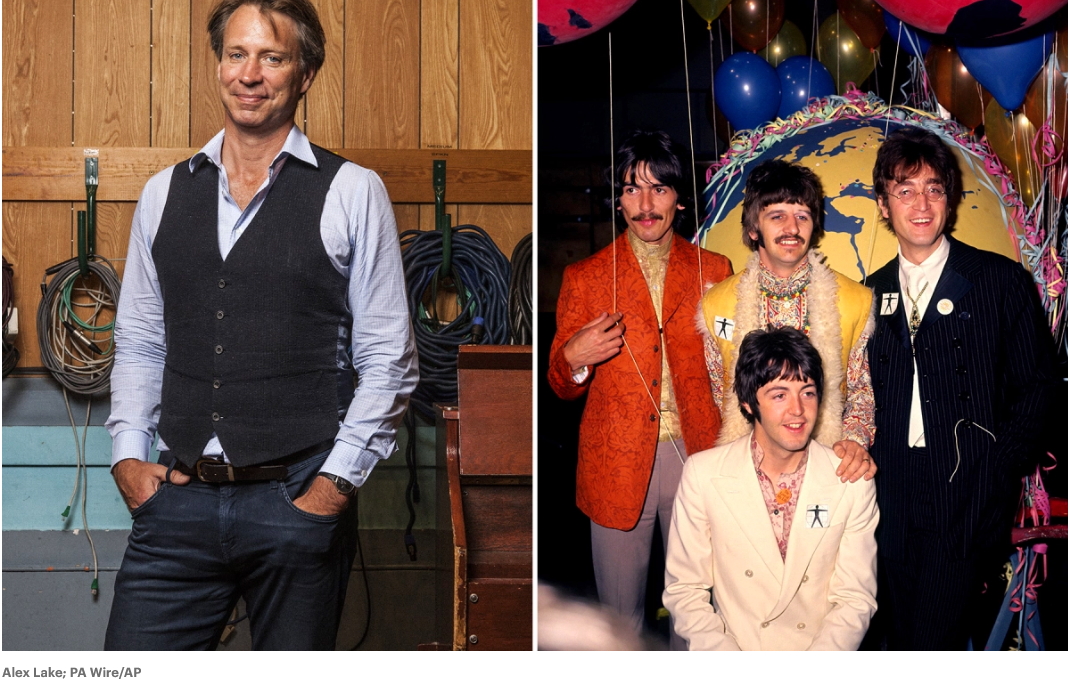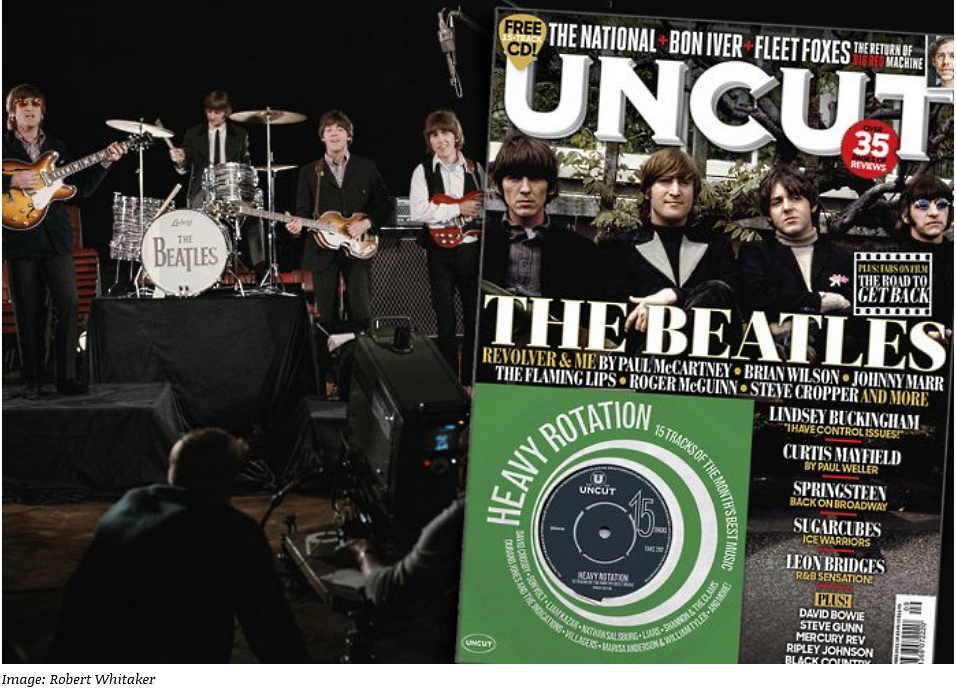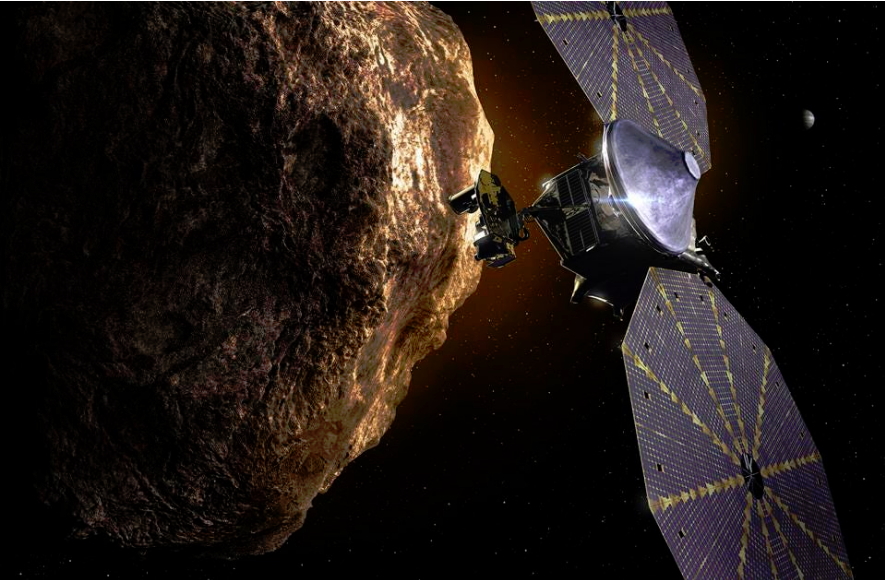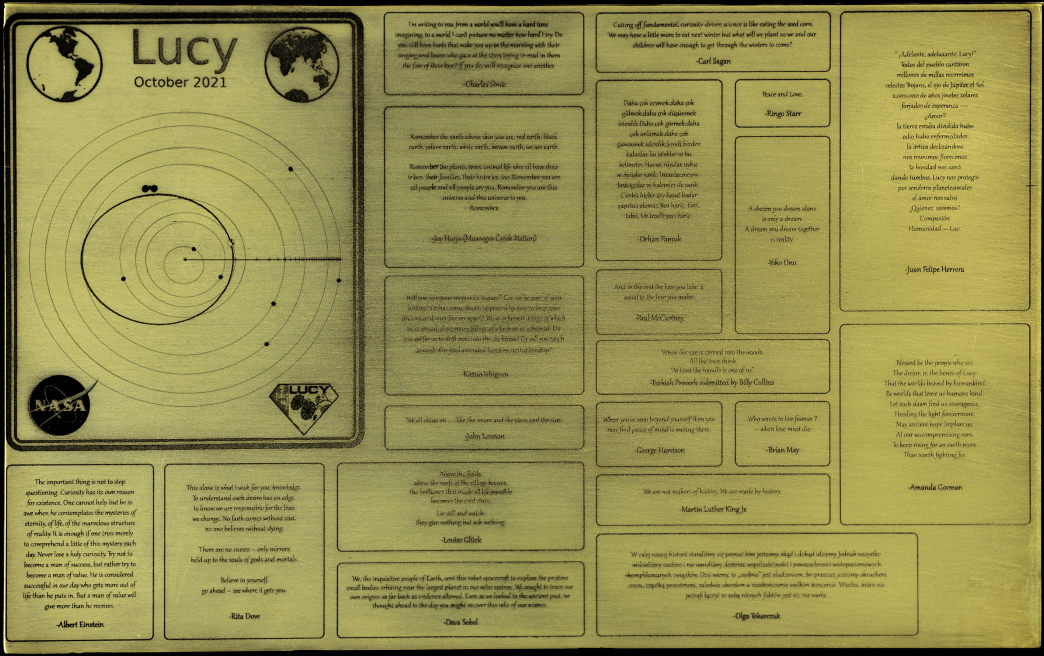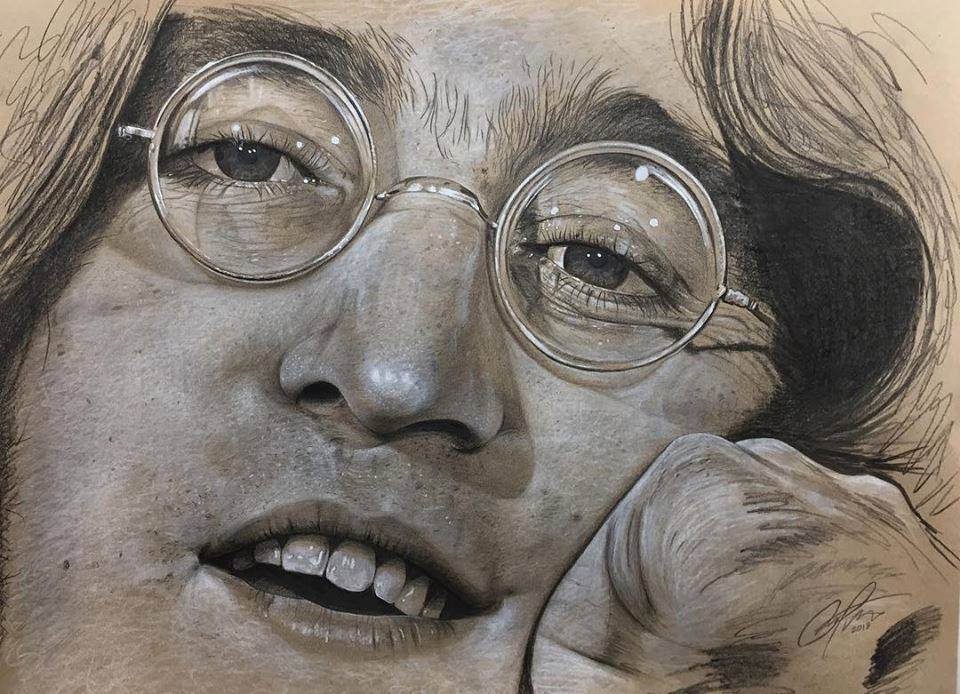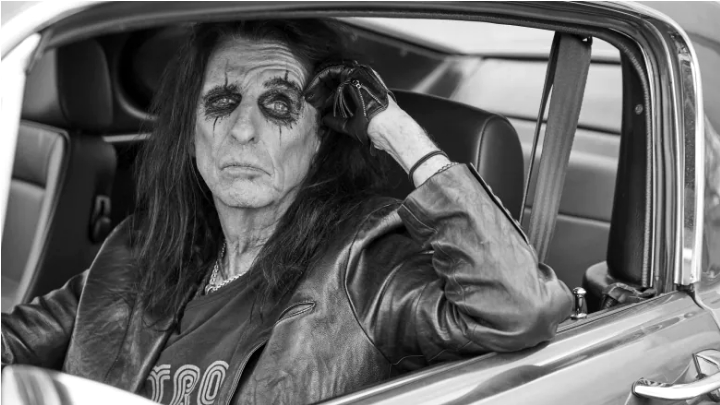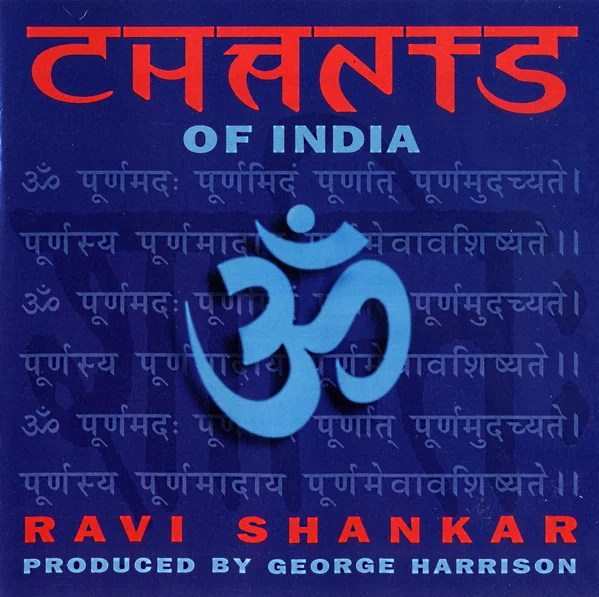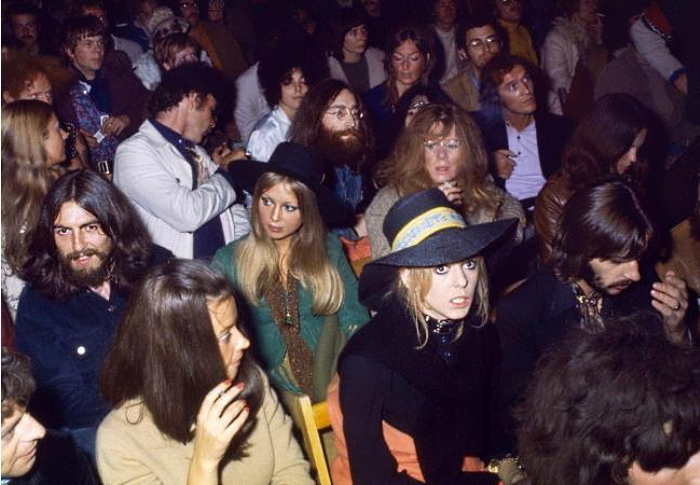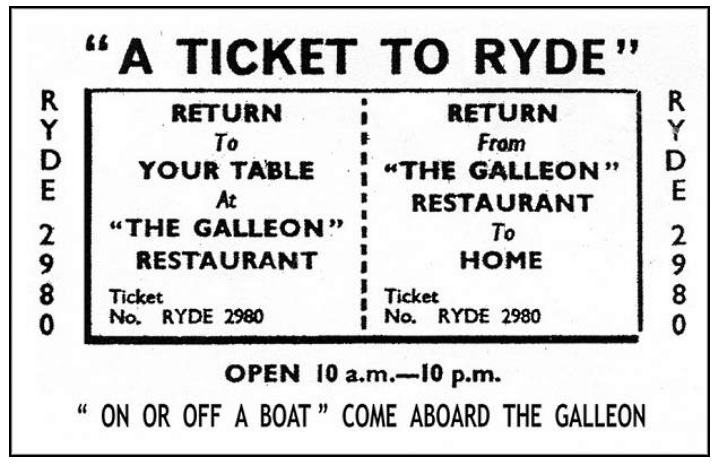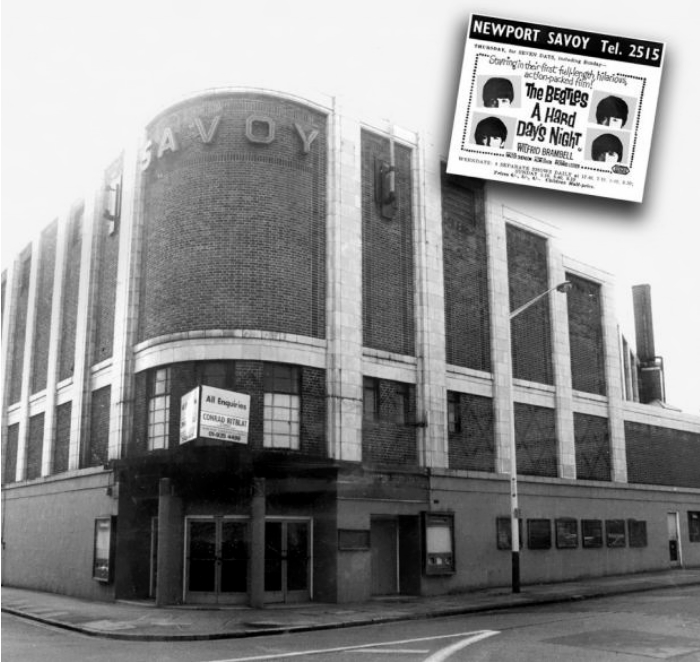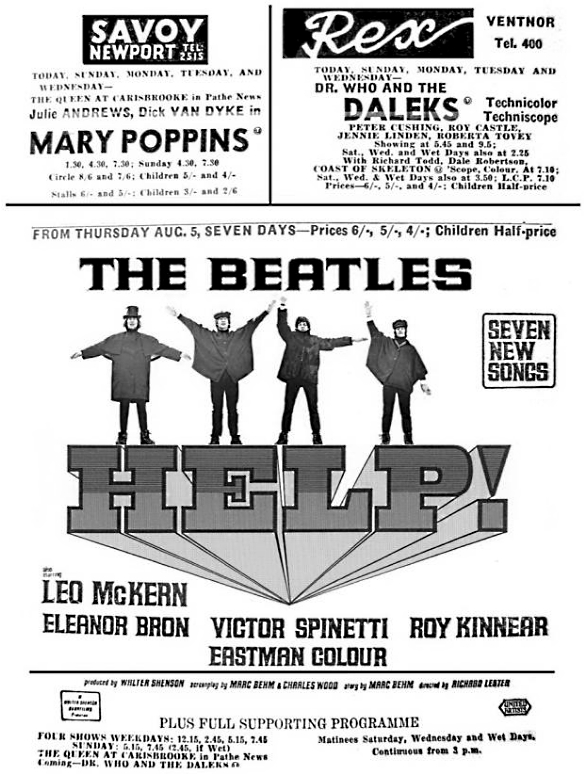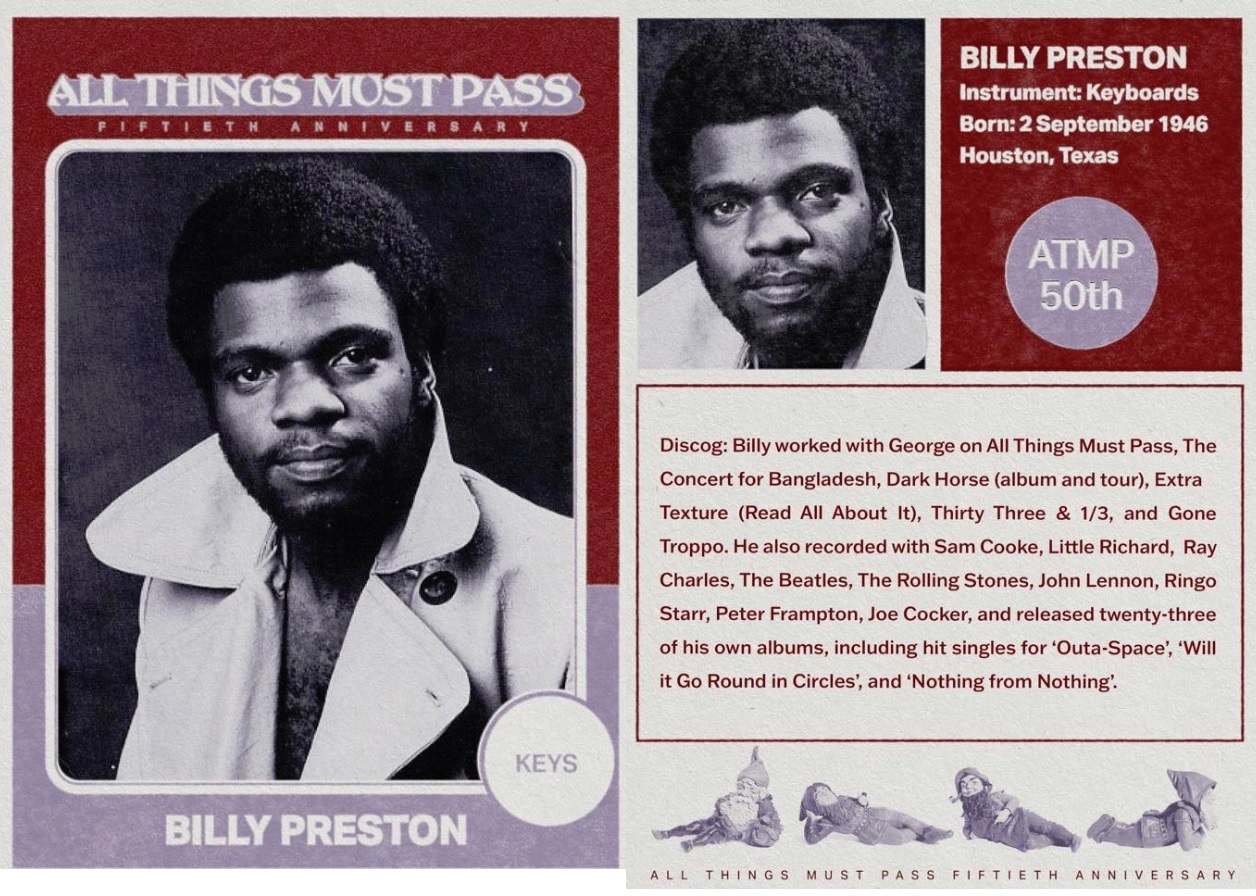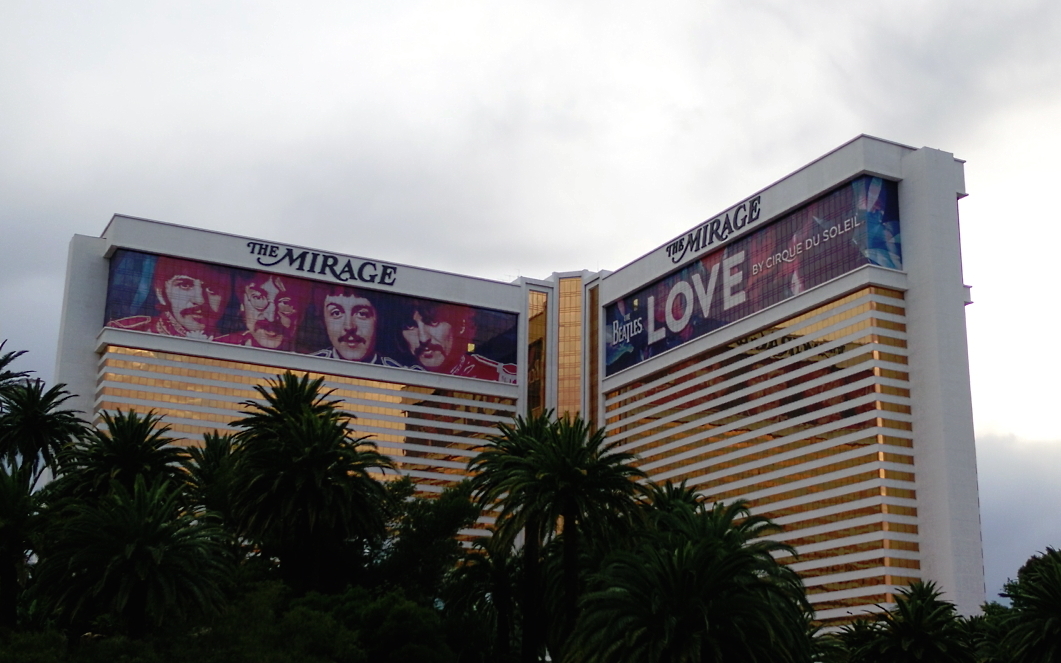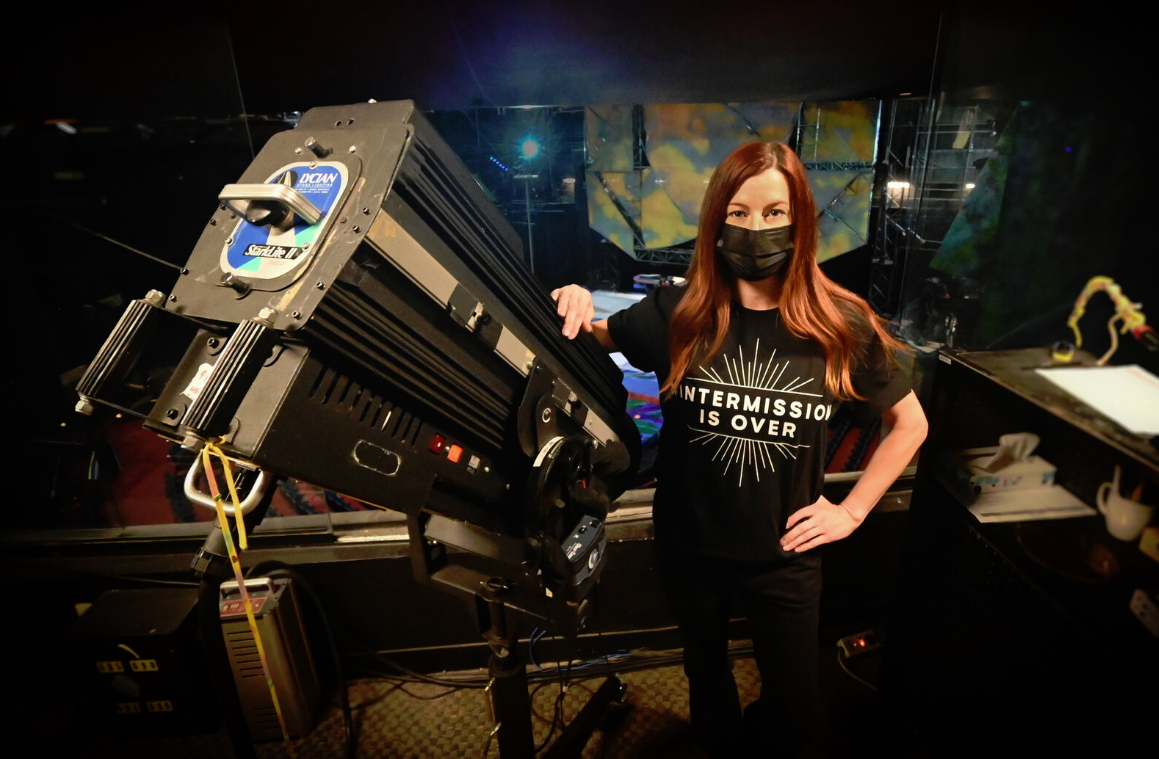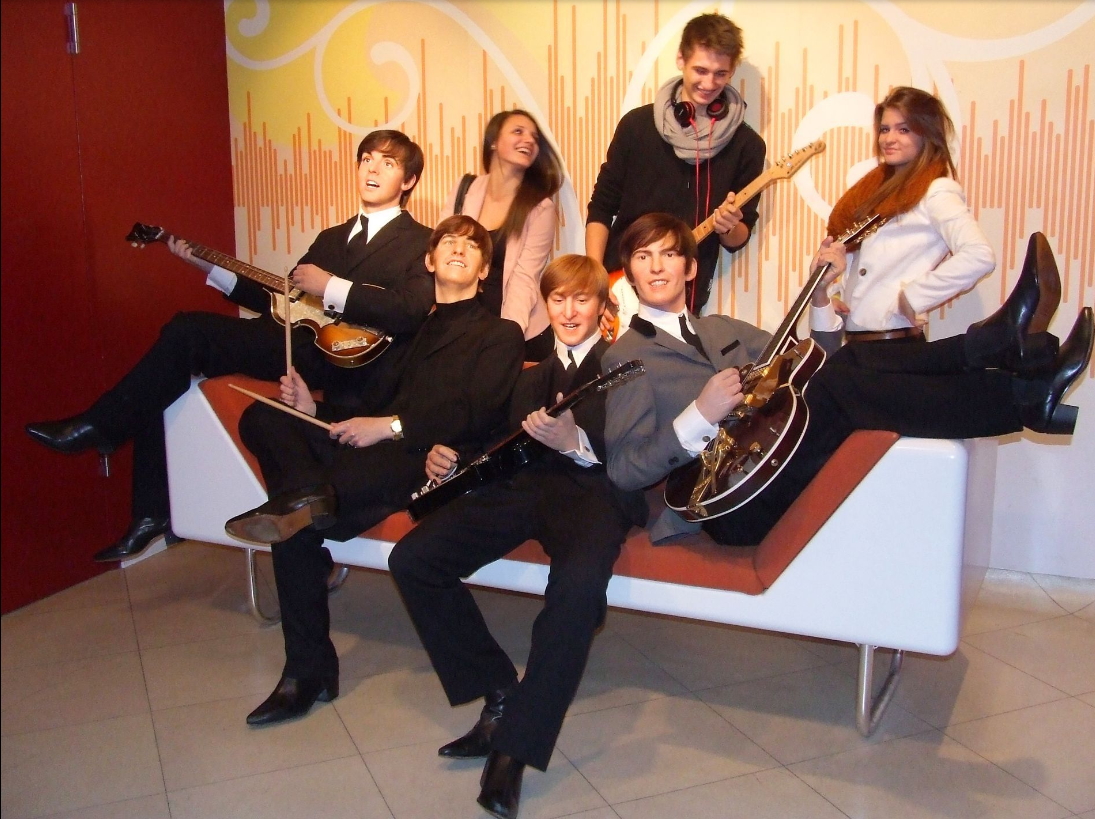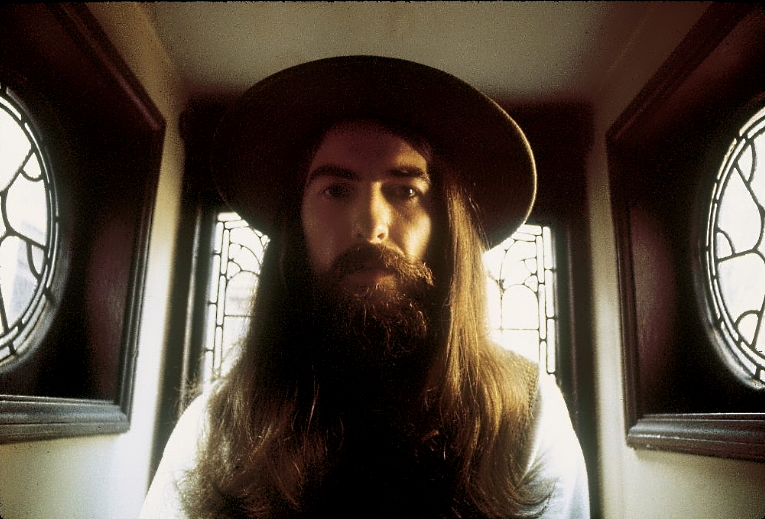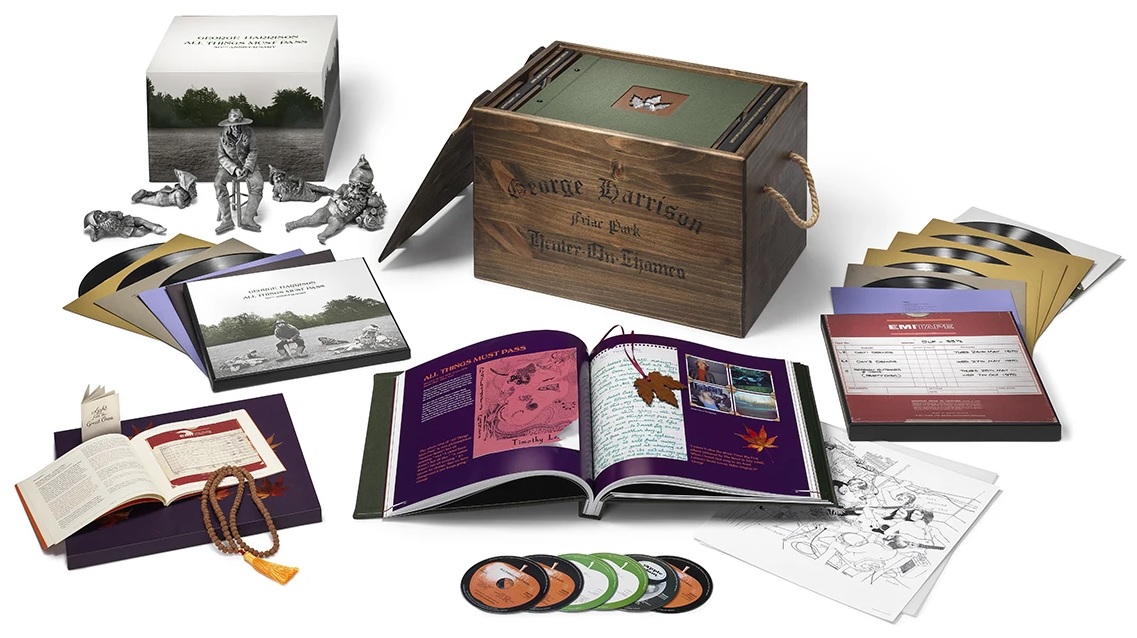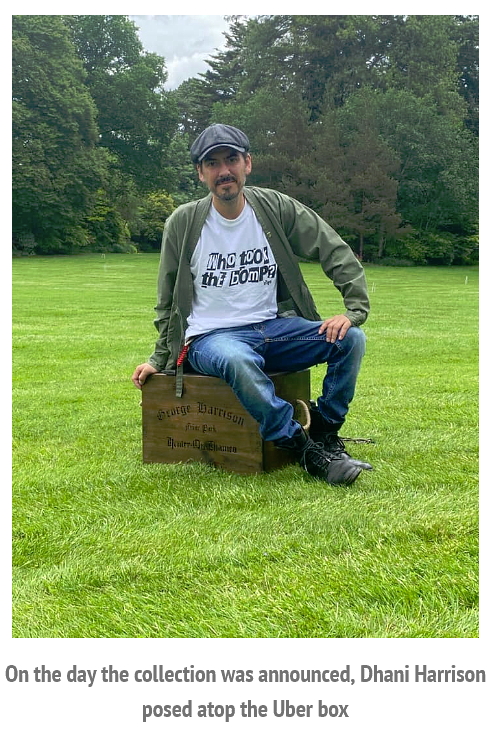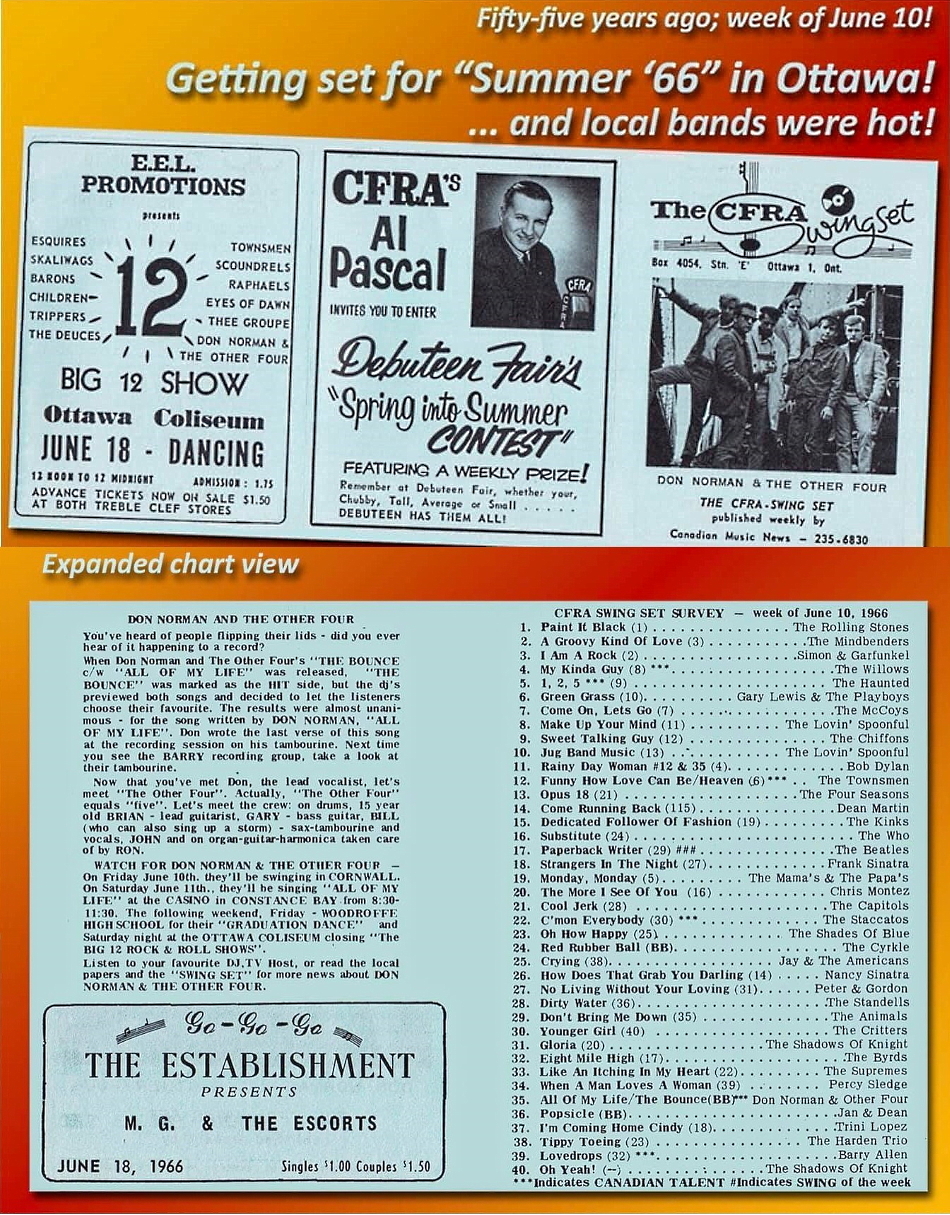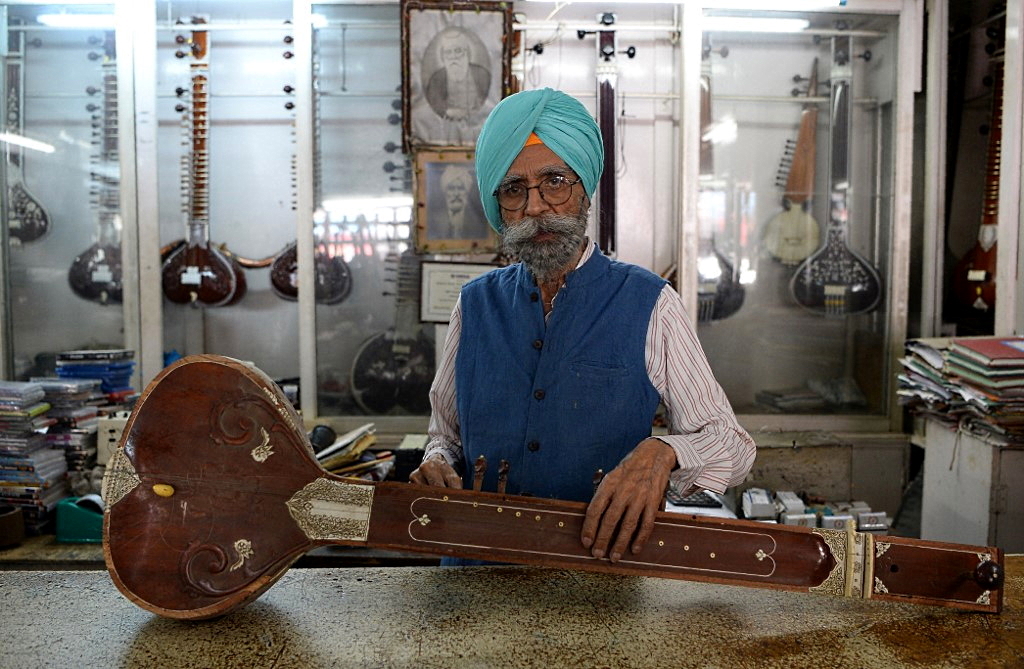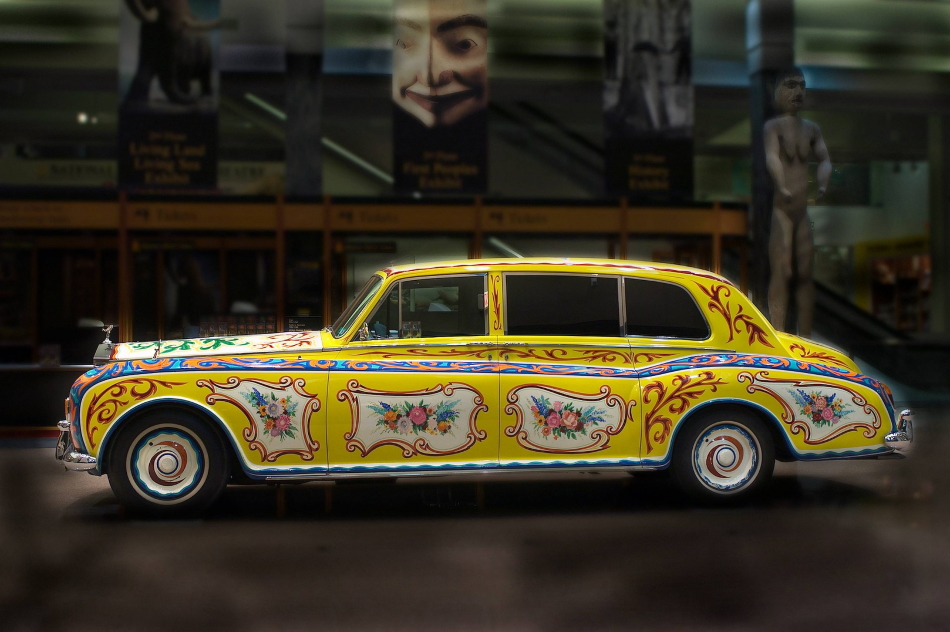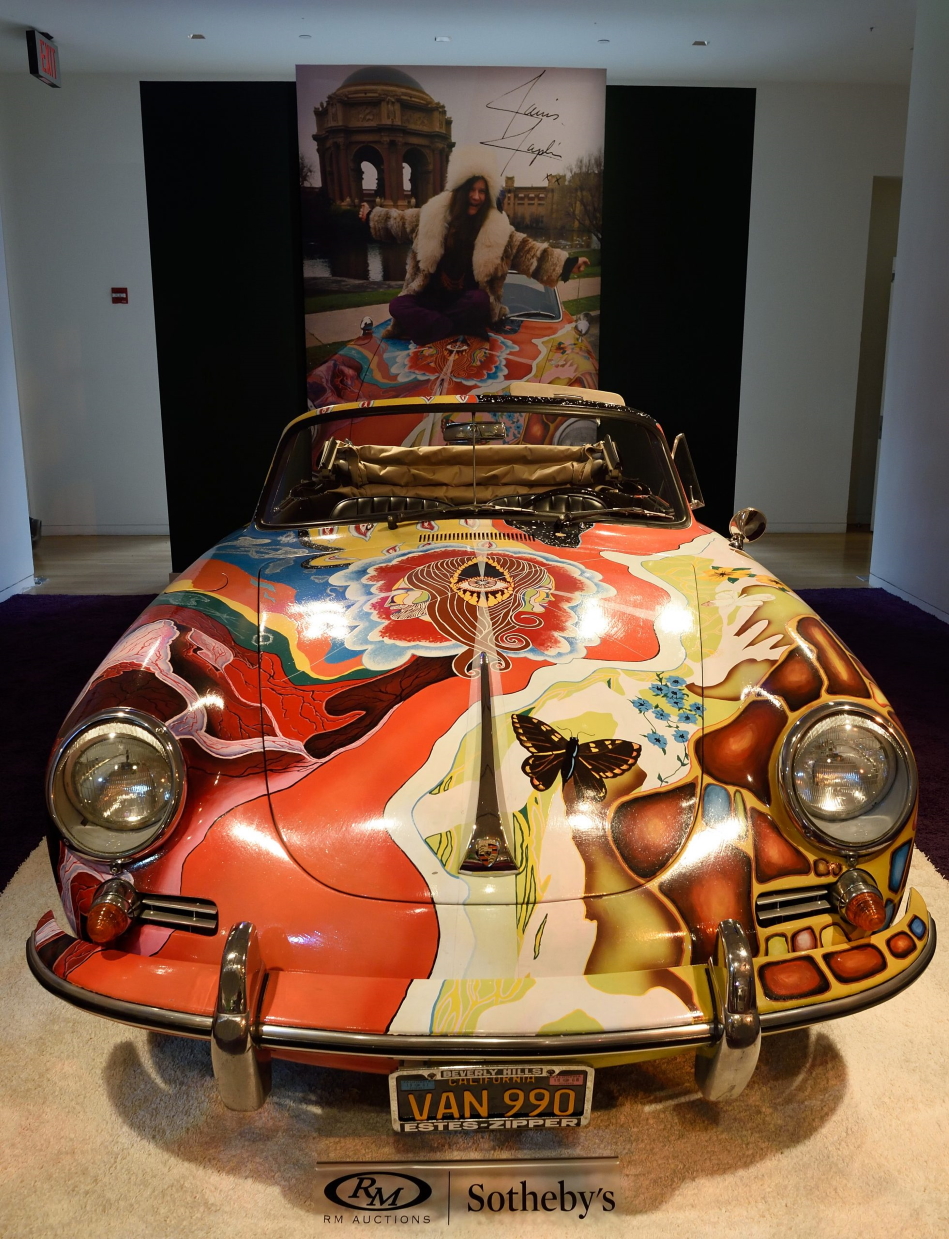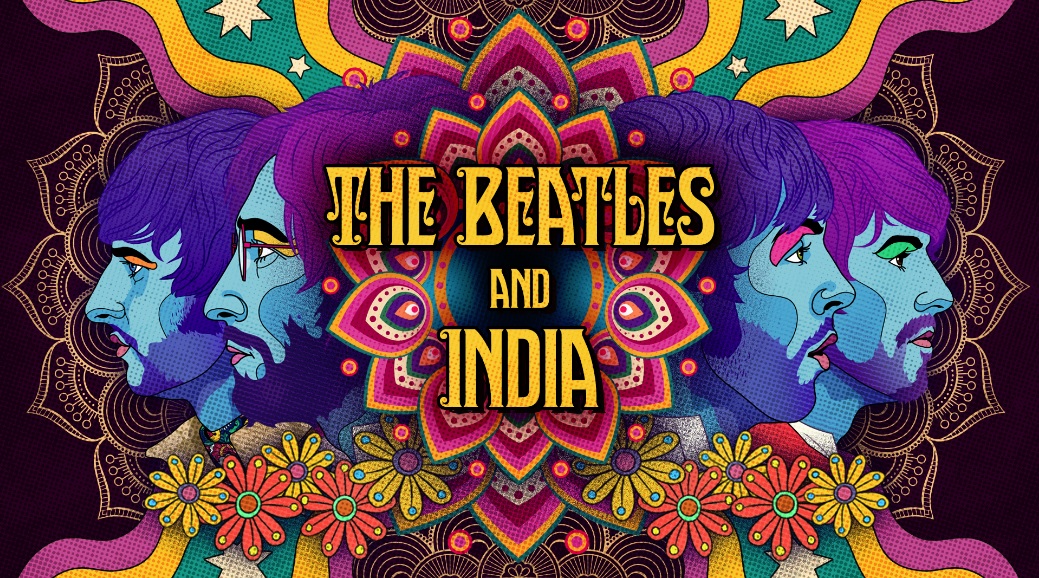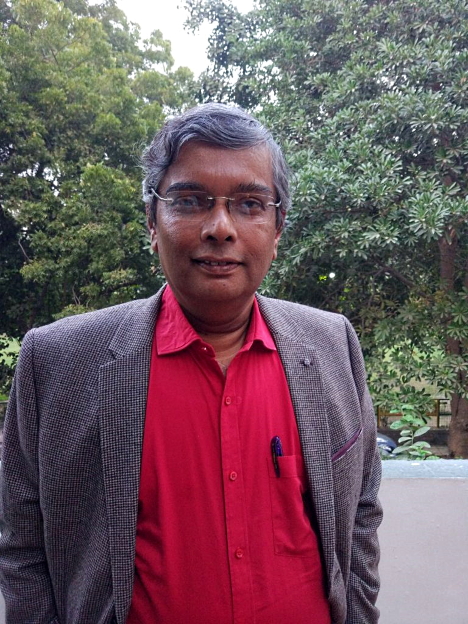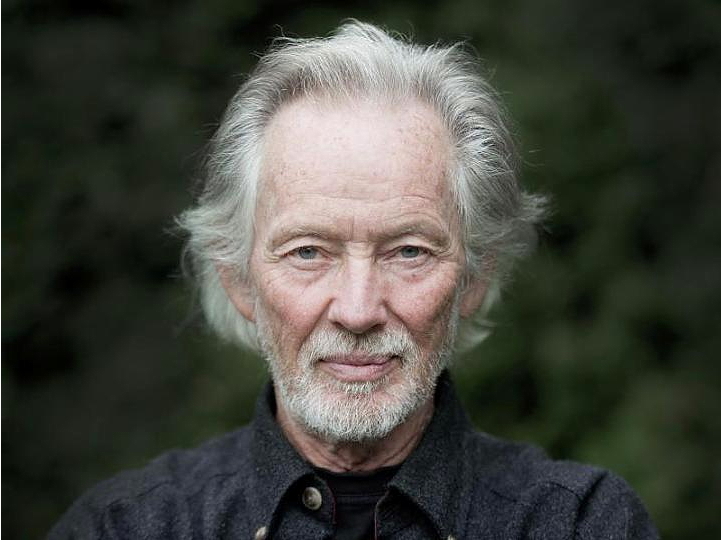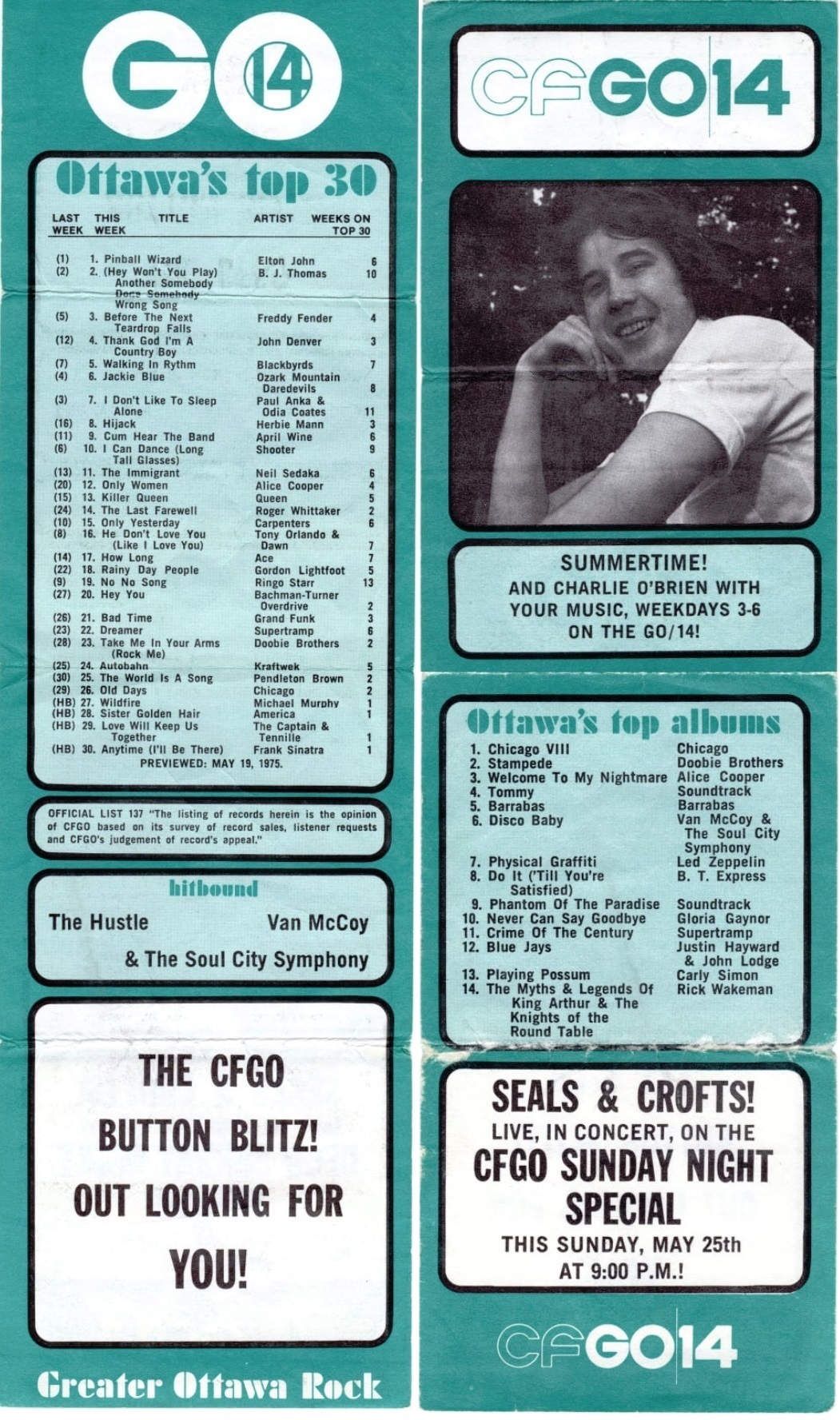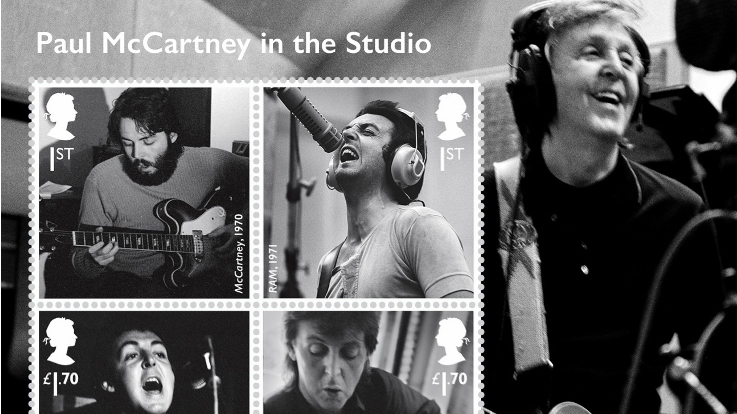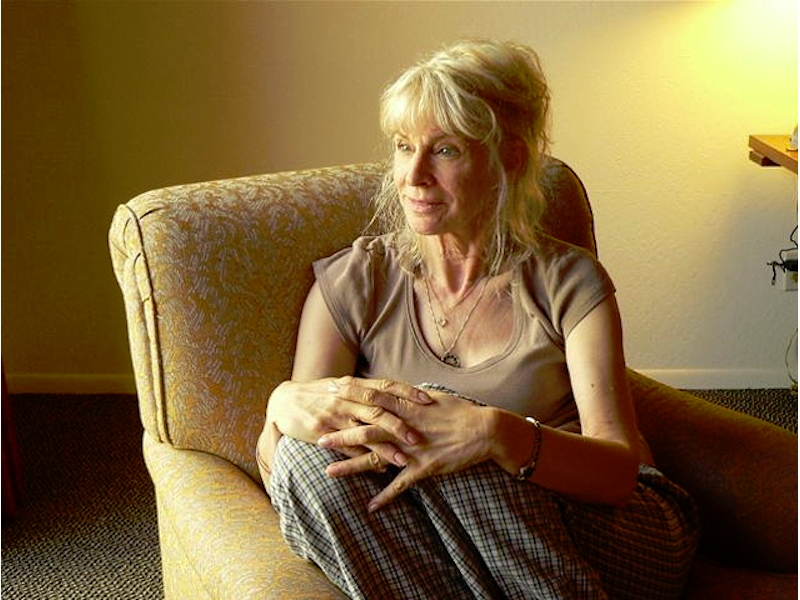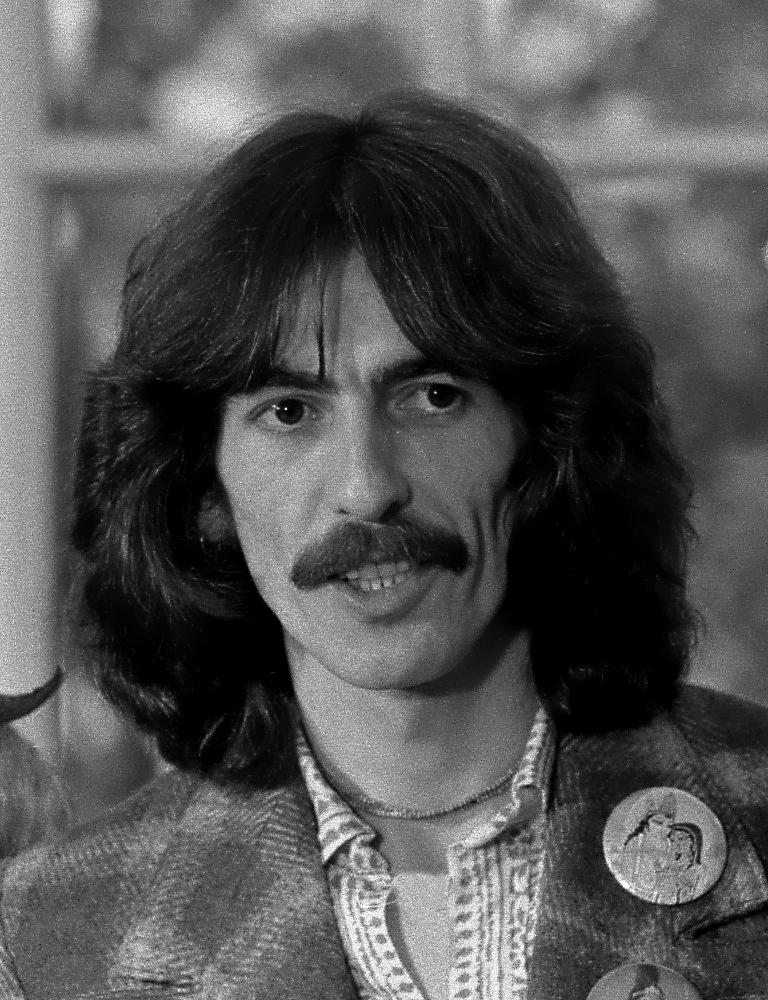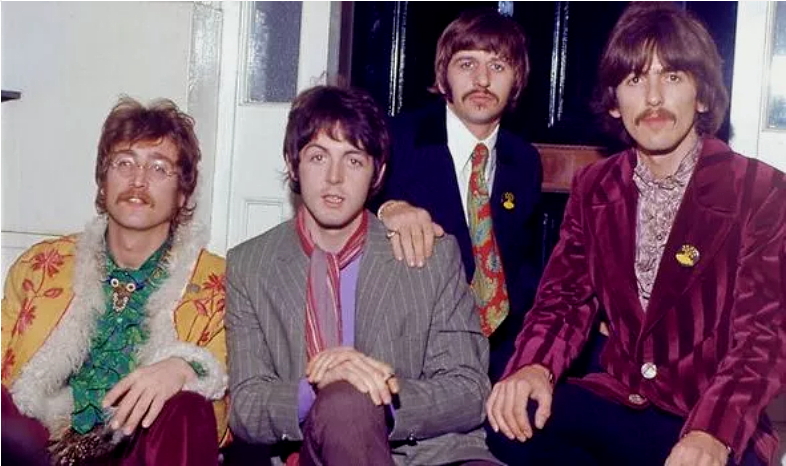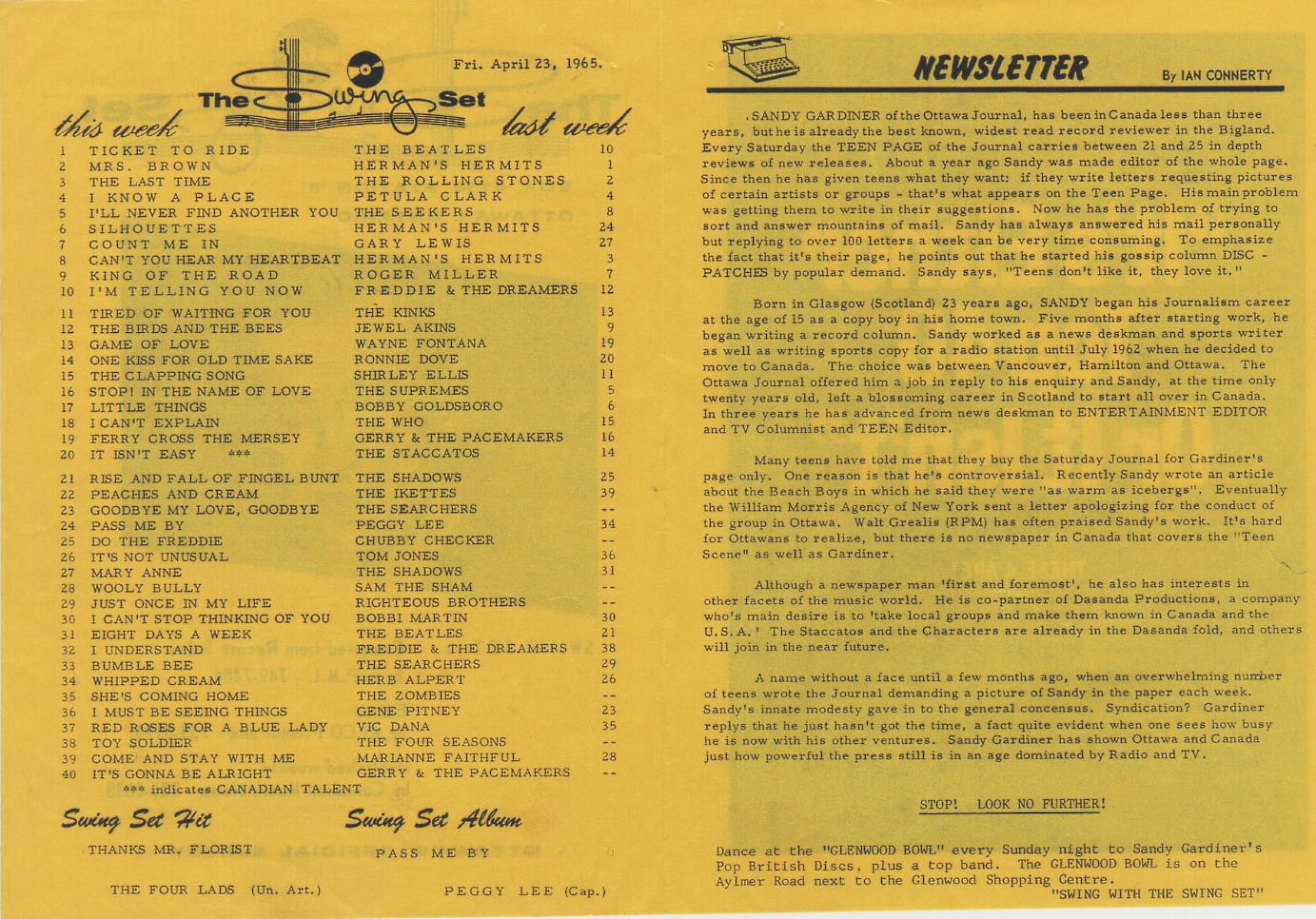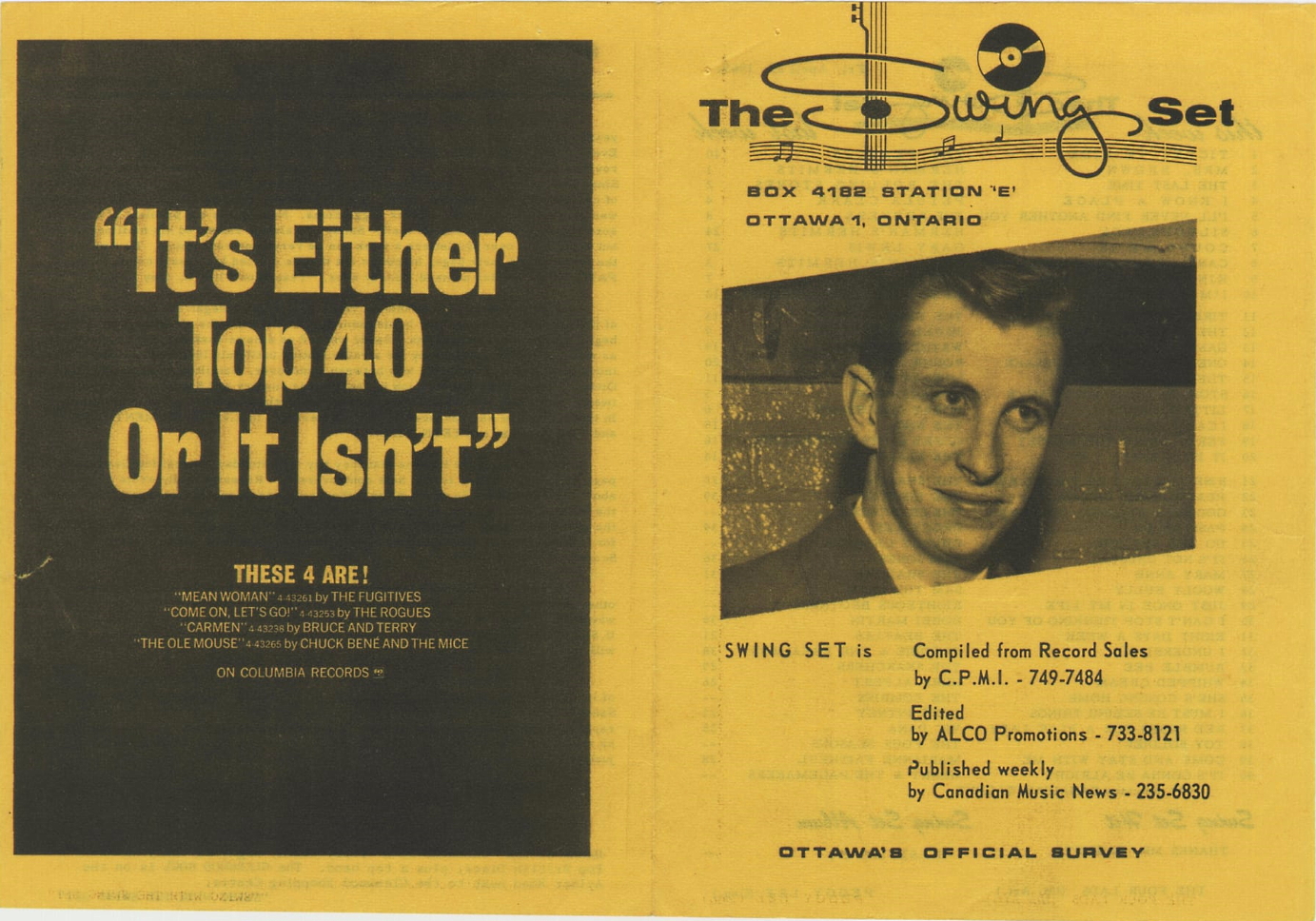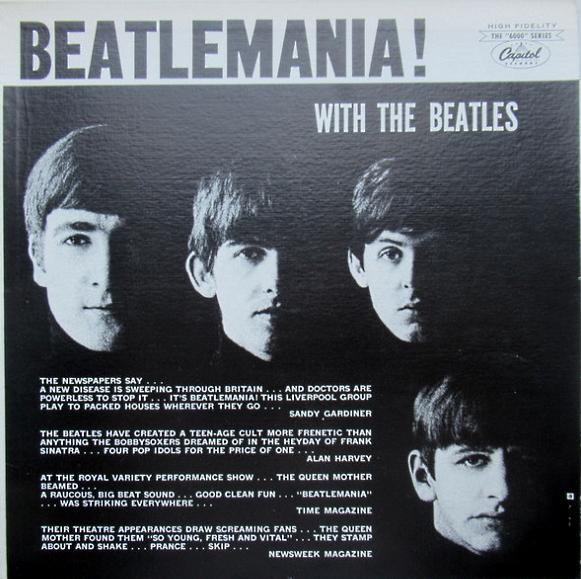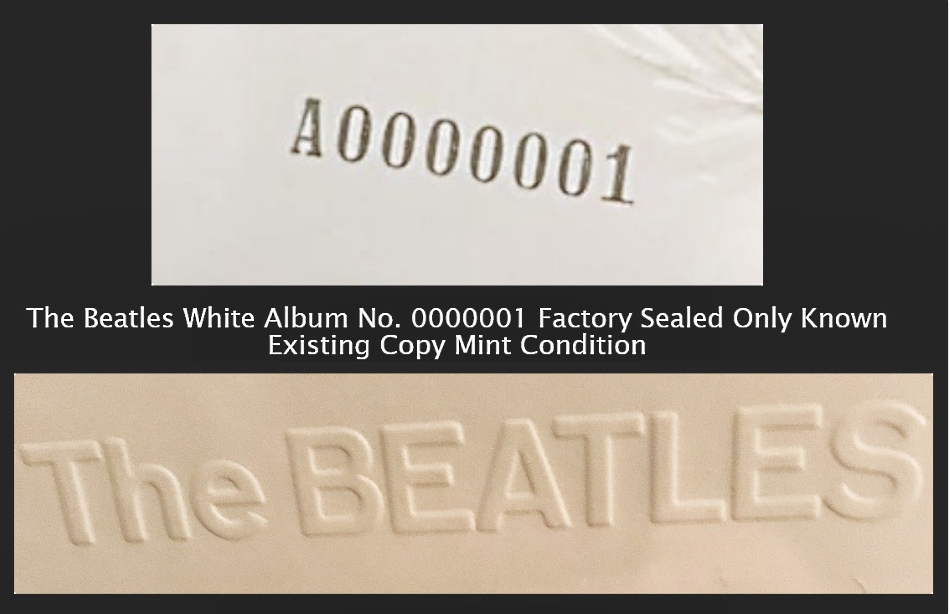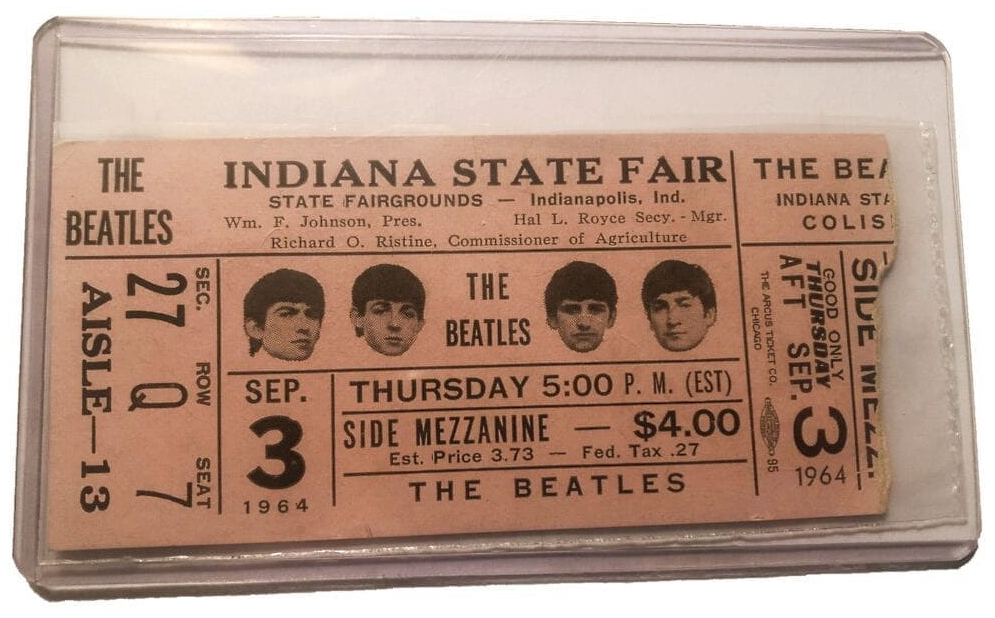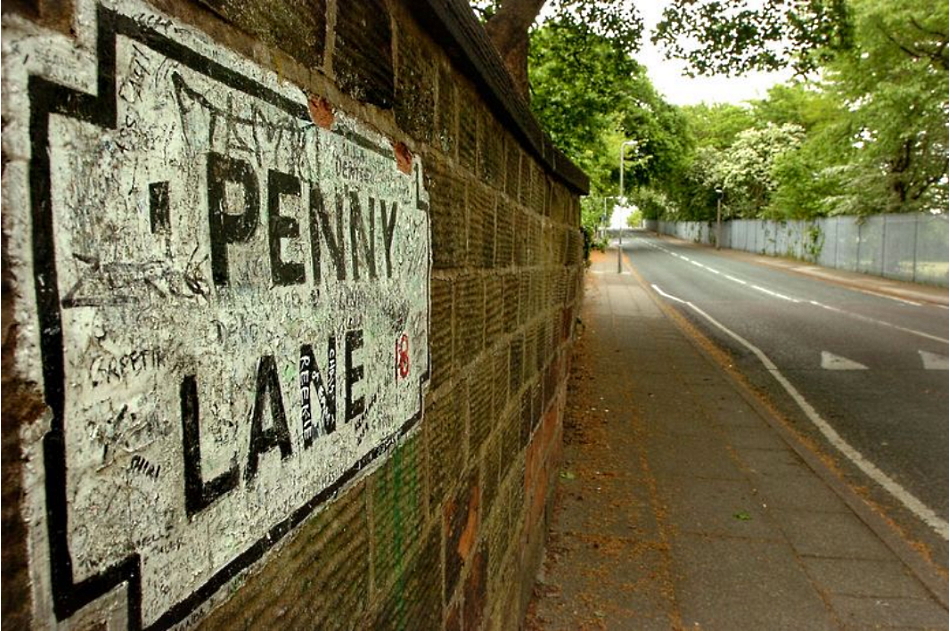|
|
||||||||||||||||||||||||||||||||||||||||||||||||||||||||||||||||||||||||||||||||||||||||||||||||||||||
|
The News Today
July 29, 2021 The Beatles in Spatial Audio: Producer Giles Martin on How It All Works ‘You’re dealing with a record that’s been around for 50 years that everyone loves, and no one’s ever said [it] sounded bad,’ says the producer. ‘So it’s a bit of a tricky job.’ by Brian Hiatt for Rolling Stone
“It’s a bit like someone you love for years having a slightly different haircut,” says Giles Martin. “And you realize you still love them.” The producer is talking about his Beatles remixes, which have been available in their most expansive form on Apple Music since June, when the service launched their Dolby Atmos-driven spatial audio feature. As more listeners than ever before encounter Martin’s Atmos mixes of Sgt. Pepper’s Lonely Hearts Club Band and Abbey Road (which happens to be one of the most impressive spatial-audio showcases from any artist), he dug into the technical marvels and challenges of three-dimensional sound, explained why the current version of Sgt. Pepper’s won’t stick around much longer, and much more. Click here to read the entire interview with Giles Martin.  July 28, 2021 In the September issue of Uncut magazine (excerpt below): Tape loops, drones and The Tibetan Book Of The Dead: Inside The Beatles’ Revolver sessions at EMI Studios It's April 6, 1966. We're in EMI Studios on Abbey Road, where tape loops, drones and mystical incantations derived from The Tibetan Book Of The Dead herald this next revolutionary phase in The Beatles’ career by Richard Williams for Uncut magazine
As they approached the making of Revolver, The Beatles couldn’t have known that they’d just enjoyed their last carefree year. In 1965, they had made Help!, played Shea Stadium and visited Elvis and the Queen. Just before Christmas, as was now their habit, their second album of the year had been released. Rubber Soul still sounds like the perfectly balanced expression of a pop band with artistic ambitions, expanding their creative range without jeopardising the relationship with their vast and adoring public. They started 1966 still shining still like a four-headed Sun King, dispensing rays of unsullied happiness. But in February, during an interview with the Evening Standard, John Lennon compared their popularity with the statistical decline in Christian worship. He was trying to say how ludicrous it seemed, but the subtlety of his point was ignored in America’s Bible Belt, where Beatles records were promptly piled up into bonfires. In July, the group released an album in America titled Yesterday And Today,, its cover showing the four of them smiling as widely as usual while holding the bloodied body parts of dolls. Another uproar forced its withdrawal. They were starting to tread on dangerous ground. Revolver arrived in August, on schedule, but it was the result of a very different creative process. Their debut album, Please Please Me, had been recorded in a single day. Rubber Soul had taken 80 hours of studio time. Revolver took 220 hours, the result of a band suddenly liberated from constant live performances and from an aborted third feature-film project. Now so successful that they were free from the imposition of studio budgets, they were able to use Abbey Road as a laboratory. Beatle fans: The entire article to read is available in the September edition of Uncut magazine.  July 27, 2021 NASA’s Next Mission Will Put ‘Lucy’ In The Sky With A Time-Capsule For Space-Faring Humans Of The Future by Jamie Carter, Senior contributor for Forbes
NASA’s next great mission will bear a plaque containing words by The Beatles and other inspirational humans in the hope that it will one day be found by astro-archeologist humans of the far future. Due to launch on a United Launch Alliance Atlas V rocket from Florida on October 16, 2021, “Lucy” will be the first-ever mission to explore what are known as the “Trojan” asteroids. These small objects that orbit the Sun in two clumps, some in front of Jupiter and some behind it (so often called “Jupiter's children”), are considered to be primeval leftovers—fossils—from the formation and evolution of the planets and the Solar System. Hence the name of NASA’s $1 billion mission to study eight of them. The Lucy spacecraft is named after the fossilized human ancestor discovered in Afar, Ethiopia in 1974. The skeleton was discovered in sediment known to be 3.2 million years old. It was found by Donald Johanson, a paleoanthropologist, who played a Beatles cassette that night at camp including the song “Lucy in the Sky with Diamonds.” So Johanson decided to name the skeleton Lucy.
NASA’s identically-named spacecraft will orbit the Sun six times on its mission, but ultimately travel between the Trojan asteroids and the orbit of the Earth for millions of years. So, obviously, it needs a plaque. After all, NASA’s Pioneer 10 and 11 have plaques, and its Voyager 1 and 2 have “golden records.” However, while those interstellar spacecraft are taking messages outside our Solar System, Lucy’s plaque will be a time-capsule containing messages not for aliens, but for our descendants. It’s hoped that humans of the future traveling among the planets will retrieve Lucy and discover that it’s an artifact of the days when humanity took its first steps to explore the Solar System. Installed earlier this month on the Lucy spacecraft at Lockheed Martin Space in Littleton, Colorado, the time-capsule contains messages from the likes of Albert Einstein, Carl Sagan, Martin Luther King Jr. and all four members of The Beatles: ● George Harrison: “When you’ve seen beyond yourself then you may find peace of mind is waiting there.” ● John Lennon: “We all shine on . . . like the moon and the stars and the sun.” ● Sir Paul McCartney: “And in the end the love you take is equal to the love you make.” ● Sir Ringo Starr: “Peace and Love.” The plaque also includes an image of the Solar System on the day of Lucy's anticipated launch, as well as its trajectory. Wishing you clear skies and wide eyes.
 July 26, 2021br Why we love to hate Imagine John Lennon's nakedly idealist hymn is very easy to deride by Dorian Lynskey for The Post
John Lennon’s Imagine has appeared at more Olympic games than most athletes. Having featured in the Summer Olympics in 1996 and 2012 and the Winter Olympics in 2006 and 2018, it was back once again at Tokyo’s opening ceremony, pperformed by a digital global supergroup and a children’s choir. “If the games were a song, Imagine would be the song,” said one organiser of a tune whose message (“Imagine there’s no countries”) would theoretically put paid to the whole event. This was a considerable improvement on Imagine’s last prominent public outing. In March 2020, Wonder Woman star Gal Gadot decided to cheer up everybody on lockdown by asking 26 of her celebrity pals to film themselves singing a line, irrespective of their ability to hold a tune. The a cappella montage did at least provide the most terrifying phase of the pandemic with a shared moment of unintentional hilarity and a lasting monument to the hubris of well-meaning celebrities with nothing to do. One guilty participant, the actor Chris O’Dowd, put it down to “that first wave of creative diarrhoea that seemed to encase the entire world”. Of course, Gadot had to choose Imagine. Imagine, which turns 50 in September, occupies a unique place in our culture. When the song’s producer, Phil Spector, first heard it, he thought it was “like the national anthem”; but like Spector’s reputation, that assessment has proved complicated to say the least. While some regard it as beautiful and profound, or at least unifyingly inoffensive, others damn it as a sanctimonious monstrosity. It was voted the UK’s favourite song lyric in 1999, the best single of all time in 2001, and the greatest song ever in 2004. Yet it has also been named as the worst song in the world so often that to despise it has become a cliché. “I am hardly the first writer to dislike Imagine,” wrote the critic Tom Ewing. “In fact, the laurels on the comment thread are likely to go to anyone who can make a really good case for its beauty, wisdom or excellence.” This cannot be put down to just its chronic overfamiliarity. Other played-to-death songs such as Hey Jude or Bohemian Rhapsody aren’t nearly as divisive. So what is it about Imagine that drives so many people crazy? It is annoying that Imagine has been used to caricature a painfully complicated man as a gentle saint, so it’s essential to understand where Lennon’s head was at when he recorded the song in his home studio in Tittenhurst Park, Berkshire in May 1971. His experience of Arthur Janov’s primal scream therapy had enabled him to let go of the “father-figure trip”, he said. “Facing up to reality instead of always looking for some kind of heaven.” At the same time, Lennon and his wife Yoko Ono were in the throes of political radicalisation. In 1968, he had written the Beatles’ Revolution, which told the counterculture to steady on there and drop the pictures of Mao. By the end of 1970, he was telling Rolling Stone: “I really thought that love will save us all. But now I’m wearing a Chairman Mao badge, that’s where it’s at.” Shortly after an interview with Tariq Ali and Robin Blackburn for the Trotskyist magazine Red Mole in January 1971, he wrote a new song based on their conversation. Combining socialism and feminism with a Black Panther slogan, Power to the People flipped the ambivalent opening line of Revolution into a call to arms: “Say you want a revolution/ We better get on right away.” The US New Left magazine Ramparts republished the interviewunder the headline “The Working Class Hero Turns Red”. Lennon saw Imagine as a different kind of revolution. The black comedian and activist Dick Gregory had given him a book of positive prayer, which Lennon explained to Playboy in 1980 like so: “If you can imagine a world at peace, with no denominations of religion — not without religion but without this my-God-is-bigger-than-your-God thing — then it can be true.” Imagine, therefore, is protest rewritten as a secular prayer. The idea chimed with Ono’s “instruction paintings”, collected in her 1964 book Grapefruit, each of which began “Imagine…” Lennon later said that Imagine should have been credited to Lennon/Ono because “it was right out of Grapefruit” and her name was finally added in 2017.
The Yoko factor turns a lot of people off. While a song like Working Class Hero draws its political power from Lennon’s distinctive flinty sarcasm, Imagine is driven by Ono’s utopian whimsicality. It’s of a piece with the couple’s subsequent billboard campaign, “War is over! If you want it.” The idea that you can simply will a better world into being can seem like iimpotent New Age guff but the New Left’s philosopher-in-chief Herbert Marcuse was then arguing that imagining radical change was the essential first step towards realising it. The critic Robert Christgau acutely observed that Imagine was “both a hymn for the Movement and a love song for his wife, celebrating a Yokoism and a Marcusianism simultaneously”. People who find Imagine about as deep as a Keep Calm and Carry On poster might be surprised by how seriously contemporary critics took it, but it is a startlingly radical lyric wrapped in a musical comfort blanket. Running from the myth of Beatle John, Lennon was desperate to shed every form of baggage, and Imagine magnifies this process of renunciation to global proportions. Like Gimme Some Truth, God or Give Peace a Chance, it is a list of things to reject. The first verse scraps heaven and hell; the second bins nations, religions and war; and the third abolishes possessions and poverty. As the chorus acknowledges (“You may say I’m a dreamer”), that’s a lot for one song to ask for. Its haters are divided between those who consider this prospectus anodyne drivel and those who find its picture of a godless, classless, borderless world “a vision of hell”, as one writer put it. Lennon told the NME that it was “anti-religious, anti-nationalistic, anti-conventional, anti-capitalistic, virtually the Communist Manifesto, even though I’m not particularly a Communist and I do not belong to any movement”. He preferred “a nice British socialism” to “the way some daft Russian might do it”. “Imagine no religion” angered the kind of people who had still not forgiven Lennon for saying the Beatles were more popular than Jesus but it was “Imagine no possessions” that became the main bone of contention. “Was it a millionaire who said imagine no possessions?” sang Elvis Costello in his 1991 single The Other Side of Summer. Lennon himself realised that he’d misjudged the next line, tweaking the inadvertently condescending “I wonder if you can” to “I wonder if we can” in at least one performance. The visuals don’t help his case. Lennon decided to film the making of the album and a clip from the movie — John playing his white baby grand piano in his big white mansion — became the music video for Imagine. He should have anticipated that this tableau of smug luxury would sit uneasily with the third verse, but to be fair to him, he was at the time very happy to play benefit concerts and give money to all kinds of causes, including two of the Chicago Seven defendants, Biafran refugees and Clydeside shipbuilders, one of whom misheard the name of the donor and shouted out, “But Lenin’s dead!” I’m not convinced that it’s inherently hypocritical for a rich man to imagine a different world, given that anyone who has a big enough platform to spread such a message is almost inevitably wealthy. Still, one has to love the card that Elton John sent to the couple at their extravagant home in Manhattan’s Dakota Building: “Imagine six apartments/ It isn’t hard to do/ One is full of fur coats/ Another’s full of shoes.” By the time they moved into the Dakota in 1973, Lennon’s revolutionary phase had flamed out. Lennon biographer John Wiener argues that Imagine “seemed to many [protest] movement people a hymn to the New Left in defeat”. Not long after the hot mess of Lennon’s 1972 protest album Some Time in New York City, Richard Nixon won reelection in a landslide and Lennon made a brisk, bitter retreat from politics. The FBI, which had been monitoring him as a potentially dangerous radical, closed its file. It seems remarkable now that when it was released as a single in the US, Imagine hung around the charts for no longer than Power to the People had done and was outperformed by Paul McCartney’s amiable Uncle Albert/Admiral Halsey. It didn’t come out in the UK until 1975, when it peaked at number six. McCartney angered his estranged friend by telling Melody Maker that he liked Imagine because it wasn’t as political as John’s recent stuff. Lennon shot back with a furious letter: “So you think Imagine ain’t political? It’s Working Class Hero with sugar on it for conservatives like yourself!! You obviously didn’t dig the words. Imagine!” It’s the sugar that makes the song so portable. It may have the most comprehensive agenda of any hit single ever made but Imagine sounds modest, tentative and unassuming. On a compositional level, it is almost childishly simple. (You can hear an instrumental scrap of it, called John’s Piano Piece, in outtakes from the Beatles’ 1969 Let It Be sessions.) The basic track was recorded in less than half an hour (they used the second of three takes) and the subsequent string arrangement was extraordinarily restrained for a Spector production. The Tokyo version, orchestrated by Hans Zimmer, is far too grandiose; a thought experiment should not be oversold. Imagine, therefore, lends itself to occasions when something hopeful but not overbearing is required. After Lennon was murdered in 1980, the song topped the UK charts for four weeks but its suitability for mourning is much broader than that. Stevie Wonder performed it in 1996 in honour of the victims of a terrorist bombing during the games, Neil Young reached for it at a 9/11 tribute concert and Madonna chose it to remember those who died in the 2004 tsunami. As Slate’s Katy Waldman wrote when it again became a song of grieving after the assault on the Bataclan in Paris in 2015, “No one who has just watched footage of families mourning their loved ones in the wake of a terrorist attack is ready to swallow a dose of unalloyed affirmation. The song seems veined with the sad understanding that its own dream is too simple.” Yet at the same time, Imagine still carries enough of a residual political charge to have been banned by the BBC during the first Gulf War and (briefly) by the US radio network Clear Channel after 9/11. At the end of 2001, Rolling Stone called it “a new national hymn, a strong, quiet counterweight to the institutional psalms and fight songs… that have filled the air since the terrorist attacks.” Former President Jimmy Carter told NPR that on his travels around the world, he heard it “used almost equally with national anthems”. Imagine is rather like a tourist attraction in your hometown: you’re so used to seeing it in the background that you forget why it’s remarkable. To be honest, I need never hear it again but I’ve warmed to it in recent years precisely because its naked idealism is so very uncool and so easy to deride. There has never been a song like it and it would take a supernatural blend of talent, ego and idealism for anyone to even attempt one. Can you imagine what Twitter would do if, say, Chris Martin tried it? Unless I am seriously underestimating the global appetite for utopian socialism, most listeners are not embracing it on a literal level as a time-capsule of Lennon and Ono’s post-Sixties art-school radicalism. As Rage Against the Machine’s Tom Morello has said “If people really believed the sentiments John Lennon expressed in that song, we would have had revolution in this country a long time ago.” It has become instead a generous vessel for all kinds of aspirations, both big and small. Three years ago, the Observer asked Ono what the word “imagine” meant to her and she replied simply: “To think of something to hope for.” You may say I’m a sucker but I find that idea hard to hate.  July 24, 2021 What would John Lennon say today about Alice Cooper's new release "Detroit City 2021" ?
Alice Cooper on new album Detroit Stories and why rock 'n' roll isn't dead Cooper’s new album pays tribute to the Detroit hard rock scene of the ‘60s and ‘70s by the CBC Radio · Posted: Jul 22, 2021 3:42 PM ET When Alice Cooper and his longtime producer Bob Ezrin set out to create their latest hard rock album, they knew there was only one place to go. "The only place you can do a really good hard rock record is Detroit," Cooper told host Tom Power in an interview on CBC Radio's Q. "That's the home of hard rock." Cooper was born and partly raised in Detroit, but his family moved to Phoenix, Ariz., when he was in his early teens. His new album, Detroit Stories, is a return to his Motor City roots. It pays tribute to the city's hard rock scene of the '60s and '70s, and features an array of fellow Detroit musicians, including the MC5's Wayne Kramer and Johnny Bee of Mitch Ryder and the Detroit Wheels. "These two guys are Detroit," said Cooper. Detroit's long-lost son After graduating high school, Cooper and his band signed with Frank Zappa's record label in Los Angeles, but they struggled to connect with California crowds who found them to be too dark and menacing. In 1970, they decamped to Detroit, where they landed in the middle of a hard rock explosion that included the likes of the MC5, the Stooges and the Bob Seger System. "We didn't fit into L.A., didn't fit into San Francisco — didn't fit in. We fit in kind of in New York in the underground," said the legendary rocker. "But as soon as we hit Detroit … and I saw the Stooges and MC5, I went, 'Oh my gosh, competition.'" Cooper said it was the first time he'd ever seen an act that could compete with his band and its theatrical shock rock stage shows. The Stooges, in particular, were known for being wild on stage, as lead singer Iggy Pop would sometimes perform with a vacuum cleaner as a musical instrument or smear himself with peanut butter in front of the audience. "There's this guy with no shirt on — barely anything on — walking on the hands of the audience and he's covered with peanut butter," remembered Cooper with a chuckle. "And I'm going, 'OK, the gauntlet has just been thrown down.'" The School's Out singer said there were many who wished for a feud between him and Iggy Pop or him and David Bowie, but no such feud ever existed. He supported his fellow musicians and respected their artistry. "I just saw it was a whole brand new way of presenting rock 'n' roll," he explained. Likewise, when the Stooges and the MC5 met Cooper for the first time, they didn't see him as an outsider encroaching on their music scene. Rather, they treated him as a "long-lost son" of Detroit. The Alice Cooper band was uniquely appreciated in the Motor City, where audiences "want you to bring it and knock their faces off," as Cooper puts it. Unlike their Californian counterparts, Detroit audiences understood that the rocker's over-the-top stage persona was a part of the show. "There was this character that was menacing, I mean, truly menacing," said Cooper. "This Alice Cooper character looked like, you know, he could be a serial killer. And the audience immediately got not just the drama and the power, they got the comedy behind it. There was a certain amount of humour in what we were doing." By 1971, the band rose to fame with their first major-label album, Love It to Death, which included the hit single I'm Eighteen. The album was recorded in Detroit and owed much of its success to the city's influence. "It was the greatest hard rock scene anywhere," recalled Cooper.
The future of hard rock While this year marks 50 years since the release of Love It to Death, Cooper said the anniversary had nothing to do with the making of Detroit Stories. He didn't even know about the milestone until someone mentioned it to him. "I think it was just time to really do a hard rock album," he told Power. "We're coming out of the pandemic and everybody's kind of in a lull. I said, 'Let's just do a hard rock album that's just gonna blister everybody,' you know? And I think it was time for the album." When it comes to the current decline of hard rock on the pop charts (which has sparked artists like Gene Simmons to declare that rock 'n' roll is dead), Cooper said he isn't fazed. He sees a resurgence coming. "I'm guaranteeing you, there's going to be a tidal wave of hard rock coming out because it's almost time for it again," said Cooper. "There's always rebellion against what's going on…. There's going to be a bunch of young rock bands that are just snotty rock 'n' roll bands, and people are going to be hungry for that." To hear the full interview with Alice Cooper, please click on this link: the CBC Radio · Posted: Jul 22, 2021 3:42 PM ET written by Vivian Rashotte, produced by Chris Trowbridge.  July 23, 2021 Rick Rubin in conversation with Paul McCartney on "McCartney 3, 2, 1" featured on Disney Plus and Hulu on-line streaming services 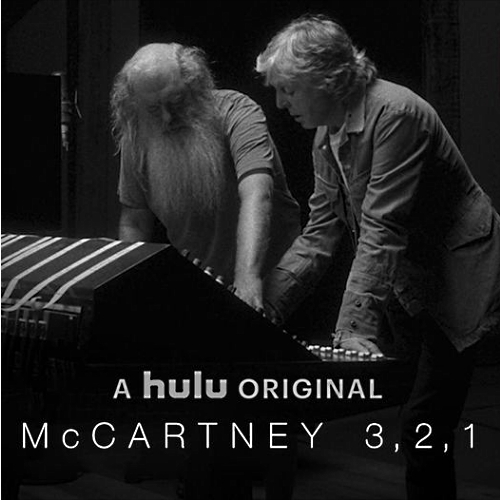 And here is Paul McCartney's latest pop video  July 20, 2021 New documentary on George Martin’s legendary Montserrat studio on the way It will tell the story of the studio where Elton John, Paul McCartney, Rolling Stones and many others recorded by Matthew Neale for New Music Express A trailer has been released for new music documentary Under The Volcano, which is set to tell the story of Sir George Martin’s famous AIR Studios on Montserrat. Directed by Gracie Otto (The Last Impresario) and produced by Cody Greenwood, the film will chart the rise and fall of the studio built by Martin – often regarded as the “fifth Beatle” for his long career producing the band – in 1979. Elton John, Duran Duran, and many other famous acts of the era recorded at the studio during its heyday. The tiny studio in the British overseas territory in the eastern Caribbean was where a string of iconic hits were recorded in the ’80s. It also formed the backdrop to several major events in music history including the break-up of The Police, the reunion of The Rolling Stones and Paul McCartney‘s comeback after the murder of John Lennon. Under The Volcano features interviews with The Police, Mark Knopfler, Nick Rhodes, Midge Ure and more, and will be released via digital, DVD and Blu-ray on July 26. Watch the trailer below. Built in the shadow of an active volcano, the studio was also the birthplace of huge hits such as ‘Money For Nothing’ and ‘Every Breath You Take’. After a decade of hits, and at the peak of its popularity, the studio was destroyed when the island was hit by a series of devastating natural disasters. In other news, last week (July 12) Peter Jackson explained why Beatles fans are likely to be surprised by his new docuseries Get Back. Discussing the format of the new project, which focuses more on conversations than music, Jackson said the series will be very “intimate”.  July 19, 2021 George Harrison & Ravi Shankar on the ‘Bangladesh’ Concert, the Sitar, Their Friendship & More by Harvey Kubernik for Best Classic Bands August 1, 2021, marks the 50th anniversary of the Concert for Bangladesh, a pair of benefit concerts organized by Ravi Shankar and George Harrison that took place in New York City at Madison Square Garden. The shows were staged in order to raise awareness and fund relief for millions of East Pakistan refugees, after the Bangladesh Liberation War-related genocide. But it was in Los Angeles, in the summer of 1971, that Harrison was first alerted by his friend and sitar teacher Shankar to the scale of suffering. Before long, Harrison, Ringo Starr, Bob Dylan, Leon Russell, Billy Preston, Eric Clapton, Jim Keltner, Jesse Ed Davis, Klaus Voormann, Badfinger, Shankar and others had agreed to donate their services. Following the performances, Shankar partnered with Harrison to produce a film and album from the event, which raised funds for UNICEF. In 1997, this writer interviewed Harrison and Shankar in Southern California. Portions were first published in HITS magazine. “His music was the reason I wanted to meet him,” said Harrison at that time. “I liked it immediately; it intrigued me. I don’t know why I was so into it—I heard it, I liked it, and I had a gut feeling that I would meet him. Eventually, a man from the Asian Music Circle in London arranged a meeting between Ravi and myself. Our meeting has made all the difference in my life.” Harrison commented on his own sitar playing. “I’m not a very good one, I’m afraid. The sitar is an instrument I’ve loved for a long time. For three or four years I practiced on it every day. But it’s a very difficult instrument, and one that takes a toll on you physically. It even takes a year just to learn how to properly hold it. But I enjoyed playing it, even the punishing side of it, because it disciplined me so much, which was something I hadn’t really experienced to a great extent before.” Harrison went on to describe his earliest attempt at playing the sitar with the Beatles. “Very rudimentary,” he revealed. “I didn’t know how to tune it properly, and it was a very cheap sitar to begin with. So ‘Norwegian Wood’ was very much an early experiment. By the time we recorded ‘Love You To,’ I had made some strides.” Harrison put his sitar experiments with the Beatles in perspective. “That was the environment in the band. Everybody was very open to bringing in new ideas. We were listening to all sorts of things: Stockhausen, avant-garde music, whatever, and most of it made its way onto our records.” During that interview, Harrison and Shankar also discussed their just-issued Chants of India album on Angel Records.
“In a way it represents the accumulation of our ideas and experiences throughout our 30-year relationship,” said Harrison of the album. “But to put it into a slightly more commercial aspect, the record label asked us to do this and that would never have happened 15 years ago. Because of the fact that multiculturalism has become more accepted, and more people are interested in what this music offers, this project has become more commercially viable. And this music is very close to me; this is something I very much wanted to do. “I actively read the Vedic scriptures and I’m happy to spread the word about what this project is all about. People also need an alternative to all the clatter in their lives and this music provides that. Whether it’s Benedictine Monks chanting or ancient Vedic chants, people are searching for something to cut through all the clatter and ease stress.” “Chants of India… I have done so much programming in my life,” said Shankar, “starting from my early days in All India Radio. Being a director there, the psychology of programming, or sequencing, as you call it, comes very easily for me. Give them a bang, then after that you pull them, build it up. That sort of natural tendency I learned from my brother, who was a great dancer and had great stagecraft, which I learned from my childhood. George went through the sequencing with me and agreed with what I made from the buildup when I did the programming. The package is so beautiful, and George was very enthusiastic. “George is a very rare person…it is something so special,” Shankar continued. “There are many other people who could do what George does, but they don’t have that depth. He’s so unusual. What has clicked between him and me, what he gets from me, and what I get from him, that love and that respect and understanding from music and everything, is really the most important thing. It’s not the money, or him helping me to record, that’s not the main thing. But it’s the very special bond between both of us.” Shankar and I then discussed the genesis of the landmark 1971 event, often acknowledged as rock’s first major benefit concert. “The Concert for Bangladesh came about when I told George, and George wanted to help me,” said Shankar. “I was planning to do a benefit concert for Bangladesh, because I was very hurt that this whole thing was going on. To help this refugee problem, I wanted to raise some money. Everybody, every Indian, was thinking about doing that. And then, when I thought about it, I knew I could do more than any other Indian musician. Still, how much can you send? $20,000? $25,000, at the most? At this time of turmoil I was having, George was there. “I told him what I was planning. At the same time, I never wanted to take advantage of him. I did not want to say, ‘Would you help me?’ But, somehow, it came very naturally. He was so sympathetic. ‘Well…let’s do something.’ And you know, that made me feel so happy. What he did, he immediately started phoning and booking things up. He phoned and got Madison Square Garden,” said Shankar. “Later he contacted Bob Dylan, Eric Clapton, Billy Preston, and a few of his friends. Somehow, it was done (snaps his fingers), like that. “Within three weeks or so, we gave a performance and it was sold out. So, they had to schedule a matinee. As you know, the first half was me. I called my guru’s son, Ali Akbar Khan, who plays the sarod. We were the first part. I composed the first lines for the items played, as we always do, and we improvised and then intermission. “It went beautifully. It was a young audience, especially because I had this existing audience already, who were mature listeners. This audience was the same type of audience as the [1967] Monterey International Pop Festival, but they were very attentive and there was no problem at all. “After our segment, I went to see the second half. Their program was very complementary, because they chose the numbers that were very soulful in the sense that they weren’t hard rock. ‘My Sweet Lord,’ ‘That’s the Way God Planned It.’ Bob Dylan had his harmonica and did ballads. George sang ‘Here Comes the Sun,’ and the song he composed, ‘Bangla Desh.’ There was harmony and it wasn’t so different. It went off beautifully.” The Concert for Bangladesh (originally titled The Concert for Bangla Desh) was a live, triple album, commercially released just before Christmas in 1971 in the U.S. and after New Year’s Day 1972 in the U.K. It immediately became a bestseller, landing at #2 for several weeks in the U.S. charts and becoming Harrison’s second #1 U.K. album. The multi-disc soundtrack set won the Grammy award for Album of the Year of 1972 for music producers Harrison and Phil Spector.  July 13, 2021 ‘You’ve never seen The Beatles like this before’: Peter Jackson on his epic Get Back docuseries Click on the image below to access the interview conducted by Dylan Jones for GQ magazine:
 July 12, 2021 An outbreak of Beatlemania on the Isle of Wight by Alan Stroud for the Isle of Wight County Express
EVERY summer we can rent a cottage on the IW. When Paul McCartney sang that line on the Sgt Peppers album, on the track ‘When I’m 64’, it was no accident — McCartney and John Lennon were no strangers to the Island. They had first visited in 1960 when they came to visit McCartney’s cousin Bett and her husband Mike, who had taken on the Bow Bars on Union Street in Ryde and they visited again the following year. After hitching down to Portsmouth, Lennon and McCartney then bought a ticket to Ryde. As revealed in McCartney’s 1998 book ‘Many Years From Now’, Lennon was taken with the punning potential of the phrase and it led to him write Ticket To Ride.
When it was released in April ‘65, councillors at Ryde knew nothing of this and assuming the title was just a happy coincidence they discussed whether there was any capital to be made out of the song. Under the headline ‘Beatles To Publicise Ryde? the CP wrote: “The chart-topping Beatles may unknowingly help to publicise Ryde as a holiday resort this summer with their latest number one record, ‘Ticket to Ride.’ “At a meeting of Ryde Council on Tuesday, Mr. R.V. Bourn said there was a first-class opportunity for the publicity department to use a play on the title in their national advertising?” Sadly, the moment passed. The previous year had seen an outbreak of Beatlemania on the Island. A CP reader signing himself ‘Regular Cinemagoer’ had been to see A Hard Day’s Night at the Savoy Cinema and he was not happy. He said: “Once again a Saturday evening, at which we pay some of the highest seat prices outside of London, has been ruined by the noise of loud-mouthed youths and screaming teenage girls. “Included in the programme was a special short film of the Beatles. “It should have been quite entertaining to the many adults who enjoy this talented group, but it was completely ruined by shouting youths and screaming girls. “Then, as if not content at ruining one film, there was again noise and disturbance during the main film. Surely the cinema managements can take drastic steps to curb this.”
In 1969, George Harrison paid a visit to the Island to spend some time with his friend Bob Dylan who was headlining the Wootton festival. Twenty-year-old Chris Colley from Northwood was hired to act as Dylan’s driver. He said: “It was a wonderful experience. Dylan was quite determined to treat me as one of his friends, not a lackey. “He was very easy-going but he did have standards. We were driving past Yaverland one day, with Dylan and George Harrison in the back. “They were genuinely great friends but I could tell Harrison was hero worshipping Dylan. “He said, ‘we could release any old crap nowadays and the public would buy it.’ “He got torn off a strip by Dylan. ‘What? Don’t you realise those people put us where we are. You can’t talk about them like that. We owe them.’ “He was very defensive and that shut Harrison up for a while, but a bit later I was talking to Dylan and George Harrison just butted in and cut me off. “To my surprise Dylan said, ‘Wait, George. Hang on. Chris, what did you say?’ and let me carry on talking. “I was just as important in that car as George Harrison.” It’s an incongruous thought — Yoko Ono going up St Johns Hill at Ryde in a Ford Transit — but it actually happened. Local, Dave Parr, was also assisting with chauffeur duties during the Wootton festival. He said: “I drove Dylan and his wife to the festival. They sat in the front with me, and John Lennon and Yoko Ono were in the back where there were no seats, just a plank to sit on.
“We stopped at the traffic lights at the top of St Johns Hill and when I pulled away, there was a crash in the back — John and Yoko had fallen off the seat. “The funny thing was, they never said a word.” As Harrison had enjoyed his visit to the Island, Ray Foulk, festival promoter, wrote to him to try and persuade the Beatles to headline the 1970 festival at Afton. He said: “The greatest achievement that could be attained in the music festival sphere would be for the Beatles to perform at the next IW Festival. “We are not professional promoters but we are ambitious and want to make a distinct mark on society on behalf of the young people of the world.” An impassioned request, but it was not to be. The Fab Four would never appear in the same room together again, the last time being just a week before the Wootton festival. In 1973, Ringo Starr returned to the Island to film scenes for the film That’ll Be the Day alongside David Essex and Billy Fury, following which, the Island remained largely Beatle-free until 2010. That year, Paul McCartney headlined the IW Festival. Did he sing, every summer we can rent a cottage on the IW? He did not. That honour went to The Killers in 2013.  July 9, 2021 Ringo's appreciation to all those who helped spread the "peace and love moment" on his birthday
 July 8, 2021 "Cosmic Empire" by George Harrison makes its Official Video Debut tomorrow on YouTube Click on the image below to access the video.   July 7, 2021 Watch Paul McCartney and Rick Rubin Talk Beatles in Trailer for ‘McCartney 3,2,1’ Clip shows McCartney and Rick Rubin dissecting Beatles classics like “Come Together,” “In My Life,” and “With a Little Help From My Friends” by Andy Greene for Rolling Stone A trailer for the six-part Hulu documentary series McCartney 3, 2, 1 has been released. It shows Paul McCartney and Rick Rubin dissecting Beatles classics like “Come Together,” “All My Loving,” “With a Little Help From My Friends,” and “In My Life,” sharing behind-the-scenes stories, and even playing bits of unreleased music from the vast Beatles archive. “Never before have fans had the opportunity to hear Paul McCartney share, in such expansive, celebratory detail, the experience of creating his life’s work — more than 50 years of culture-defining music,” Hulu Originals and ABC Entertainment’s president Craig Erwich said in a statement. “To be an observer as Paul and Rick Rubin deconstruct how some of the biggest hits in music history came to be is truly enlightening.” McCartney 3,2,1 was directed by Zachary Heinzerling, whose credits include the 2013 Beyoncé documentary series Self-Titled and the 2013 documentary Cutie and the Boxer, which centers around the boxing painter Ushio Shinohara and his wife Noriko. All six episodes of the McCartney 3,2,1 will premiere on Hulu on July 16th. And in November, the long-awaited documentary series The Beatles: Get Back will arrive on Disney+. Directed by Peter Jackson, it utilizes over 55 hours of previously unseen footage from the 1969 Let It Be sessions. It was originally conceived as a documentary, but will now be divided into three parts. The first arrives on November 25th, and the next two hit on November 26th, and November 27th.  June 28, 2021 ‘Let’s Spread #peaceandlove,’ Says Ringo Starr Ahead Of 2021 Birthday Event Ringo turns 81 on July 7 and has renewed his annual invitation for fans to think, say or post #peaceandlove at noon that day. by Paul Sexton for Udiscovermusic Ringo Starr has today (28) posted a message to his legions of fans worldwide about his upcoming #peaceandlove birthday initiative for 2021. The beloved former Beatle turns 81 on July 7 and has renewed his annual invitation to take part in the coming together and think, say or post #peaceandlove at noon their local time on the day. Starr has spearheaded the initiative since 2008, when it began after “peace and love” was his answer to a reporter’s question about what he would like for his birthday. He says in the taped message: “I’m inviting everyone who wants to join the peace and love celebration for my birthday at noon your time wherever you are, 7-7-21 – you can post it, you can say it, you can even think it – but it would be really cool if you go ‘Peace and Love’ at noon on my birthday – so let’s spread peace and love on my birthday – c’mon everybody!” Gatherings have traditionally taken place in person, with Starr meeting fans in whichever city he is in, from 2008 when he did so on the streets outside the Hard Rock Café in Chicago. He helped to pass out cupcakes and joined the crowd for “Peace and Love” at noon. The event has since expanded enormously, and in 2019 there were more than 30 Peace and Love events in cities all over the world, from Buenos Aires to Yerevan, Sydney to La Paz, Sao Paulo to Bogota, Prague to Helsinki, Asunción, to Lima, London to Liverpool, Chicago to New York City, and far beyond. Last year, the pandemic prevented an in-person event, and the celebration moved online, with the star hosting Ringo’s Big Birthday Show for his 80th birthday. It featured unseen concert and unique performances by Starr, Paul McCartney, Joe Walsh, Ben Harper and Dave Grohl, Sheryl Crow, Gary Clark Jr, Peter Frampton, Sheila E, and many others. The show was broadcast around the world via AXS, YouTube and Ceek, and benefitted Black Lives Matter Global Network, the David Lynch Foundation, Musicares, and WaterAid. The Mars Rover and the International Space Station were the first to deliver birthday wishes to Ringo. “From 260 miles above our home planet, NASA Astronauts wish Ringo Starr a happy 80th birthday!,” went the message. “Since our orbiting laboratory operates in Greenwich Mean Time, or GMT, it’s officially July 7 – a perfect date to send #PeaceAndLove to everyone across the universe!” Details on 2021 Peace and Love regional gatherings to be hosted by fans next month, in person and via Zoom, can be found on Ringo’s Facebook page. Events are already confirmed in Argentina, Costa Rica, Columbia, El Salvador, Germany, Guatamala, Japan, Italy, Panama, Peru, Portugal, Russia, Spain, Switzerland, UK, USA. History Of Ringo’s Annual July 7 Peace & Love birthday celebrations: 2008 – Chicago, IL Hard Rock Cafe 2009 – Online campaign including in store salutes at Noon at all Hard Rock Cafes worldwide 2010 – New York City, NY: Hard Rock Cafe, Times Square 2011 – Hamburg, Germany: Hard Rock Cafe 2012 – Nashville, TN: Hard Rock Café 2013 – Online celebration including a video message from Ringo 2014 – Los Angeles, CA: Capitol Records Tower 2015 – Los Angeles, CA: Capitol Records Tower 2016 – Los Angeles, CA: Capitol Records Tower 2017 – Los Angeles, CA: Capitol Records Tower 2018 – Nice, France: Hard Rock Café 2019 – Los Angeles, CA: Capitol Records Tower 2020 – Los Angeles, CA: Virtual celebration, “Ringo’s Big Birthday Show” From the Beatles Facebook pages highlighting the great Billy Preston
 June 25, 2021 Paul McCartney: How I made Ram by Simon Harper for Classic Rock Exclusive: On a remote Scottish farm in 1971, Paul McCartney created Ram, an album that would save his soul - even if it meant severing ties with John Lennon In retrospect, it’s easy to pull at the threads of The Beatles’ studiously scrutinised timeline and examine the source of their unravelling; to point fingers at the capricious actions of each member who may have abdicated (albeit temporarily) along the way, and to speculate on the heroes and villains of their illustrious story. But to the outside world at the time, which was largely unaware of the degree to which contempt had risen within the group, the ending of The Beatles was defined on April 9, 1970, when Paul McCartney announced – via a press release intended to promote his debut solo album, McCartney – that he had no intention of continuing to work with the group. “Personal differences, business differences, musical differences” were his reasons for the break, he wrote, “but most of all because I have a better time with my family.” Of course, we know now that McCartney’s declaration was merely the first public confirmation of the Fab Four’s dissolution – an increasingly distracted and dissatisfied John Lennon had requested a “divorce” during a private band meeting the previous September – but still, the other Beatles were incensed. Despite the tangible tensions and fragmentations in the group, which undoubtedly rose to the surface after the death of manager Brian Epstein in 1967, heightened amid the strained recording sessions for The Beatles (aka the White Album), and came to a head with the aggressive legal wrangles that sought to salvage their Apple Corps business, it was presumed that The Beatles could endure as a recording unit, and coexist with individual solo pursuits. “We’re not breaking up the band,” Lennon had told a journalist in January 1970, “but we’re breaking its image.” It was the unwavering love and support of Linda that coaxed her husband out of his state of despair. With her encouragement, he would begin to emerge from the grief and sorrow that had engulfed him with the intent to channel his restless energy into a batch of new, unrestrained and cathartic songs. Having returned to London in late December 1969, he started work on McCartney in his St. John’s Wood home, where a four-track tape machine recorded intuitive and experimental sessions that delivered the album’s rudimentary tracks. Although he would later embellish these elsewhere – including at Abbey Road Studios, a stone’s throw from his house – the songs, with all the instrumentation played by McCartney, retained a distinctly homemade quality, with simplicity, improvisation and contentment at the heart of its primitive charm. Impromptu instrumentals such as Valentine Day and Hot As Sun/Glasses sat coolly alongside meditative White Album leftovers Junk and Teddy Boy, extolling a sense of impulsive invigoration, while the levels of devotion and gratitude that Paul felt for his wife were evident in lilting acoustic opener The Lovely Linda and the rousing resplendence of Maybe I’m Amazed. “I loved that record because it was so simple,” Neil Young would enthuse in 1999, as he inducted McCartney into the Rock And Roll Hall of Fame. “It was just Paul. There was no adornment at all… There was no attempt made to compete with the things he had already done. And so out he stepped from the shadow of The Beatles.” (to continue reading this report, click here.)  June 24, 2021 Cirque's 'The Beatles LOVE' returns to The Mirage in August by Matthew Seeman for KSNV
LAS VEGAS (KSNV) — "The Beatles LOVE" is the latest Cirque du Soleil production to schedule its return to the Las Vegas Strip. Cirque announced Wednesday the show will resume production at The Mirage on Aug. 26, part of the group's "Intermission Is Over" initiative to celebrate the return of shows. It's part of the company's plan to bring several other shows back to the stage, including "Michael Jackson ONE" at Mandalay Bay on Aug. 19, which was announced last week. "Today, we all stand together to celebrate our industry coming back to life," Daniel Lamarre, president and CEO of Cirque du Soleil Entertainment Group, said in a press release. "Let's flood social platforms with messages of hope, strength and perseverance. We encourage you to join us and add your voice to support your favorite artists, venues, friends and families working in the live entertainment industry. Intermission is over. Now, show time!" Two other Cirque productions - "O" and "Mystère" - are scheduled to resume performances starting the week of June 28.
 June 23, 2021 Madame Tussauds Berlin displays wax figures of the Beatles
GuruShots photographer as wax caricatures at "Madame Tussauds Berlin" in Berlin, Germany. The Ottawa Beatles Site wishes to acknowledge Sandra Gucijan for allowing us to publish her beautiful photograph. Thank you, Sandra!  June 21, 2021 From Paul McCartney's Official Facebook page
Happy Summer Solstice from the Ottawa Beatles Site  June 20, 2021 Over 6 hours of never-before-seen restored Beatles footage to air on Disney+ by Sam Roche for Guitar World (2 days ago.) New three-part Peter Jackson-directed documentary series compiles over 60 hours of footage shot in 1969 by Michael Lindsay-Hogg, and over 150 hours of audio recordings
Disney+ is to host a new documentary – The Beatles: Get Back – featuring over six hours of never-before-seen restored Beatles footage.
Directed by Peter Jackson, the documentary – which is split into three two-hour episodes, airing November 25, 26 and 27 – is compiled from over 60 hours of footage shot in 1969 by Michael Lindsay-Hogg and over 150 hours of audio.
It tells the story of John Lennon, Paul McCartney, George Harrison and Ringo Starr planning their first live show in over two years, capturing the writing and rehearsing of 14 new songs originally intended for release on an accompanying live album.
The documentary also features – for the first time in its entirety – The Beatles' iconic last-ever performance on London's Savile Row, as well as a host of songs and compositions from their final two albums, Abbey Road and Let It Be.
“In many respects, Michael Lindsay-Hogg's remarkable footage captured multiple storylines,” says Peter Jackson. “The story of friends and of individuals. It is the story of human frailties and of a divine partnership.
“It is a detailed account of the creative process, with the crafting of iconic songs under pressure, set amid the social climate of early 1969. But it's not nostalgia – it's raw, honest, and human. Over six hours, you'll get to know The Beatles with an intimacy that you never thought possible.”
He continues: “I'm very grateful to The Beatles, Apple Corps and Disney for allowing me to present this story in exactly the way it should be told. I've been immersed in this project for nearly three years, and I'm very excited that audiences around the world will finally be able to see it.” “As a huge Beatles fan myself, I am absolutely thrilled that Disney+ will be the home for this extraordinary documentary series by the legendary filmmaker Peter Jackson,” says Bob Iger of The Walt Disney Company.
“This phenomenal collection of never-before-seen footage offers an unprecedented look at the close camaraderie, genius songwriting, and indelible impact of one of the most iconic and culturally influential bands of all time, and we can't wait to share The Beatles: Get Back with fans around the world.”
Ahead of the documentary's Disney+ debut, The Beatles: Get Back hardcover book will arrive via Apple Corps Ltd./Callaway Arts & Entertainment on October 12. It complements the documentary with transcriptions of The Beatles' recorded conversations and hundreds of never-before-published photos from the three weeks of sessions.
 June 16, 2021 Emile Berliner and George Harrison hit pop music milestones   June 11, 2021 George Harrison’s Masterpiece, ‘All Things Must Pass,’ Gets 50th Anniversary Editions by Best Classic Bands Staff George Harrison’s landmark solo album, All Things Must Pass, recorded and released in the wake of The Beatles’ April 1970 dissolution, is receiving a suite of 50th anniversary releases that fulfills Harrison’s longtime desire. The original, the first-ever triple studio album, was produced by Harrison and Phil Spector and released in November 1970. The original collection, featuring such classic songs as “My Sweet Lord,” “Isn’t It a Pity,” “What is Life” and “Awaiting on You All” among its 23 tracks, was an epic, ambitious expression of Harrison’s songwriting, powerful spirituality and a celebration of both his inimitable individuality and unique camaraderie with his fellow musicians. The new editions, announced today (June 10), offer a wealth of previously unreleased material in a variety of formats that include an aptly named Uber Deluxe Edition. All arrive August 6, 2021, via Capitol/UMe. It becomes the latest release from The Beatles collectively and individually to receive such a grand treatment. Harrison brought together a stunning roster of friends and fellow musicians to record All Things Must Pass, including Ringo Starr, Klaus Voormann and Billy Preston, along with Eric Clapton and his new American bandmates, Carl Radle, Bobby Whitlock, and Jim Gordon (soon to be known collectively as Derek and the Dominos). Badfinger’s Pete Ham, Tom Evans, Joey Molland and Mike Gibbons contributed additional acoustics and percussion. Spector’s desire for multiple pianos, layers of acoustic guitars and more drums saw the addition of Peter Frampton and Jerry Shirley from Humble Pie, Spooky Tooth’s Gary Wright, Plastic Ono Band veteran and future Yes drummer Alan White, Traffic’s Dave Mason, Procol Harum’s Gary Brooker and the in-demand horn section of Bobby Keys and Jim Price. Pete Drake, legendary Nashville session musician, provided pedal steel guitar on several tracks. Arrangements for strings and horns came from longtime collaborator John Barham. All Things Must Pass was an overdue artistic release for Harrison as a songwriter and musician. It overflows with a voluminous range of ideas, musical styles and influences, spanning rock ’n’ roll, country, gospel, blues, pop, folk, R&B, Indian classical music and devotional songs. Despite the album being wildly successful and Harrison’s affection for it, he would write in the liner notes for the 30th anniversary remaster, released in 2001, “I still like the songs on the album and believe they can continue to outlive the style in which they were recorded,” adding, however, “it was difficult to resist re-mixing every track. All these years later I would like to liberate some of the songs from the big production that seemed appropriate at the time.”
Decades in the making and lovingly crafted by the Harrison family, All Things Must Pass has now been completely remixed from the original tapes. Executive produced by Dhani Harrison, product produced by David Zonshine and mixed by triple GRAMMY® Award-winning engineer Paul Hicks (The Beatles, The Rolling Stones, John Lennon), the new mix transforms the album by sonically upgrading it–making it sound brighter, fuller and better than ever before. The announcement is heralded with a video for the previously unreleased and remixed “Run Of The Mill” (Take 36)” which is inspired by elements of the Harrisons’ home, Friar Park. Watch it below the links. It will be available in a variety of formats: Super Deluxe Edition The boxed set, presented on 8-LPs (180g) or 5-CDs + 1 Blu-ray audio disc, explores the 1970 album sessions through 47 (42 previously unreleased) demos and outtakes. The Blu-ray allows fans to experience the main album in high-res stereo, enveloping 5.1 surround sound and Dolby Atmos mixes. The collection contains a beautiful 60-page scrapbook curated by Olivia Harrison, with unseen imagery and memorabilia from the era, handwritten lyrics, diary entries, studio notes, tape box images, a comprehensive track-by-track and more. It also includes a replica of the original album poster. Uber Deluxe Edition Available via GeorgeHarrison.com, this very limited boxed set includes the album on 8 LPs (180g), 5 CDs + 1 Blu-ray audio disc housed in an artisan designed wooden crate (approx. 12.4” X 12.4” X 17.5”). The collection explores the 1970 album sessions through 47 (42 previously unreleased) demos and outtakes, offering an inside look into the creative process. The Blu-ray allows fans to experience the main album in high-res stereo, enveloping 5.1 surround sound and Dolby Atmos mixes. The crate contains two books, an elaborate and expanded 96-page scrapbook curated by Olivia Harrison, with unseen imagery and memorabilia from the era, handwritten lyrics, diary entries, studio notes, tape box images, a comprehensive track-by-track and more; while a second 44-page book chronicling the making of All Things Must Pass through extensive archival interviews with notes is also contained therein. The elegantly designed book pays homage to Harrison’s love of gardening and nature. The book also contains a wooden bookmark made from a felled oak tree (Quercus Robur) in George’s Friar Park. This truly unique box will also contain 1/6 scale replica figurines of Harrison and the gnomes featured on the iconic album cover, a limited-edition illustration by musician and artist Klaus Voormann, as well as a copy of Paramahansa Yogananda’s “Light from the Great Ones” and Rudraksha beads, contained in individual custom-made boxes. All Things Must Pass will also be released in multiple physical and digital configurations, including as a 5-LP or 3-CD Deluxe Edition that pairs the main album with the sessions outtakes and jams. The main album will be available on its own as 2-CDs 3-LPs or limited edition 3-LP colored vinyl.
The All Things Must Pass session tapes created in 1970 include over t25 hours of music on 49 1” eight-track tapes, four 2” 16-track tapes, and 44 ¼” stereo tapes. Richard Radford, Archivist for the George Harrison Estate, oversaw the preservation of the tape collection, with the original analog multi-track and stereo tapes transferred to 192 KHz/24bit digital preservation copies. The original album was met by unanimous critical acclaim and spectacular commercial success, spending seven weeks at #1 on the Billboard chart and eight weeks atop the U.K.’s official albums chart (though chart records until 2006 mistakenly stated that it had peaked at #4). Currently certified 6x Platinum by the RIAA, All Things Must Pass later received a 1972 GRAMMY® Award nomination for Album of the Year, while “My Sweet Lord” earned a GRAMMY® nod for Record of the Year. Super Deluxe Edition Track Listing Disc One (Main Album) I’d Have You Anytime My Sweet Lord Wah-Wah Isn’t It A Pity (Version One) What Is Life If Not For You Behind That Locked Door Let It Down Run Of The Mill Disc Two (Main Album Cont.) Beware Of Darkness Apple Scruffs Ballad Of Sir Frankie Crisp (Let It Roll) Awaiting On You All All Things Must Pass I Dig Love Art Of Dying Isn’t It A Pity (Version Two) Hear Me Lord Out Of The Blue * It’s Johnny’s Birthday * Plug Me In * I Remember Jeep * Thanks For The Pepperoni * * Newly Remastered/Original Mix Disc Three (Day 1 Demos – Tuesday 26 May 1970) All Things Must Pass (Take 1) † Behind That Locked Door (Take 2) I Live For You (Take 1) Apple Scruffs (Take 1) What Is Life (Take 3) Awaiting On You All (Take 1) † Isn’t It A Pity (Take 2) I’d Have You Anytime (Take 1) I Dig Love (Take 1) Going Down To Golders Green (Take 1) Dehra Dun (Take 2) Om Hare Om (Gopala Krishna) (Take 1) Ballad Of Sir Frankie Crisp (Let It Roll) (Take 2) My Sweet Lord (Take 1) † Sour Milk Sea (Take 1) Disc Four
(Day 2 Demos – Wednesday 27 May 1970) † Previously Released Disc Five (Session Outtakes and Jams) Isn’t It A Pity (Take 14) Wah-Wah (Take 1) I’d Have You Anytime (Take 5) Art Of Dying (Take 1) Isn’t It A Pity (Take 27) If Not For You (Take 2) Wedding Bells (Are Breaking Up That Old Gang Of Mine) (Take 1) What Is Life (Take 1) Beware Of Darkness (Take 8) Hear Me Lord (Take 5) Let It Down (Take 1) Run Of The Mill (Take 36) Down To the River (Rocking Chair Jam) (Take 1) Get Back (Take 1) Almost 12 Bar Honky Tonk (Take 1) It’s Johnny’s Birthday (Take 1) Woman Don’t You Cry For Me (Take 5) Blu-ray Audio Disc (Main Album Only; Surround, Atmos, Hi-Res) I’d Have You Anytime My Sweet Lord Wah-Wah Isn’t It A Pity (Version One) What Is Life If Not For You Behind That Locked Door Let It Down Run Of The Mill Beware Of Darkness Apple Scruffs Ballad Of Sir Frankie Crisp (Let It Roll) Awaiting On You All All Things Must Pass I Dig Love Art Of Dying Isn’t It A Pity (Version Two) Hear Me Lord Out Of The Blue It’s Johnny’s Birthday Plug Me In I Remember Jeep Thanks For The Pepperoni  June 10, 2021 On this day in 1966, The Beatles Paperback Writer jumps from #29 to #17 position on CFRA's radio Swing Set
 June 6, 2021 The Indian who took the Beatles home for tea by AFP
Ajit Singh, the Indian music shop owner who befriended the Beatles during their magical mystery trip in Rishikesh over half a century ago, has died aged 88. In February 1968 the Fab Four fetched up at Maharishi Mahesh Yogi's ashram (retreat) in northern India, seeking spirituality, new experiences and refuge from Beatlemania back home. Energised by their new surroundings overlooking the Ganges river, John Lennon, Paul McCartney, George Harrison and Ringo Starr wrote much of their seminal "White Album" there. Turbaned, thin and with a croaky voice, Singh recalled in an interview with AFP in 2019 the band wandering into his musical instrument shop in nearby Dehradun one day. He remembered hitting it off with the Liverpudlians, who had been pursued by a crowd outside, and "inviting them home for tea". Later he fixed Lennon's guitar and performed at Harrison's 25th birthday party. "They were very polite with me, they were not haughty or something," he told AFP with twinkly eyes, in the shop that he still ran half a century later, the Pratap Music House. "I always said to people that they were good people." Local journalist Raju Gusain, who has been at the forefront of restoring the rundown former ashram in recent years, said Singh thought Lennon was the most talented in the band. "Ajit Singh was a lovely chap," Gusain told AFP, confirming his death earlier this week, recalling how he loved to recount his old stories about the Beatles. "He promised he would provide some photographs of Harrison's birthday bash, but he failed to locate them and used to make excuses," Gusain said. "He said he was not that organised and would find them one day and give me a call. We both used to laugh about that." Singh was a highly accomplished musician in his own right, performing abroad and becoming one of the top-graded artists on All India Radio, according to The Times of India. He was one of very few people who could play the vichitra veena, a traditional string instrument that rests horizontally in front of the kneeling musician. "I used to tell Ajit... to pen down his experiences for posterity and write a book," the paper quoted life-long friend Mercy Phuntsog Nath as saying. "He would nod his head and say, 'I am writing'."  June 5, 2021 Dhani Harrison Perpetuates the Ukulele’s Tradition of Sharing Joy with New Fender Custom Signature Design by Madeline Crone for American Songwriter (click here to read the article)  June 2, 2021 The Unique Rides of Rock Legends Both Lennon and Joplin transformed their rides into statements about the times by Richard Crouse for Wheels.ca
People either loved or hated John Lennon’s 1965 psychedelic Rolls-Royce Phantom V Touring limousine. According to one story, a woman yelled, “You swine! How dare you do that to a Rolls-Royce,” at the Beatle as he cruised along London’s Piccadilly. Why the strong reaction? At the musician’s request, artist Stephen Weaver had painted the once refined vehicle into a nonconformist, four-wheeled, rolling representation of Summer of Love hip. “That’s when the car started taking on a life of its own,” said Lorne Hammond, history curator at the Royal B.C. Museum in Victoria, and the current home of the legendary vehicle. Lennon bought his distinctive car (before he even has a driver’s license) on the advice of his business manager, who warned the members of the band they needed to start spending money, said Hammond. “The accountant pointed out that they had done very well, but they would be paying 90 per cent tax,” he said. “They were all ordered to go out and buy houses and cars on very short notice, because, otherwise, it all goes to the tax man.” Lennon’s spending spree began with the cash purchase of the car, which was tricked out with all the usual accessories and elegant touches – a Valentine Black finish and walnut trim – you would expect from a Royce. Then, there were the unusual add-ons: a writing desk, a radio-telephone, a double bed, a Philips Auto-Mignon AG2101 “floating” record player and a Perdio portable television. And, as a final touch, the Royce received a new paint job to coincided with the release of the Beatles’ “Sgt. Pepper’s Lonely Hearts Club Band” album in 1967. Inspired by the spiritual books that bandmate George Harrison was reading, Lennon paid Weaver to really make it a one-of-a-kind limo. Using cellulose-based house paint, the artist laid down a base coat—a shade the Daily Mail called “shrieking yellow”—and decorated the car with whimsical flower-power vines, colorful art nouveau swirls and Lennon’s astrological sign, Libra, on the roof. Don’t make the mistake of thinking Lennon was alone in his enthusiasm for a unique ride. A number of musicians have left behind automobiles that were not only symbols of their success, but also works of art that reflected their antiestablishment rock ’n’ roll attitudes. Unlike Lennon, Janis Joplin had a driver’s license when she paid $3,500 for her second-hand, 1964 Porsche 356 C Cabriolet in Dolphin Grey. The car really stood out after she shelled out another $500 to roadie Dave Richards to customize it with a kaleidoscopic mural called “History of the Universe.”
Bill King, Joplin’s former musical director, said he and the singer would often go to a billiards hall in the San Francisco area in the vehicle. “People would run to the windows when she pulled up” he said. “She’d park it in sight where everybody could see it. She wanted to see it, too, because it could easily get stolen. “She didn’t let anybody touch it,” added King. “But she couldn’t drive it right. She liked to go out and play nine ball and then we’d ride around in her car, but she couldn’t figure out the clutch. You know how San Francisco is with the hills. She’d go up a hill and all of a sudden it would just cough and die and we’d all sort of jump over and try to put our foot on the brake at the same time so it didn’t roll backwards on us.” Lennon also managed to keep his car on the road, despite the concerns of the police that its wild colours would distract other drivers. He once crammed nine people in the back to shuttle them to the Sgt. Pepper’s release party at manager Brian Epstein’s new country home and often gave lifts to his famous friends, including members of The Rolling Stones and Bob Dylan. Eventually the limo, which is now valued at nearly $7 million, made its way from England to New York’s Cooper-Hewitt Museum of Design before being parked at its current home at the Royal B.C. Museum. Canadian businessman Jim Pattison paid a record-setting (at the time) $2.3 million for the car at auction, displaying the limo at his Ripley’s Believe It or Not! museums before donating it to the province of British Columbia in 1986. “We have two things,” said museum curator Hammond. “We have a historic vehicle, covered in house paint, and we have a historic painting that happens to be on a vehicle instead of on a canvas.”  May 28, 2021 Meet Vic Flick, guitarist who played on "Ringo's Theme" in "A Hard Day's Night"  May 27, 2021 Untold story of The Beatles and their close cultural connection to India by Asjad Nazir for Eastern Eye
THE closing night film of this year’s UK Asian Film Festival is a world premiere of The Beatles And India on June 6. Drawing on a rich seam of archive and interviews, the fascinating documentary explores the close connection legendary pop super group The Beatles shared with India and the impact it made on their music. The film is inspired by the book Across the Universe: The Beatles in India, which was published by Penguin Random House to celebrate the 50th anniversary of the band’s trip to Rishikesh. The book’s author Ajoy Bose has directed the documentary and is delighted it was selected for this year’s UK Asian Film Festival, describing it as an ideal launch for a movie that celebrates the cultural bridge between the West and the East, more than half a century ago by the most famous rock band. “The book got widespread critical acclaim because it was perhaps the only attempt to comprehensively examine the role India played in shaping the evolution of The Beatles, from the most famous pop icons into pioneering musical artists with a social message that swept the world. At the same time, the band brought two vastly different cultures closer and in many ways drew the curtain on the past ugly history of colonial exploitation and prejudice,” explained Ajoy Bose. The unique audio-visual presentation uses rarely seen and heard footage, recordings and photographs, eye-witness accounts and expert comments, along with location shoots across India. “It has been a joy to work with British Indian music entrepreneur Reynold D’Silva, who some years ago had traced the influences that went into the making of the world’s first concept album Sgt. Pepper’s Lonely Hearts Club Band and my codirector, the gifted cultural researcher Pete Compton, and a dedicated production department.” The biggest challenge of making the movie was finding rare footage, audio recordings and photographs to make the main characters in the film come alive. It was also challenging to find those involved in The Beatles India story more than half a century later. “I am so glad that we managed to find a variety of eye-witness accounts.”
Not surprisingly, the writer-director has many favourite moments in the movie and particularly likes the eyewitness accounts of George Harrison’s wife Pattie’s birthday celebrations in the spring of 1968 at the Maharishi’s ashram in Rishikesh, standing exactly in the same place they did more than 50 years ago. “These evocative reminiscences of Nick Nugent, then a visiting young English teacher, and Ajit Singh, musician and music shop owner who befriended George and John (Lennon), are both unique. They also represent the kind of meticulous research and hard work that has gone into putting the film together.” With The Beatles connecting with different generations since they became the biggest band in the world in the 1960s and continuing to be popular, he is confident the film will appeal to all ages. He said: “In fact, our interviews with young Indian musicians, most of whom were born after The Beatles broke up as band, show in the film that there is a very emotional appeal for the band of the past century, which is so contemporary.” Bose is in the middle of writing a book on his experiences as a teenage Naxalite, who dropped out of an elite Delhi college and went to rural India to start an armed revolution exactly 50 years ago, which he hopes to turn into a film or TV series. When asked, who his own filmmaking hero is, he said: “Satyajit Ray, the Bengali maestro of world cinema, is my filmmaking hero. His master craftsmanship, competence over every part of the film, including the storyline, music, cinematography, to name only a few, but also the infinite variety of genres his films managed to span, I think is unmatched by any other filmmaker in the world so far.” Ajoy finishes off the conversation by telling us why we should watch The Beatles And India at the UK Asian Film Festival. “The Beatles have a very loyal audience across the world and certainly in the United Kingdom where they belonged. This film also deals with the special India connection of the band, which has been mentioned in passing but never really expounded in a film. That itself should cause considerable interest. And finally, at a time when the world is still being ravaged by a deadly virus, a film about The Beatles does provide romance, hope and joy amidst so much gloom, doom and hysteria.”  May 25, 2021 Badfinger's progressive rock style illustrates they were never soft on rock music
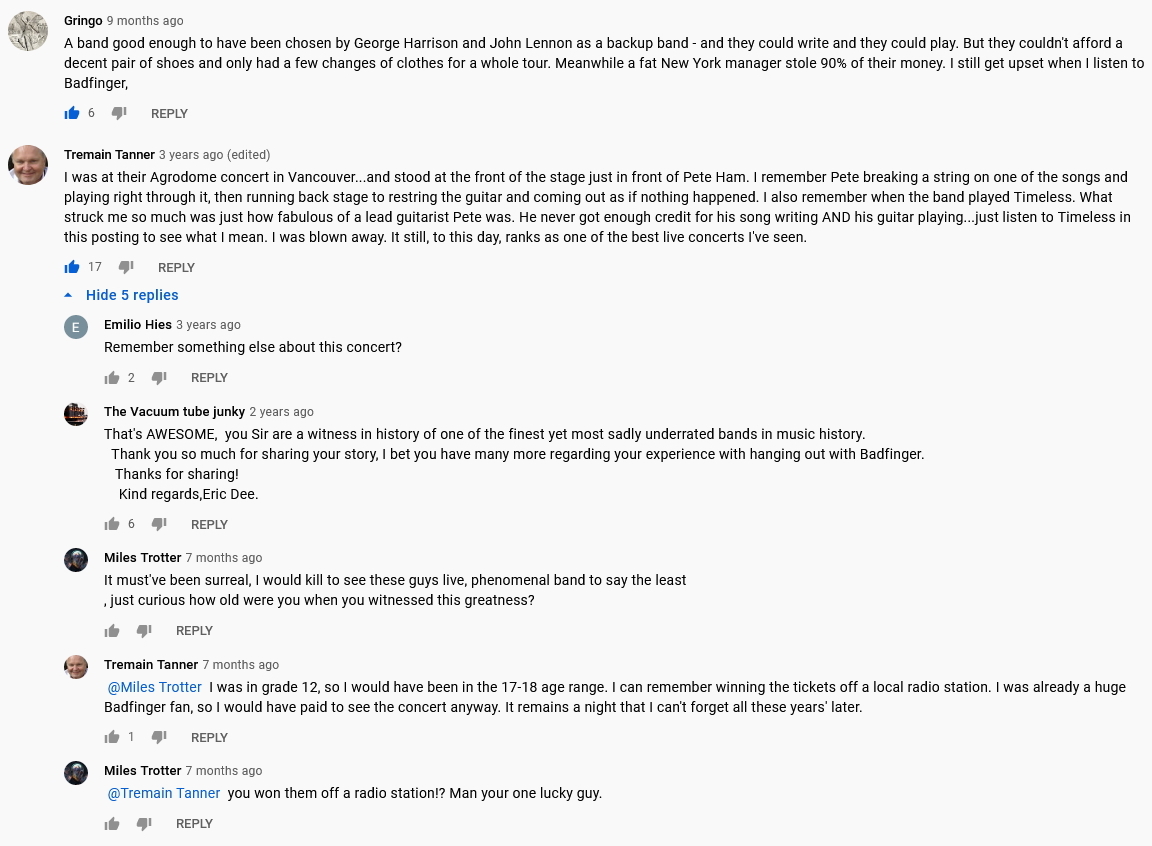  May 20, 2021 Natural cover version of "Every Little Thing" by Javier Parisi  May 19, 2021 "It Was Unbelievable!" Klaus Voormann On 'John Lennon / Plastic Ono Band' Discussing the demise of the Beatles, primal scream therapy, and those iconic sessions... by Clash
Klaus Voormann was there at the very beginning of The Beatles' story, and he was there at the end, too.
The German artist was amongst the coterie of Hamburg bohemians drawn to the raw appeal of the Liverpool group, and remained close to the band through their extraordinary rise.
Famously designing the iconic cover for The Beatles' album 'Revolver', he was also a talented musician, scoring UK chart hits with Manfred Mann.
Until a fateful phone call from John Lennon came his way, and Klaus was invited to board a plane for an ad hoc performance in Toronto.
Rehearsing on the flight over, this trans-Atlantic improvisation eventually settled into the Plastic Ono Band, the ever-evolving coterie who surrounded and augmented John Lennon and Yoko Ono's solo desires.
A new box set brings the 1970 album 'John Lennon/Plastic Ono Band' into focus once more, an extraordinary document that takes you right into the studio as John Lennon pushes the band forwards.
Guests include Eric Clapton and Ringo Starr, while the material would be marked the experiences John Lennon and Yoko Ono underwent as part of the controversial 'primal scream' therapy.
Riveting, soul-bearing stuff, it touches on loss, love, and personal transformation, while also hinting at the outspoken politics which would mark aspects of John Lennon's future solo albums 'Imagine' and 'Some Time In New York City'.
Klaus Voormann looks back on those sessions - and more - with Clash.
How does it feel to look back on those times?
Oh it’s very warm. Actually, I feel like they did this whole box set just for me! There’s so many things I’ve forgotten about, and can’t even remember. My memory was that all these sessions went really quick, but now I realise we were sitting there for a long time, John was contemplating it all. And it’s great to listen to those things! The music brings back great memories, much more so than the record itself… and the record itself is great anyway. But really, this is such a fantastic addition.
It’s an absolute treasure trove, for sure! You had just enjoyed success with Manfred Mann when John Lennon phoned and asked you to join – what was that like?
It’s great. It started with the Toronto concert. And then things came together, and we stayed in contact. Of course, we only did ‘Instant Karma’ and then he went to Los Angeles and did the Primal Scream thing… and when they came back it was so emotional, it was so amazing to see those people so close together. They really were… for me, it was like an open wound. They crawled back into the womb, and experienced all this. It’s hard for people to imagine what they went through. That’s all on this record – John wanted to get it out of his system as quick as he possibly can.
There was a visible change in John and Yoko on their return?
Definitely. They were happy! Really, really happy. They were worked up. Laughing, screaming, crying, hugging each other.. all those things in one. It was a big emotional burst out, I would say!
He wanted to work quickly – was that challenging for you as a musician?
Well, I found out in the box set that it wasn’t so quick! We got into each song separately and got into the mood and tried different things, different timings. I had forgotten about all that! This box set really brings it back. And this is great for me to know how vulnerable John still was, because he was uncertain but he had these songs and he wanted to get them on tape, and that’s how he got the band together. And I’m happy he picked Ringo and me! It was just incredible. The best trio there is, y’know? So much fun. And it’s so simple what we play. I only play a few notes, but it was fun. It was great.
Do you think John and Yoko wanted that simplicity? To sit alongside the raw songwriting?
Oh definitely. When you have a band, and you’ve got three pianos, say, and all these other instruments, it gets in the way of the message you want to get across. John had so much to say, that just through playing his guitar, and singing the song… that was a lot. The song itself. And now, he just had this minimal little trio that just added this little bit – Ringo hit a nice groove, and I played a few notes. It’s all he needed. And his guitar playing – John’s guitar playing, in particular his rhythm guitar playing – is just incredible. I love it!
The lyrics are brutally honest, but emotionally you feel as though John was in a good place in his life during these sessions?
As soon as Yoko came in the picture John changed. He started being happy! And now they went through this primal scream, which was another addition for both of them. And they both went through this together. They saw each other going through these stages and that of course opened them up even more. They’re still vulnerable, still somehow hurt by this experience, but they tried to get it straight by doing this record.
You mentioned ‘Instant Karma’ which became one of John’s key solo songs – can you remember recording it?
Oh yes, it was amazing! You see, there was this little man in the control room, who would say something every so often. And we’d be like: who is that guy? No one introduced me to him. We were in the studio just playing, and we got a nice groove going, and John played the piano, I played the bass, Alan White was on drums… and then this guy came in, said a few things, then went back. I asked John: is this OK, what I’m playing? He says: oh yeah, just great!
I would look at the control room and all these lights were blinking, all these tape machines, the whole room was filled up with gadgets. I thought: what’s this? And then, this little man goes to the desk and turns up the volume full throttle and plays ‘Instant Karma’… and you can’t believe what that feeling was. It was just incredible. It’s hard to imagine – some people listen to records loud, or though headphones, but this was… unbelievable.
And I thought: OK, this guy must be Phil Spector!
Did you speak to Phil Spector directly? Or was he a figure ‘behind the glass’ at the recordings?
In this particular case he was very quiet, said a few things, and got it all together. The main thing he did was talking to the engineer, and working with gadgets. I’d see that, but I didn’t know it was Phil Spector until I heard that sound… and it was just incredible!
John’s lyrics are incredibly revealing on this record, what was it like as a friend to see first-hand how this effected him?
Each song was different. And each song showed it was a very personal record. It was what he was feeling at that particular time. And that’s the great thing about the gift that not many people have… to be able, with just a few words, to say so much. And really nail it down to the point. That’s his strength. Not many people can do that. It’s really a gift. Each song is different, and the emotions were different. I had to just join in – I had to listen to the words, and I had to listen to the way he was performing it. We know – both Ringo and me – what we had to do. Sometimes we had to find a certain groove, but most of the time we knew what we had to do.
Throughout this period John is very open about his political beliefs, is that something that he brought into the studio? Did those discussions take place while you were making the music?
On this particular record, no. I would say they were so much involved with themselves. The whole idea of it was to get their own thing out of the system. OK, ‘Working Class Hero’ steps out of that, but apart from that song it’s all about his feelings and his life.
The Beatles retired from performing live in 1966 – when John went back out onstage it must have been an intimidating thing for him. What did you notice about his performances?
I mean, the shows were amazing. Take Toronto – can you imagine, a member of the Beatles, going up onstage in front of a crowd who want to see The Beatles… and he goes up there with a band who have never rehearsed together, didn’t even know each other? We’re there onstage performing rock ‘n’ roll songs – nothing to do with The Beatles! The audience was very kind, they were happy John was there, but it was crazy! How much guts do you have to have, to do that kind of performance?
The sheer risk must have been exhilarating!
My God, you can’t think of those things… you just try to do your best at the time! I kept thinking, is this really true? Am I really here onstage with John Lennon and Eric Clapton? Before, I was with Manfred Mann… now I was up there with those guys! I realised all this much later, but at the time I just had to do as good as I possibly can, to be a good servant!
Was it very much John and Yoko’s vision, then, rather than a fully collaborative experience?
Yes. This is different. Even if you have a band like The Beatles, if John Lennon or Paul McCartney comes into the studio, he doesn’t want Ringo to feature himself. Egos are left behind in the studio. Of course, you work together, and you do things, but if the song is from John then John does his song! It’s all face to face. Maybe you’ll sing the harmony but you’re still a servant to John’s song. And that’s the same here. John is performing, he’s singing, and we are servants. That’s how I see that.
Something like ‘Cold Turkey’ must have been astonishingly intense to record.
We did that onstage in Toronto. When we rehearsed on the plane he tried to tell us about the song, and we heard the lyrics, and I thought: my God, what a shame, I wish we could really rehearse the song and do it right! And then, when we went to the studio with Ringo drumming, and John playing rhythm guitar, and Eric playing his guitar… I double tracked my bass, so I was both in the left and the right. It had this haunting feel, and that’s exactly what the track needed. I think it’s a great record.
Does the new box set bring those sonic details to the fore?
The box set now really opens it up. I don’t know how many people will have the patience to listen to it all, but for me – as part of it – I love John, and I love Yoko, and I love Ringo, and it was such a great feeling. Now this record is really like they did it for me! I’ve had so much fun listening to it, I’m so happy this box set has come out.
Do you keep in touch with Ringo?
Oh yeah. I should write to him, really. I’ve been doing these interviews, and I feel I should write and tell him how much I enjoyed playing with him! But sometimes we see each other. I visit in Los Angeles if he’s around, and we went up to Hamburg not that long ago, to see the Reeperbahn and the old places. We were walking around the Reeperbahn together, which was great. It’s always great to see him.
And Ringo is still making music – he released a lockdown EP recently!
I know! It’s fantastic. He told me a long, long time ago… I’m gonna play the drums until I’m dead!
You go straight into the studio after this album with Yoko, to record something totally different.
The great thing was that when we finished John’s LP we went and did Yoko’s. And that was so loose, and so much fun. John was just canoodling on his guitar, doing his stuff. There’s a song on there called ‘Why Not?’ and it’s a slow song – Ringo put the beat down, then John started playing, and then Yoko started to join in, doing this really quiet singing… it’s really fantastic! It’s so good. And those tracks really went on like that. Sometimes it was fast, like a train was rolling in! But it was really incredible. It was more relaxing after John’s thing. We were all tight, and played really good – there’s a lot of mistakes on it, but it doesn’t matter. With Yoko it was really easy going. It was fun all the way.
As a musician, Yoko Ono was years ahead of her time. It remains very challenging to some, and at the time it went over some people’s heads.
I see it two ways. Yoko does things which I love. For example, she went onstage – I saw a live performance – and she talked with the audience, and said: “When I am singing, I’m in this tunnel… I’m going through this tunnel. And I want you to come with me through the tunnel.” And I think that’s a great statement. Bit by bit she learned how to cope, and make contact with an audience.
What she does – the screaming and all those noises – people don’t understand what she’s trying to do, it’s so far away from pop music. There’s this woman suddenly screaming… but it took people a long time to understand that she’s in a completely different boat. But she’s great. I love Yoko – she’s fantastic. The funny thing is, she does these things which are so bold, but at the same time she’s very, very sensitive. She can be very delicate and very, very sensitive. And people don’t know that side, because they’ve never seen it.
Those albums were released as The Beatles were coming to an end, were you aware of that from speaking to them individually?
No surprise at all. I knew about it, and I saw how they were going their own way. Everybody was going in a different direction. It was impossible. They were really professional. If you think of the last LPs – like ‘Abbey Road’, it’s a great record, it’s very professional, it has great songs, it’s well played, but the band didn’t exist any more. It’s just a good, very professionally done job. If the song is good – and they had three great songwriters in the band – they could do something, do a good job with it. That’s what they do.
Was it a sad time, then? Or was it a happy time for those musicians to finally focus on their solo projects?
Well, for the Beatles’ fans it was sad. For me, it wasn’t sad at all, as it had been over for a long time. I knew they were going to be productive for a long time. I’m more than happy that they actually involved me in their projects! If it was Ringo or George or John. That’s not the only things I played on, but those are three of the main people I played with, so it’s just fantastic! They got me really going.
To bring things up to date, what do you have planned for this coming year?
Well, I have no music projects right now. I don’t play music any more, I don’t do that. It’s a bit of a shame… if I saw Ringo then I’d love to play, but apart from that I don’t see any reason to carry on. All I’m doing is graphic arts. And I’m very happy – I’m doing record covers. I’m actually working on a cover for The Scorpions right now.
'John Lennon / Plastic Ono Band - The Ultimate Collection' is out now.
And on this day in 1975, Ringo Starr's "No No Song" is at #19 position on Ottawa's CFGO 1400 Hit Parade
The CFGO 1400 Ottawa Hit Parade is provided by David Sampson with our sincere thanks.
 May 18, 2021 Happy Birthday Olivia Harrison! 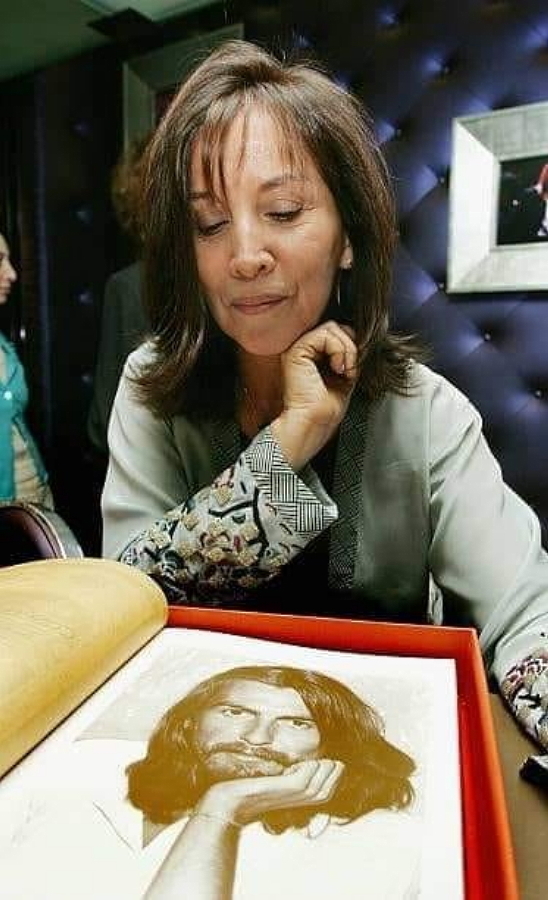  May 17, 2021 On this day in 1971, Ringo Starr's "It Don't Come Easy" enters the CFRA Hit Parade in Ottawa at #22 while John Lennon's "Power To The People" moves up one notch to #4 And here is Ringo's new release "Waiting For the Tide To Turn" 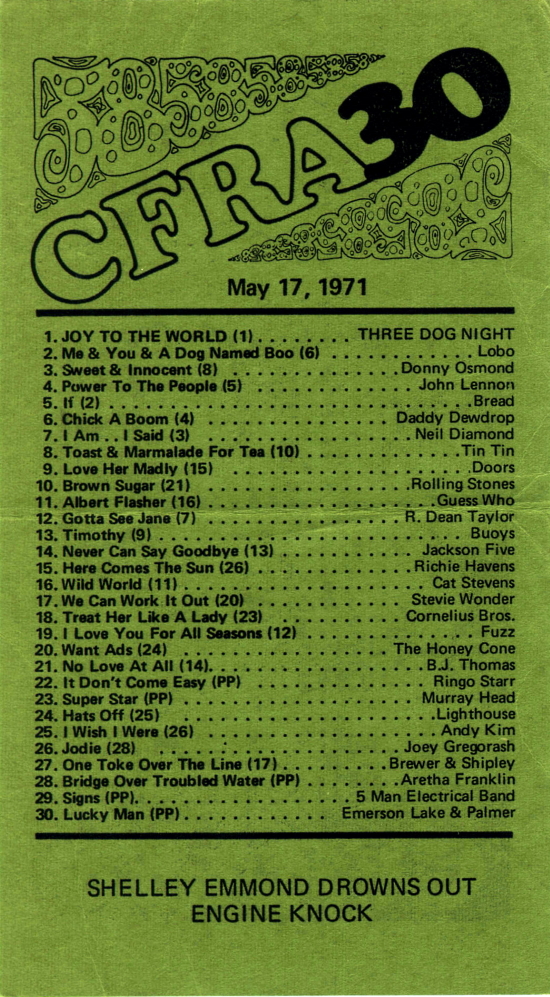 The CFRA Ottawa Hit Parade is provided by David Sampson with our sincere thanks.  May 12, 2021 Rock Hall: Tina Turner Leads 2021 Rock Hall Group of Inductees Including Billy Preston, Carole King, Jay Z, Todd Rundgren by Roger Friedman for Showbiz 411 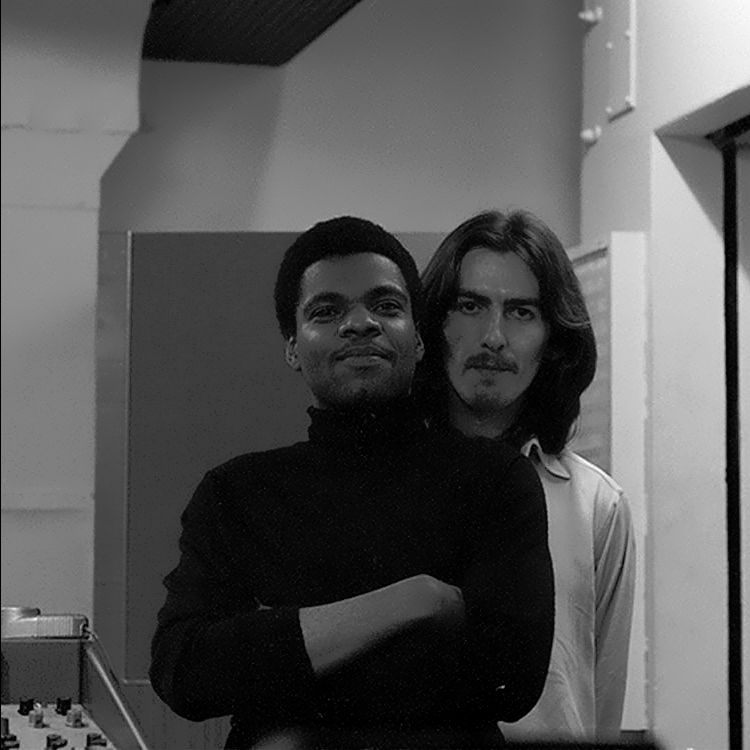 Tina Turner leads the list of inductees for the 2021 Rock and Roll Hall of Fame. Carole King, The Go Gos, Foo Fighters and Jay Z, who was dead last in fan voting, are the main class. Billy Preston and Todd Rundgren, LL Cool J are among those chosen by the Hall separate from the voting. We’ve waited a long time for Billy Preston, so congrats to his manager, Joyce Moore, for fighting to protect his legacy. Billy was the actual Fifth Beatle. As the “Let it Be” anniversary release is coming this August, Billy’s induction is right on time. For once the Hall got it completely right. John Sykes has transformed what was a mess into a success. Carole King has already posted:  Just a note on Todd Rundgren: always an innovator, like Billy Preston he had his own huge hits in the early 70s. But he also became a noted producer of everyone from Grand Funk Railroad to Meatloaf to XTC. He was way overdue. Performer Category:
Tina Turner
Kraftwerk
LL Cool J
Clarence Avant
 May 11, 2021 Classic Rock publishes a new interview with Paul McCartney that focuses on his "Ram" album  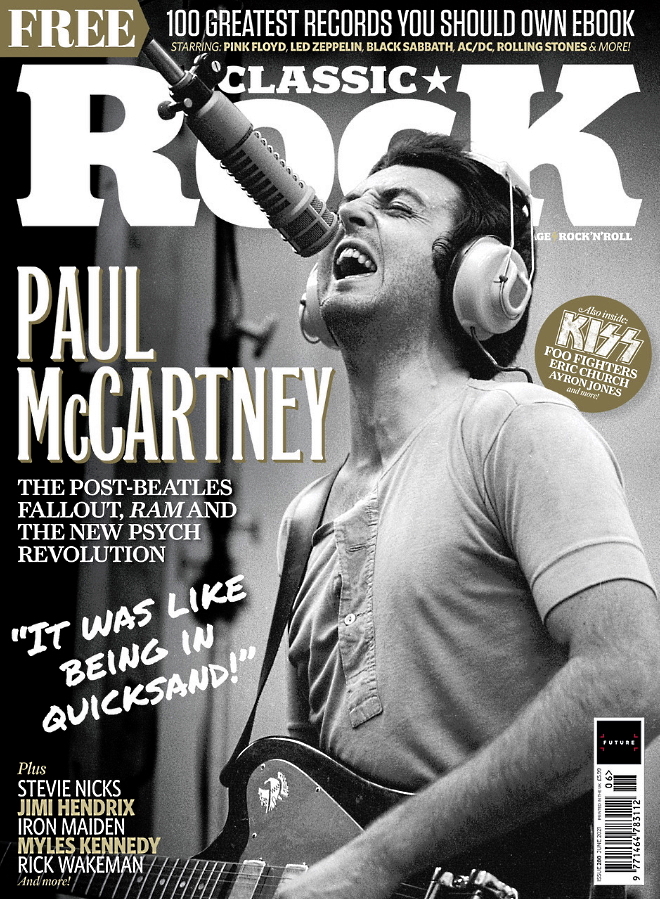 On May 6, 2021, Ringo's timeless new rocker "Teach Me To Tango" is released  May 9, 2021 A nice cartoon caricature of Paul McCartney performing "Let It Be"
 May 6, 2021 New stamps celebrate Sir Paul McCartney's 'immense legacy' 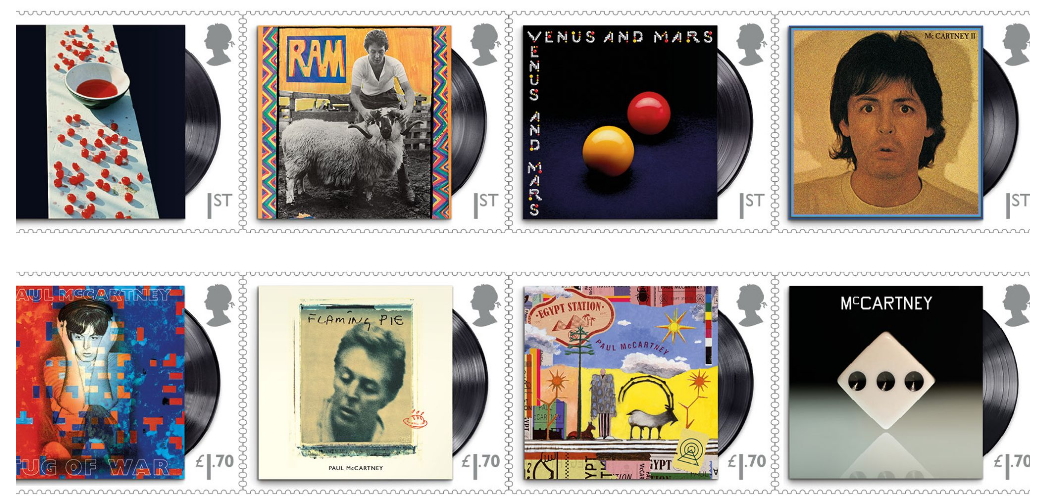 The former Beatle becomes one of only three artists to have featured in a dedicated stamp issue. A set of stamps is being launched to honour Sir Paul McCartney and his "immense" legacy in the music world. Royal Mail has revealed that the set of 12, created in collaboration with the singer/songwriter, will be on sale from 28 May. David Gold of Royal Mail said: "Paul McCartney remains a vital figure at the centre of rock and pop, an artist whose legacy is immense, but whose work continues to generate popular attention and critical acclaim. "This dedicated stamp issue is a fitting tribute to one of the UK's much loved and revered musical icons." The main set features eight LPs which have defined the ex-Beatle's career. Among them are his first solo album - McCartney - released in 1970, and his most recent number one album - McCartney III - which was recorded and released during the coronavirus lockdown in 2020. A miniature sheet of four stamps features photographs of Sir Paul in the recording studio during his career. Sir Paul is the most successful albums artist in UK official chart history, writing or co-writing 188 charted records in the UK, with 91 of those reaching the top 10, and 33 reaching number one. He is one of only three artists to have featured in a dedicated stamp issue - the others were David Bowie and Sir Elton John.
 May 4, 2021 The Witnessing Rock's Renaissance: Chris O'Dell Remembers The Beatles, Stones & Her Life As A Tour Manager
“I do believe in fate. I do believe that on a spiritual level, we all have our destiny and our things we need to do in this lifetime, and it felt to me that was mine. And no matter how hard I might have tried to avoid it, it just laid itself right down in front of me. It was like the yellow brick road just kept opening up and you just take one step forward.” For Chris O’Dell, music has always been as essential as the blood in our veins, the very lens through which she sees the world. Beginning what would become a career in the field with her very first job, a clerical position at the Los Angeles offices of Dot Records, O’Dell left California- and the firm- for England in 1968. Selling her record collection for $200, she parted ways with every precious piece of vinyl she owned in order to afford a one-way plane ticket to London. Invited by press officer Derek Taylor to work for the Beatles and their newly launched Apple Records, she arrived at the label’s first offices on Wigmore Street, completely unaware of all the magic that would follow. Initially doing odd jobs, she soon found herself working for Apple’s A&R manager, Peter Asher, and later George Harrison. In addition to booking sessions for the Beatles and their roster of Apple artists, she also spent time in the studio with the Fab Four themselves, even lending her voice to the rowdy choir that emerges in the second half of “Hey Jude.” Chronicling her years in the industry and her close friendships with some of it’s most well known personalities, her 2009 book Miss O’Dell: My Hard Days and Long Nights with The Beatles, The Stones, Bob Dylan, Eric Clapton, and the Women They Loved, follows her from the freewheeling bliss of Apple’s earliest days to her later work as one of the first women tour managers in rock. Revisiting her time as both a fly on the wall and an integral component behind-the-scenes, her story and it’s extraordinary vantage point prompted the New York Times to glowingly dub her, “Nick Carraway to classic rock’s Gatsby.”
Active in the business until the mid-1980s, she later embarked on a second career as a therapist and group counselor. Talking to Pancakes and Whiskey by phone, she retraced the events that led to her front row seat to rock’s Renaissance with a level of warmth in her voice that was palpable. Although as she admitted, it was quite a shock to see the Beatles move freely around the Apple offices when she first arrived in England. “You know they were so far away. I saw them playing in Dodger Stadium and I mean literally far away. They were little dots. And so there was no human contact to them. It almost was like you’d seen them on the screen, you’d heard their music, but they weren’t accessible. So suddenly having them be there in real life form and in the same room as you, in the same building as you, was a little jarring.” During those early days, O’Dell took any assignment she could in the hopes of eventually securing a more permanent role at the company. Describing how she originally worked there in an unofficial capacity, she laughed as she explained how at that point, everyone else “actually had been hired,” before later saying, “I went over there on a wing and a prayer. Basically, I had to make myself useful and I had to find a position for myself.” “I was twenty and so it was just a great adventure- it was like the grand adventure. I had a goal and that was to get hired. Everybody else had their jobs to do, it was just me. I mean, the only other person who had a little bit more flexibility was Richard DiLello, who had pretty much done the same thing I did. He was helping Derek, but he wasn’t an English person. You know for them, for the other employees, this was their home, this is where they lived, this is what they did. They had a job. For Richard and myself, we were in a new country and doing our best to try to make the adventure more adventurous, I think.” A multimedia company created by the Beatles to house projects under various divisions including records, retail, publishing, film and electronics, John Lennon once outlined Apple Corps Ltd. as a commercial enterprise that valued artistic innovation, famously declaring, “We want to set up a system whereby people who just want to make a film about anything don’t have to go on their knees in somebody’s office. Probably yours.” And though financial problems would later strip Apple of it’s original bohemian spirit, O’Dell spoke about the revolutionary nature of the venture and it’s optimistic beginnings, saying, “We just believed, and they believed, that what they were doing was the right thing and it was going to help people and it was going to change things in the music business. And to some degree, it really did.” “On Wigmore Street there was a tea lady who came through and brought everybody tea. That was standard fare for offices in London at that time. And it wasn’t very big. It was one floor of a building and it wasn’t extravagant. Then we moved into Savile Row into a huge four, five-story building and now there were Cordon Bleu chefs in the kitchen. It got very extravagant and the more people started taking advantage of it- I mean the employees, you know, getting taxi rides home. At that time, it was a sense of entitlement, I think that not everyone had, but some people had. ‘I’m here, I’m working late. I’m working for The Beatles, I’ll get a taxi and put it on the account.’ Now that didn’t do them in, but there were a lot of things that did. The amount of alcohol that was bought and consumed and I think some of their extravagances. So I don’t think it was immediately there, but once we were in Savile Row in ’69 it was becoming more apparent that it was getting harder for them to finance it.”
One of the few staffers to be present for their final live performance, she joined the small audience on the Apple roof as another crowd of curious onlookers gathered on the streets below. No longer “dots in the field” at Dodger Stadium, O’Dell sat only a few feet away from the band on that day in January of 1969, watching as their warm harmonies cut through the blistering cold air. Yet as iconic as the group’s surprise rooftop gig has become, she said that the Beatles had previously discussed performing at all kinds of different places, including the Grand Canyon. “They had really elaborate ideas of where they could do it, and in the end I think someone said, ‘Well why don’t you just go up on the roof?’ (laughs). And they had to prepare for it because the building was not in the best of shape. They had to prop up the roof to make sure that it held everybody, which is one reason they wouldn’t let all the employees at Apple go up.” In March of 1970, O’Dell accepted an invitation to work directly for Harrison. Moving into his newly purchased Friar Park home, she quickly forged a family bond with the Beatle and his then wife, Pattie Boyd, who remains one of her closest friends. Bought at a time when the estate was in danger of demolition and in need of repair, she remembered the 120 room Victorian Gothic mansion as an amazing place, although one that could be “exceedingly overbearing” in its size and detail. “When I lived there, and I think I talked about this in the book, it swallows you up- the house swallows you up. It’s like if you stay there long enough, you change. You become part of the house (laughs). That’s kind of what happens. Who knows why, but that’s what it’s like. It’s just such an overpowering place.” Discussing the renovations and the musician’s hands-on role in personally rehabilitating the property and it’s gardens, O’Dell said that the entire endeavor mirrored Harrison’s artistic nature and deep connection to the world around him.
“He was a highly creative person. And I think that in that place, when he was in the garden, I think he just loved that getting back to the Earth place. Where I can’t imagine the other three doing anything like that. They’d hire somebody (laughs). Again, that goes back to the fact that he kept trying to get back to his roots. Kept trying to get back, not be torn away by all the ego, and that was his spirituality. There’s no doubt about it.” Present in April when the break-up of the Beatles landed on the front page of the morning newspaper, she spoke about how she went through the “emotional trip” of McCartney’s unexpected announcement to the press through Harrison’s point of view. Although as she explained, no one dwelled on the situation for long, saying, “We quickly recovered from it at the house by thinking, ‘Ok, now George can do his album,’ because he had so much music. John and Paul had such a monopoly on the songs that were put on albums, that for him it was really frustrating. So from his point of view, it was like, ‘Well, OK-now you can do your solo album and get all those songs on there.’” As Harrison began work on what would become his first solo record, All Things Must Pass, O’Dell scheduled recording sessions and set up a make-shift office in Friar Park’s kitchen. Using a brand-new IBM Selectric typewriter, she compiled the lyrics for every potential album track. Recalling the process in her memoir, she wrote of being handed lyrics scrawled on pages taken from Apple stationary, notebooks and the backs of envelopes. Occasionally, Harrison would take a seat and play the songs she’d just typed on his twelve-string guitar. Describing his creative ambitions and genuine surprise at the album’s later success, she pointed to the different roles that often exist within a unit like the Beatles. “If you look at the dynamics of a band, you’ve got different positions in the band, kind of like in a family. Paul played the hero and John played the scapegoat or the bad dude, and George was kind of the lost child and Ringo was like the mascot. That’s kind of the family roles. I mean, as a therapist I know all of that now (laughs). So for George, being the lost child in there, being a songwriter, being younger than them, always being highly creative…I mean, his desire for fame was he couldn’t care less about all that at that point because it had gotten bigger than he really wanted it to get. So I think that this was an opportunity, but at the same time, he’d never had to hold the whole thing on his own. The confidence, musically, was not as much there for him because he hadn’t been given that position in the band to grow confidence.” Although when asked if she ever got the sense that Harrison knew he was making the masterpiece that All Things Must Pass turned out to be, she hinted at the mixed emotions that accompanied the band’s demise. “I just knew that he was excited to be able to really get into songwriting and be able to really do what he wanted to do for a solo. I think he was scared. But as a musician, it was a really good time for him because creatively he was free.” Continuing to work in the industry long after her stint at Friar Park and the subsequent breakup of the Beatles, O’Dell accepted a position with the other biggest band in the world in 1971. Working as the personal assistant to the Rolling Stones, she was entrusted with organizing details in their professional and personal lives, accompanying them on tour, booking recording sessions and typing lyrics for the soon-to-be-released Exile on Main Street. Reflecting on her time in the studio with different artists, she spoke specifically about how the Beatles and the Stones differed in their methods. “It’s very different for each group. The Beatles were pretty…I mean, it started at a certain time and it ended when it ended, but they were much more on task. The Stones always showed up late. Things got started always very late and they were OK to play all night, into the day. They were a much looser group, let me put it that way, of the two groups that I spent the most time with in the studio.” Recounting the mesmerizing experience of hearing a song in its every stage of development, she fondly recalled what it was like to see a composition take shape in real time. After saying that you never really knew what the finished product would be, she compared the creative process of those she knew as being akin to “cooking really, really excellent food- just adding this and adding that.” Even now, those different approaches underline just how crucial it was for her to be able to adapt to the style and personality of each artist she worked with. “I’d go from one job to the next job, working with a different band. And it was like, ‘Wow, Ok…’ I had to adjust to how they operate. It was like switching companies all the time in a job (laughs). You have to learn the dynamics of the band in order to really be there for them with what I did.” Discussing her years as a tour manager for a host of artists including Bob Dylan, Santana, Fleetwood Mac, Linda Ronstadt, Electric Light Orchestra, Queen and Crosby, Stills, Nash and Young, O’Dell talked about the rigors of the road and the responsibilities behind the scenes. "There was never an average day. I mean, there were normal things that had to happen everyday. If we had a flight to catch, then it was getting everybody up and out. If we had a show to do, it was organizing for the show. So it went along with what was going on that day, but you never knew what was going to show up (laughs). You never knew what was going to happen. It was exciting. In fact, if you to do that 365 days a year, you wouldn’t be able to do it. It was that hard of work.” And while the time leading up to a show could be hectic, every minute after was a chance for both the band and their crew to relax and unwind. “After a show was usually downtime. On most of the tours I did- the big ones- we always had a room, a suite, that was just for everybody to come into. There was always food and there was always drink and other things. So after the show, everybody would go there. That was my time also. Even if there were things to do, at least then you had a little let down time. I remember there were plenty of times when I’d just hang out and party and socialize with everybody. In the middle of it, somebody might say, ‘Oh, my girlfriends coming tomorrow, can you arrange a car?’ (laughs). But overall, it felt like a downtime.” After leaving the business and starting a family in the mid 1980s, O’Dell eventually moved back to where she grew up in Tucson, Arizona. Enrolling in school soon after splitting from her first husband, she earned a college degree and a master’s degree in counseling psychology and began a career as a therapist. Now remarried and living in Honduras, she spoke about he eighties as being a transitional period, before talking about the peace that has come with true retirement. “It was like living in the real world and that was hard. That was hard to make that switch, but I had to because I was a mother and I had a son, and I was a single mother. And I think that pulling away from all of that life, it was difficult. Had I stayed in London and had a life there, I probably would have remained close to that group of people. But I moved to Arizona and nobody ever comes here (laughs). But then after I decided not to be a therapist anymore, my husband and I moved. We went looking for a quiet paradise and we found one. So to me, that’s the most peaceful I’ve ever been. I’m in Tucson now, but I can hardly wait to get back to the island (laughs). That’s where life is just easy.” Offering a perspective that so few have, her memoir captures both her personal and professional journey, while also detailing key moments in rock history with a keen sense of wonder and affection. And though it remains her own story with life’s own distinct set of peaks and valleys, her recollections can’t help but expand on the essence and aura of the era and it’s music. Not one to save much, she has one trunk of memorabilia and keepsakes that stretch back to those days. Although after calling moments like having her picture appear on the back cover of Exile on Main Street just one of the many “nice things to have to remember everything by,” she said that Harrison’s 1973 song bearing her name remains one of the biggest thrills of them all. Released as a B-side, “Miss O’Dell,” remains a fan favorite, as well as something the real Miss O’Dell has always considered “an honor” of her close friend George. Today, her memories remain vivid and bright, forever woven together by the music and her own unique view from the crow’s nest of rock’s most studied and celebrated generation. The above article appeared in Pancakes and Wiskey, March 7, 2016.  May 3, 2021
The Beatles net worth:
Incredible ways the Beatles made
even more money outside the
music
In the many decades since the band split in 1970, their music has remained as popular as ever, although Beatles royalties varied, with Lennon and McCartney having most of the songwriting credits. All four had successful solo careers. Paul also formed the band Wings, George formed the Traveling Wilburys with Jeff Lynne, Roy Orbison, Bob Dylan and Tom Petty, and Ringo had his All Starrs band. In 1995 and 1996 the three surviving Beatles also released the three retrospective Anthology albums (and lucrative TV series). The first album alone went 8x Platinum in the US, with sales of over 3.6million. Together with the Beatlejuice radio show host Geoff Johns, we look at how the four musicians all diversified beyond their own music, to generate wealth in sometimes surprising ways.
Ringo Star: In 2020 Ringo was named the wealthiest drummer in the world with an estimated $350 million fortune.
He has never stopped making music and is currently waiting to get back on the road with his All Starr Band but his involvement with the TV launch of Thomas The Tank Engine in 1984 never ceases to surprise people. He actually narrated the early series from 1984-1986 and from 1989-1990 in the US.
ProducProducer Britt Allcroft said she chose him because she thought children would relate to his relaxed, jovial voice. As well as his standard fee, Ringo cleverly took a 5.1 per cent stake in the Britt Allcroft Company. It was floated on the Stock Exchange in 1996 for £30 million, then sold in 2002 for a reported £139 million.
Apart from that, Ringo also ran the construction firm Bricky Builders in the 1960s and ROR interior design company until the mid 1980s.
ROR worked on palaces in Oman and Abu Dhabi as well as British pornographer Paul Raymond’s London homes and created a range of hip furniture with clients like David Bowie, Elton John and Ted Heath.
In 1987 he opened London Brasserie, a restaurant in Atlanta, Georgia.
George Harrison died from cancer on November 29, 1991, leaving an estate that is worth an estimated $400 million today to wife Olivia and son Dhani.
If Ringo’s blockbuster kids cartoon series is impressive, George went one better by founding an entire film production company. A lifelong Monty Python fan, he stepped in when financing was withdrawn for their next film, The Life of Brian, in 1978. They needed $4million to start production and the former Beatle assured a dubious Eric Idle that he would sort it out.
Eric later said: "He mortgaged his house to put up the money for this movie because he wanted to see it - which is still the most anyone has paid for a cinema ticket."
The risky gamble paid off when the $4million movie banked $21million at the box office.
GeorgeGeorge founded Handmade Films with his business manager Denis O’Brien to get The Life Of Brian made and went on to produce critically acclaimed 1980s hits like Withnail and I, Time Bandits, Mona Lisa and A Private Function.
Unfortunately, Handmade collapsed in 1991 after O’Brien incurred major debts through fraud and negligence. Their partnership ended acrimoniously in court.
Although, this indirectly benefitted Beatles fans. Geoff Johns points out: "His reduced financial circumstances paved the way for the surviving three Beatles to reunite in the 90s for the Anthology project."
In the end, Harrison also eventually received an $11.6 million settlement over the Handmade collapse.
John Lennon was worth an estimated $200 million when he died (approximately $620 million in today’s money). Much of this came from his Beatles royalties and subsequent solo projects, but his wife was also responsible for managing and growing their wealth.
Yoko came from an extremely wealthy, upper class family in Japan (she went to school with the future Emperor Akihito) who had been part of the financial elite for many generations.
Yoko explained that she got involved after seeing the complicated tangle of finances from the Beatles era: “We weren’t financially independent; we didn’t even know how much money we had.”
She handled an ambitious investment portfolio while insisting they aimed to make ethical choices, most famously in the purchase of a dairy farm with 122 cows and 10 bulls for $2.7 million – they wouldn’t invest in beef cattle which were killed for their meat.
Any doubters were quickly silenced when Yoko sold one of the Holstein cows for a world-record $265,000 in June 1980.
John responded; ‘Only Yoko could sell a cow for a quarter of a million.”
John and Yoko also invested heavily in property around the world, as well as buying up at least five apartments in the prestigious Dakota building where they had lived since 1973. Apartments there can fetch over $11 million today.
In 1980 John said: “Yoko became the breadwinner, taking care of bankers and deals, and I became the housewife. It was like one of those reversal comedies. I’d say (jokingly), ‘Well, how was it at the office today, dear? Do you want a cocktail? I didn’t get your slippers, and your shirts aren’t back from the laundry.’ ”
Paul McCartney is currently worth an estimated $1.2 billion and has topped the lists of richest musicians for decades.
As welAs well as his royalties from the Beatles and Wings, he continues to tour and can personally bank up to $70 million each time. But his personal wealth began to outstrip his bandmates when he split from the other three to take direct control of his finances in the Beatles era, taking advice from the attorney father of his wife Linda, which lead to some incredibly lucrative investments.
Geoff Lloyd says: “Perhaps scarred by some of The Beatles’ hasty early business decisions, Paul became incredibly adept at taking the long view. He refused to join his band mates in their choice of manager, the abrasive Allen Klein, instead appointing his father-in-law Lee Eastman as his business manager, who wisely steered him to invest in the evergreen songs that had inspired him.
"It’s an approach that has served Paul well, and over the years he’s acquired one of the most valuable music catalogues in the world.”
Paul oPaul owns the publishing rights to Buddy Holly, Rupert The Bear, musicals Grease, Annie, A Chorus Line, Guys & Dolls, and standards like Mr Sandman, The Christmas Song (Chestnuts Roasting on an Open Fire) and Baby It's Cold Outside.
By 1984 he estimated that half of his income came from his publishing investments.
April 27, 2021
Ringo Starr celebrates 40 years
of marriage to wife Barbara Bach
by Amy Johnson for Yahoo news span>
Sir Ringo Starr is celebrating 40 years of marriage to Barbara Bach.
The Beatles star marked the occasion on Instagram with a throwback photo of himself and his wife on their special day of 27 April, 1981.
"It was 40 years ago today The love of my life said yes yes yes. And I said it right back peace and love," he wrote alongside the photograph.
In the photo, Starr and Bach are standing behind their wedding cake while the musician's bandmates George Harrison and Paul McCartney pose either side of them with their own spouses, Olivia Harrison and Linda McCartney.
Meanwhile, Barbara's young son Gianni from her first marriage to Count Augusto Gregorini was pictured standing in front of his mother.
Harrison's widow Olivia commented on the post: "What a day that was. I’m stunned by the passing years and each day of the love you have shared not only with each other but with the world around you.
"I love you both dearly. Happy Anniversary dear Rich and Barb."
Starr – real name Richard Starkey – was first married to Maureen Cox from 1965 to 1975. They had three children, Zak, Jason and Lee.
US-born Bach is an actor, having appeared as Bond girl Anya Amasova in The Spy Who Loved Me opposite Roger Moore's 007. In addition to Gianni, she had daughter Francesca with her first husband.
On April 23, Paul McCartney posts a rare photograph under the headline of: "Two great Georges on St George’s Day. Have a happy one - Paul" - Photo credit: Linda McCartney
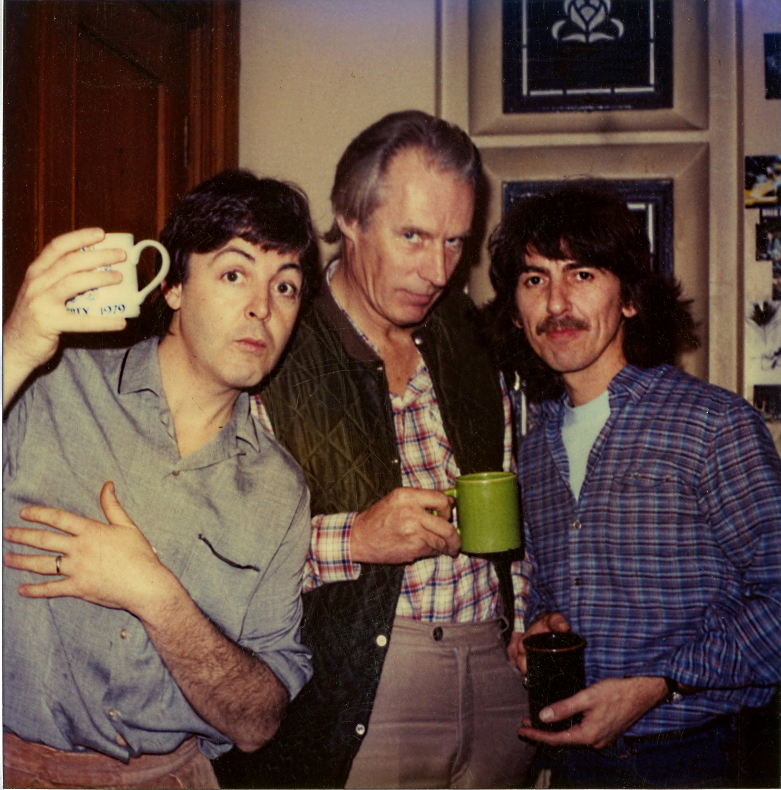
 April 23, 2021
56 years ago today the Beatles
"Ticket To Ride" went number #1 in Ottawa
April 22, 2021
A tender and young Julian Lennon
with his Dad
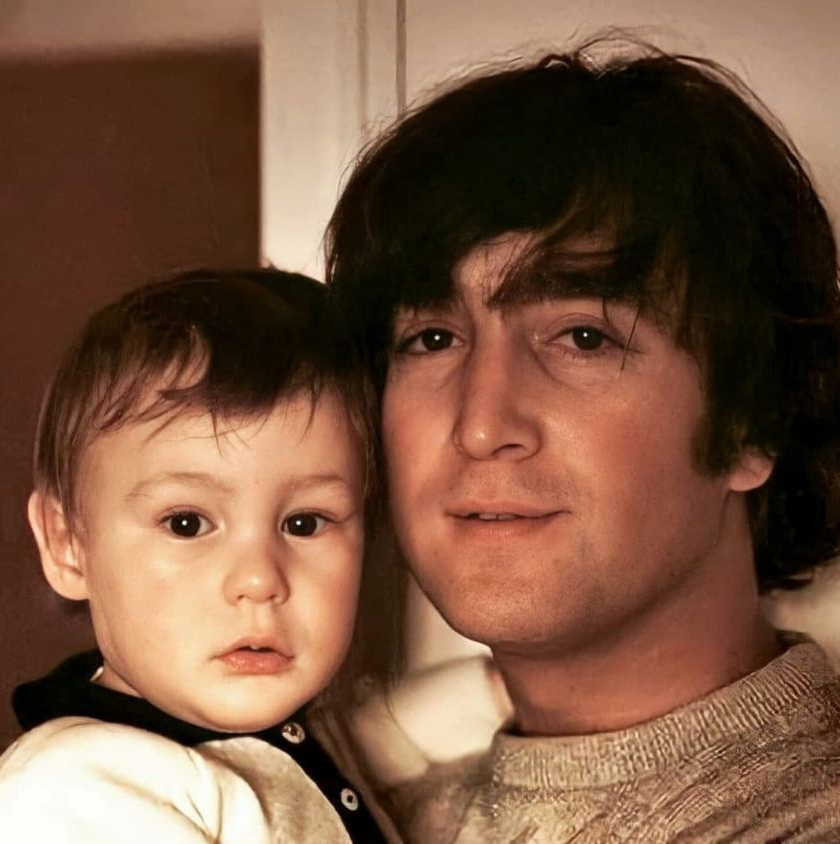  April 20, 2021
The funky sounds that were played in
Canada's capital on radio station CFRA for
the week of April 16, 1973
 CFRA Hit Parade was provided by Dave Watts, former writer, announcer, Music Director and Promotion Director for CFRA with our sincere thanks.
April 18, 2021
Guitar Autographed by the Beatles
A woman brings in a guitar she insists was signed by all four of The Beatles in 1964 in this collection of scenes from "Ticket to Pawn."
April 15, 2021 One of a kind Beatles 'White Album' set to fetch $1,000,000
|
||||||||||||||||||||||||||||||||||||||||||||||||||||||||||||||||||||||||||||||||||||||||||||||||||||||
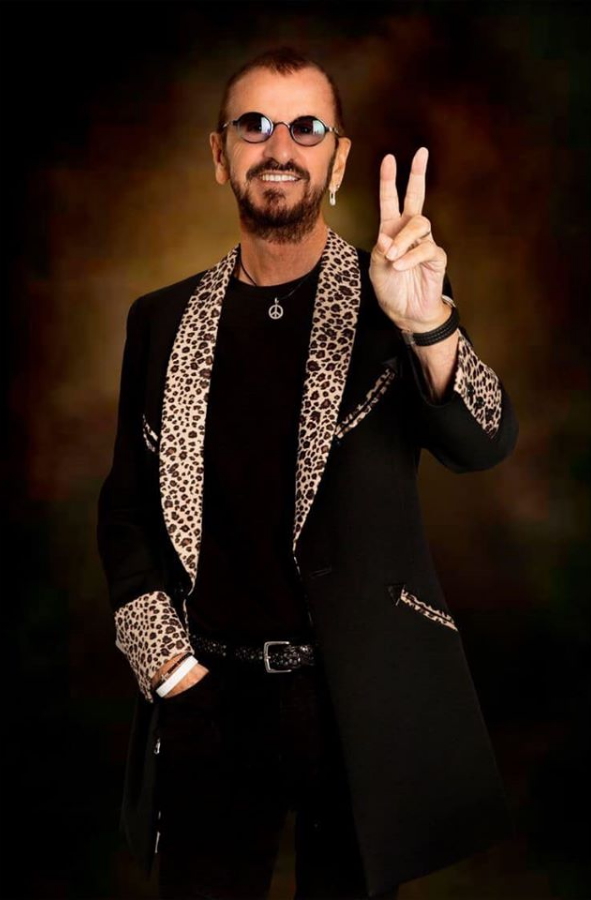 |
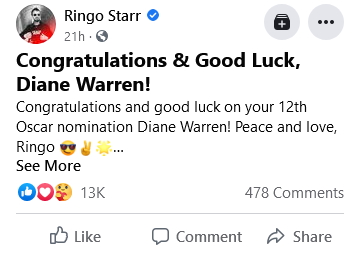 |
On this date, John Lennon's "Give Peace A Chance" demo is featured on Youtube

April 12, 2021
Remembering the greatness of John, Paul, George and Ringo: "No reverb, no autotune, no BS. Two guitars, one bass, three voices, and a simple drum set. If this were released in 2020 it would be a hit," MD poster wrote.

April 10, 2021
On this day in 1972, Ringo Starr's "Back Off Boogaloo" enters at 21st spot on Ottawa's CFRA Hit Parade

The CFRA Hit Parade is provided by David Sampson with our sincere thanks.
On Friday, April 6, 1956, Capitol Records premieres
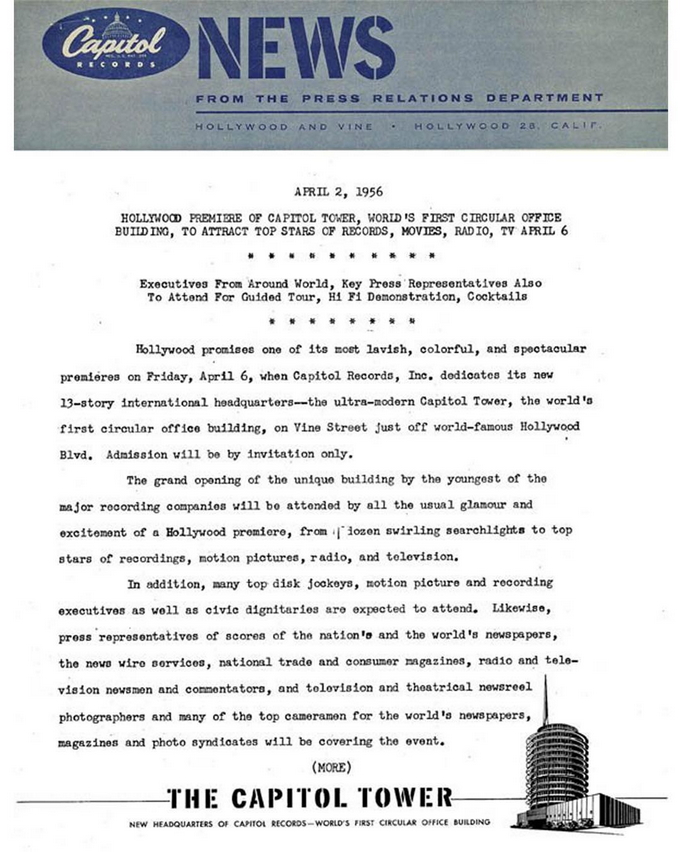

April 6, 2021
Love Me Do? ‘Quite good’, wrote John in revealing cache of Beatles letters
by Richard Brooks for the Guardian
Memorabilia from the band’s Hamburg years, sent to photographer Astrid Kirchherr, will be auctioned in May
It was the city that made the Beatles. Not Liverpool, but Hamburg, the north German seaport where, between August 1960
and October 1962, the group played more than they ever did at the Cavern in their home city.
Sixty years on, previously unseen letters, work permits and photos have been unearthed about the band’s time in Germany and their relationship with Astrid Kirchherr, the photographer best known for her stark black-and-white portraits of the Beatles taken in Hamburg before they were famous.
Letters to Kirchherr – who is credited with influencing the group’s style and signature “mop-top” haircuts – include one from George Harrison inviting her to London “to make him tea and give him cornflakes” and one from John Lennon, who mentions their just-released first single, Love Me Do, writing modestly: “It’s quite good but not good enough.”
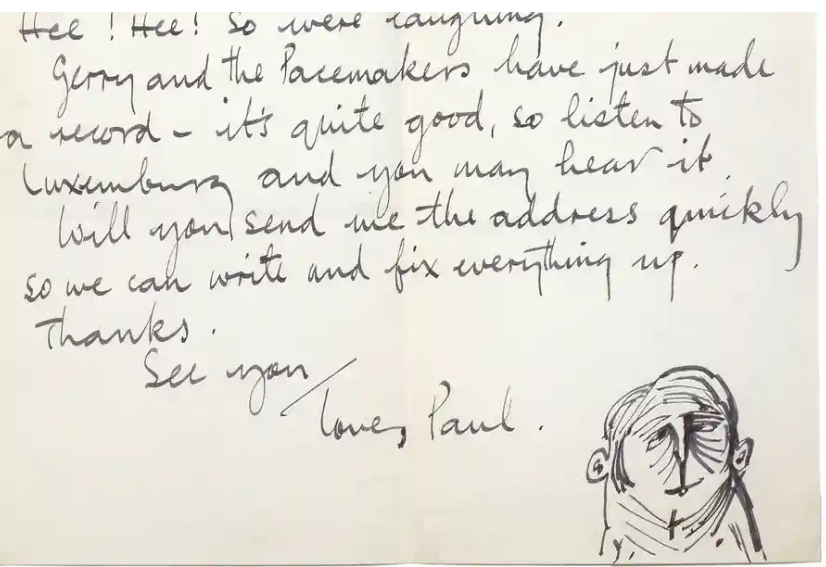
Kirchherr had been engaged to Stuart Sutcliffe, one of the group’s original members, who died, aged 21, in April 1962 from a brain haemorrhage, a year after leaving the Beatles to study art in Hamburg. The story of the Beatles in Hamburg and her relationship with Sutcliffe was told in the 1994 movie, Backbeat.
“All the Beatles were in love with her – partly, a sort of mother or elder sister love, and partly sexual,” says Stefanie Hempel, a close friend of Kirchherr for a quarter of a century until her death last year. “Astrid was so beautiful. But she also took care of them, looked after them in a spiritual and intellectual kind of way, as well as giving them a new awareness of themselves. It was much, much more than giving them their mop haircuts. In fact, she hated being known as the Beatles’ hairdresser.”
The unseen letters to Kirchherr have been owned for many years by an unidentified German man, who is now selling them at auction. Lennon’s letter, written to her from his home in Liverpool in October 1962, six months after Sutcliffe’s death, starts in his inimitable larky style. “Yes, it’s me – John Winston.” (Winston really was Lennon’s middle name). But its tone then changes. “I’m really sorry you are so sad and uncertain about yourself. You must know that Cyn, I and the other Beatles will always feel the same about you. You will always be Stuart’s Astrid to us.”
“Stuart was really the one person to whom Lennon looked up,” says Hempel, who for the past two decades has given tours and talks about the Beatles in Hamburg. “Both Astrid and John were grieving at the same time.”
Lennon’s letter adds that Cynthia is pregnant with “this little John inside her”. The baby was to be Julian, who too became a singer-songwriter.
Harrison wrote that autumn to Kirchherr about how he had recently been back in Liverpool. “Three weeks ago some boy biffed me in the Cavern and gave me a black eye. I went to hospital and had a patch put over it. Then Johnny Kidd and I walked across the road, but into the path of a bus, which knocked me down.” Kidd was the singer in Johnny Kidd and the Pirates who, ironically, wore eye-patches when performing.
Harrison then relates that he and Lennon had “just got new amplifiers and guitars – Gibson Jumbo Country and Western style”, adding that “Paul [McCartney] has a new car – a Ford Classic, which is bigger than mine”, before a comment about Ringo Starr, who had just replaced the sacked Pete Best. “He is already drumming very nice.”
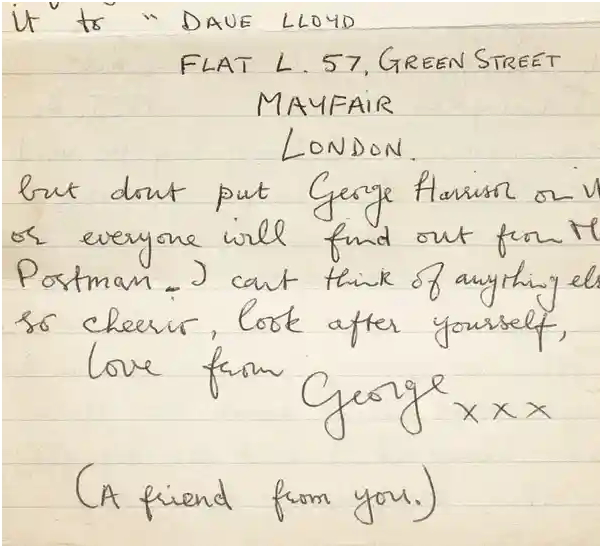
A 1964 missive from Harrison has him reminiscing about Hamburg. “I’ve found some old letters from Stu,” he writes to Kirchherr. “It seems funny reading again about the Beatles in the Top Ten club.” This was one of the city’s raucous music venues, in which they performed 92 times in 1961 alone. He then asks Kirchherr to come to London to see him and the other Beatles. “You could stay in our new London flat,” which he shared with Starr in Mayfair. Harrison suggests, “you could make us tea and give us cornflakes”.
“That’s just what Astrid and her mother did for the Beatles in Hamburg,” says Hempel. “Also, some local restaurants put cornflakes on their menus for ... other British groups performing in Hamburg.”
Harrison, however, warns Kirchherr not to use his name on the envelope in any reply. “Put on Dave Lloyd instead at our Green Street address. Don’t put George Harrison or everyone will find out from the postman.”
“George and Astrid remained very close until George’s death in 2001,” says Hempel. “Astrid would go to see George when he was living in Surrey.”
Also included in the sale at Bonhams in London on 5 May is an early 1963 letter from McCartney about the release of their first LP, Please Please Me, plus drawings and poems she received from Lennon. At the same auction, though never owned by Kirchherr, are Lennon’s German work permits plus previously unseen photos, taken by a fan, of the group leaving Hamburg airport in June 1962.
“The Beatles’ time in Hamburg was absolutely crucial to them,” says Katherine Schofield, Bonhams’s head of entertainment memorabilia. “It’s fair to say that they came to Germany as boys and left as men.”

April 4, 2021
Special Feature: the Control Room where radio station CFRA would spin those Beatle tunes
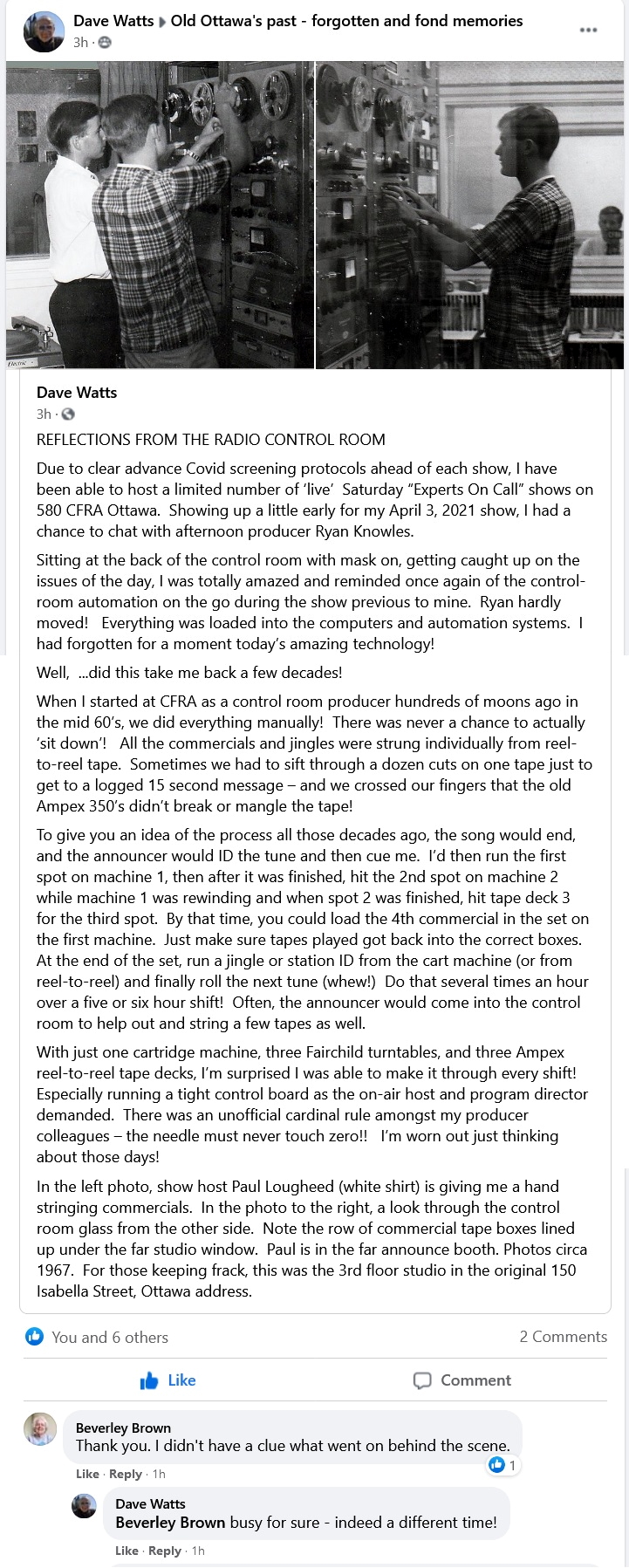
The above article appeared on Facebook's "Old Ottawa's past - forgotten and fond memories" on April 4, 2021.
Many thanks to Dave Watts recounting his fond recollections about Ottawa's #1 radio station: CFRA. Dave Watts is a former
writer, announcer, Music Director and Promotion Director for CFRA.

April 3, 2021
Student Dispatch: Paul McCartney Visits Princeton Songwriting Course
by Anna Allport for the Princeton Alumni Weekly
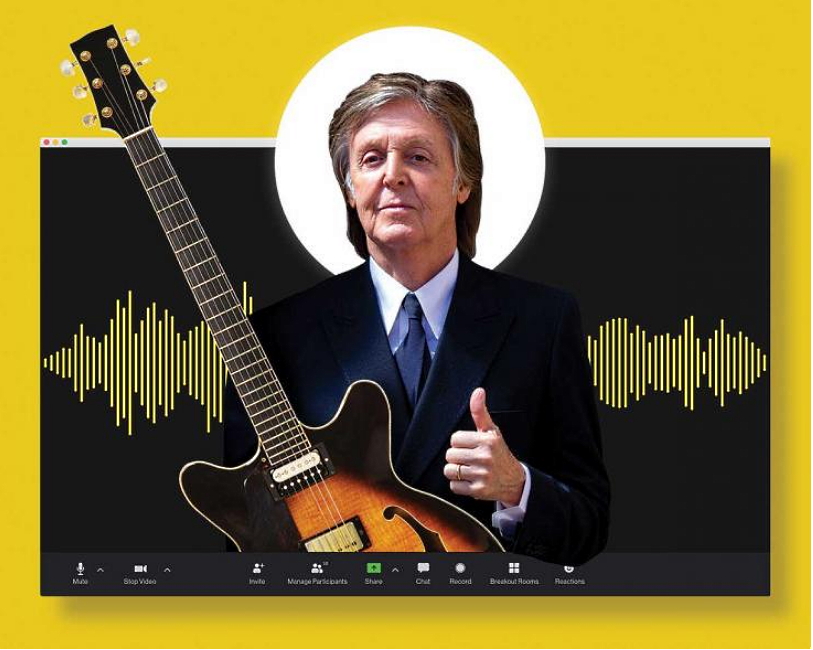
Photo credit: Edmon de Haro, Steve Parsons/AFP via Getty Images (detail of a 2018 photo of McCartney), iStock (guitar)
Students on the class Zoom call could barely believe their eyes. Some gasped. Others cheered. A few started crying tears of joy.
“IS THIS REAL?” asked Glenna Jane Galarion ’21 in the Zoom chat, as Sir Paul McCartney logged onto the Princeton Atelier course “How to Write a Song.” The students had the rare opportunity to have their work critiqued by the legendary Beatles musician and songwriter when McCartney, calling from New York, joined their virtual classroom in February.
“When we started listening to [my group’s] song, Paul McCartney started bobbing his head,” Galarion told PAW. “And I thought, ‘No way is Paul McCartney, the greatest songwriter in music history, grooving to our song right now!’”
“How to Write a Song,” taught by poet and Princeton creative writing professor Paul Muldoon, has been offered at Princeton in various forms since 2010. Bridget Kearney, a songwriter and bassist for the band Lake Street Dive and a former guest artist in the course, is co-teaching with Muldoon this year.
“We have an inordinate amount of fun in our class,” Muldoon said. “Every last one of [the students] is talented in some way.”
Every week, the 33 students in class are given a theme by Muldoon and Kearney, such as “protest” or “desire,” and hear a musical lesson from Kearney on elements including harmony, meter, and orchestration. They work in groups of four or five, and each group’s homework is to write and produce a full song. Class time is spent reviewing and discussing each song.
During the third week the theme was “loss,” and a new Zoom participant mysteriously labeled “Test Student” popped onto the screen. Unbeknownst to the students, Muldoon had reached out to McCartney about visiting. The two have known each other for years; the Pulitzer Prize–winning poet is collaborating with McCartney on the musician’s recently announced lyrical autobiography, due out in November.
When the students got over their initial awe, they settled in for a workshop full of incisive musical analysis and charmingly off-the-cuff stories.
McCartney listened as each group played its recording for him, and he gave specific advice to improve each song. He suggested that one group move an intriguing lyric to the top of its song, to grab listeners’ attention. He advised another that words should be sung as naturally as they are spoken — the flow of language shouldn’t be sacrificed for the sake of rhythm.
“He gave a lot of great advice on structure,” said William Hunt ’23. Anna McGee ’22 cited the “empowering feeling” of having McCartney critique her work, and Rohit Oomman ’24 appreciated learning to “let go of the idea of perfect.”
Several of the students said McCartney has been influential in their songwriting. “Paul McCartney is a genius,” said Oomman. “His influence is so far-reaching that it’s not really a question of ‘How has he influenced me?’ It’s like, ‘How has he not?’”
Muldoon has hosted other notable artists in past semesters, including Paul Simon, Rosanne Cash, and Steve Martin, but the class is “not about having stars in the room,” he said. “It’s about giving the students the opportunity to have a response to their work by another artist in the field.”
“How to Write a Song” is traditionally offered in person, featuring an end-of-semester concert of live student performances. Transitioning to Zoom, though, has allowed students to learn more about professional recording and production (key for future personal Spotify releases), and as Muldoon and Kearney noted, Zoom also facilitated McCartney’s surprise visit.
McCartney seemed inspired by the class. He told the students, “I must say, I love to see the young talent. And the kind of hopefulness. And the joy. The positivity. You know, even if it’s a sad song, just the fact that you wrote it is positive. And so, as far as I’m concerned, any message I can give you guys is: Hold onto that.”

April 2, 2021
John Lennon's "Look At Me" new ultimate mix

For further details, please click here.

April 1, 2021
Retrogroove Flashback: Ringo Starr's "Oh My My" starts climbing up the CFRA charts while Paul McCartney's "Jet" hits the #2 position during the first week of April, 1974

CFRA Hit Parade provided by Dave Watts with our sincere thanks.


March 30, 2021
From Japan's nippon.com news page...


March 28, 2021
Please please me: Celebrating 58 years since The Beatles’ debut

Justin O’Toole/THE REVIEW
Staff reporter Liz Hartshorne pays tribute to the band everyone’s still in love with nearly six decades on.
By Liz Hartshorne for the Review
On March 22nd, 1963, The Beatles released their first album titled “Please Please Me”. No one really knew how much music history this 32 minute album would kick off in the 1960s, but it definitely started a whirlwind of a life for John, Paul, George and Ringo. Voted 39th on Rolling Stone magazine’s list of the “500 Greatest Albums of All Time,” this is “Please Please Me.”
I was able to get my hands on a “Please Please Me” original record a few years ago when I was given a turntable for my 16th birthday and started collecting vinyl records. Although it was the first full album that The Beatles released, it was not the first Beatles record that I could find at a record store.
I began listening to The Beatles at a very young age; I think I was about three or four years old. But I didn’t listen to their earlier albums, like “Please Please Me” and “With The Beatles” until years later when I really began to appreciate the history of the band. Most people my age only know The Beatles for their most famous albums like “Magical Mystery Tour”, “Sgt. Pepper’s Lonely Hearts Club Band”, “Let It Be” and, of course, “Abbey Road” that have cemented their place in music history. But listening to their earlier music in addition to their late 1960s hits shows how far the band has come and how well they changed with the times by their different sounding albums. Each one of The Beatles albums, with the exception of “Please Please Me”, “With The Beatles” and “Help!”, sounds completely different, and that is one of the many reasons why I’ve come to love The Beatles.
George Martin was the band’s producer and was commonly known as “the fifth Beatle” because of his involvement in each and every one of The Beatles’ original albums and the films that were produced starring The Beatles. He also had a lot of say in when singles would be released and which songs would be on the record. Martin originally thought about recording “Please Please Me” at the Cavern Club, the famous club in Liverpool, England where The Beatles were first discovered. There, they performed songs like “Please Mr. Postman,” “Roll Over Beethoven,” “Till There Was You,” “Tutti Frutti” and “Twist and Shout.”
In their Cavern Club days, The Beatles were not yet called “The Beatles,” they were called “The Quarrymen.” One of their first songs they performed at the club was the song titled “In Spite of All The Danger,” a song that I’ve actually heard McCartney sing live at a couple of his concerts within the past few years that he’s gone on tour. He normally plays around 40 songs at his concerts and always makes sure to add in this “Quarrymen” original song, which is always such a nice tribute to the start of the band that everyone in the audience knows and loves.
Having the album recorded at the Cavern Club would have been a good place to start for the band’s first album, but Martin ended up landing them a recording with EMI Records in London, England. The Beatles took all day to record the album by doing their set of the album, song by song. They recorded their cover of the song “Twist and Shout” by The Isley Brothers last because Lennon had a nasty cold the day they recorded the album. They chose to do this because Martin was worried that Lennon’s big solo section in the song would make him sound worse on the rest of the album. It is difficult to notice, but while listening to Lennon’s singing parts on the record, you can kind of notice that his voice was a little bit raspy, and he sang at a lower pitch than he sings in later recordings of their music. While listening to the record on my turntable, I noticed Lennon’s raspy voice the most in the songs “I Saw Her Standing There” and “Misery.”
Just like music today, most artists chose to release a “single” song off of their album to kind of give it a head start in the media and the public. Of course, because in the 1960s the singles would be released on two-sided records, two songs needed to be picked. So, The Beatles decided to release “Love Me Do” / “P.S. I Love You” as their first single off their debut album a few months before the whole record was released. When they began recording the song, Martin had suggested that they use an instrument like a harmonica, an instrument that was used in multiple hit songs in the early 1960s. The Beatles are historically known for their very original sounding songs, and the use of the harmonica in “Love Me Do” was the beginning of their original trademark.
The Beatles’ started out being credited as just “McCartney-Lennon” because John and Paul wrote most of the songs on the album. Out of the 14 songs on “Please Please Me”, McCartney and Lennon wrote eight of them, including “Love Me Do.” Many Beatles listeners know “Love Me Do” as their debut single. That is exactly what it was. The record peaked at number 17 on the U.K. top music charts. The song was also released in America but not until 1964. It wasn’t long after it’s debut in America that the song became a number one hit.
But what some Beatles listeners don’t know is that McCartney wrote most of this song when he was only 16 years old. McCartney was always one to chase trouble, especially when he was younger. McCartney has gotten in trouble at school for skipping class and was suspended for a few days. So, why not write a hit song? The song was not yet finished though, which is where Lennon’s contribution came in. Lennon and McCartney sitting down scribbling songs in their notebooks together, like they did while writing “Love Me Do” and hundreds of other songs, was the start of something big that they were not yet aware of.
The album cover ended up being quite memorable as well. After weighing many ideas that Martin had for the cover, they went with what seemed to be the simplest of all ideas: a friendly photograph of the group looking down from the stairwell of EMI Records, where the band had recorded the album. The photo was later remade for the cover of their blue compilation album, consisting of their songs from 1967-1970, including songs from “Magical Mystery Tour”, “Sgt. Pepper’s Lonely Hearts Club Band”, “Abbey Road” and “Let It Be.” The compilation album also included several singles that did not appear on any Beatles albums, such as “Lady Madonna,” “Hey Jude” and “Revolution.”
Every band has to start somewhere, but it is astonishing how much of an impact The Beatles had on music and society, starting with their debut album in 1963. “Please Please Me” remained on the top charts in the U.K. for 30 weeks that year and remains known as the record that started an earth-shaking decade in music history.

March 27, 2021
The latest video updates from Ringo and Paul

March 26, 2021
Turkuaz improvised cover ending on "Rain" will surprise Beatle fans!

March 25, 2021
The Confidant in the Shadows - Neil Aspinall
by the Beatles Story Liverpool, originally published on March 22, 2021
Debate amongst Beatles lovers across the world continues in regard to the identity of the true ‘Fifth Beatle’. Yet when immersed in the life and times of The Beatles, one finds the task of identifying a sole person very difficult. You see, The Beatles were the Fab Four and quite rightly so, but their success is shared with many others who helped them along their journey.
In this series of special blog posts, we will explore the lives and roles of those who were very much integral to the growth and evolution of The Beatles over the years.
Road manager turned CEO of Apple Corps, Neil Aspinall was involved in every aspect of The Beatles and their rise to global stardom, this is his story…

Photo credit: Getty Images
Born in Prestatyn in 1941, Neil met Paul and George at the Liverpool Institute, an all-boys grammar school in the city. Although George was the year above them both, Neil remembers the first time they met;
“My first encounter with George was behind the school’s air-raid shelters. This great mass of shaggy hair loomed up and an out-of-breath voice requested a quick drag of my Woodbine. It was one of the first cigarettes either of us had smoked. We spluttered our way through it bravely but gleefully. After that the three of us did lots of ridiculous things together. By the time we were ready to take the GCE exams we’d added John Lennon to our ‘Mad Lad’ gang…”
After school, Neil went on to study accountancy and was a trainee accountant for 2 years. He enjoyed music and had a membership for the Casbah Coffee Club ran by Mona Best where The Beatles as we know them today first played as The Quarrymen and then as The Silver Beatles with Pete Best as their drummer. Neil became a close family friend of the Bests and eventually rented a room in their house. It was Pete Best who asked Neil in 1961 to be the band's part-time roadie and from there, his relationship with The Beatles grew stronger.
Eventually, Neil gave up his studies and became their full-time road manager. During this time, he also developed a romantic relationship with Mona Best and their child was born in 1962. When Pete Best was sacked as their drummer by Brian Epstein, Neil felt a massive loyalty for Pete and indicated that he would quit as a result. Due to Pete’s encouragement and belief that The Beatles were going places, Neil continued to work for them whilst maintaining his friendship with Pete.
As The Beatles continued to grow and their entourage got bigger, Neil became more of a personal assistant to the band working closely with Brian Epstein. Always just out of the camera shot, he went everywhere with the band. He was a great friend, helping them remember lyrics to songs, offering relationship advice and even standing in during rehearsals if anyone was sick, as was the case during rehearsals for The Ed Sullivan Show when George caught tonsilitis. As Beatles biographer Hunter Davies states, he was one of the ‘paid mates’, who the fab four trusted unconditionally.
Neil’s training in accountancy never did go to waste because come 1967, he was asked to head Apple Corps - a role which he officially held for over 30 years. Throughout the years, he played an integral role in managing the band's numerous commercial interests. This included overseeing various lawsuits and most notably producing The Beatles Anthology, where his friend Pete Best would finally receive royalties for the part he played during the early years of the band.
On this day, we remember the extraordinary life of Neil Aspinall who sadly passed away after a battle with lung cancer in 2008. He is survived by his wife Suzie Aspinall, 3 daughters and 2 sons. He is remembered as a fierce protector of the band’s legacy who always had their best interests at heart. As an insider, he never did publish any memoirs but his story is remembered through The Beatles Story exhibition and will continue to be shared with visitors from across the world.

March 23, 2021
How the Beatles Ditched Psychedelia With Lady Madonna
by Nick Deriso for Ultimate Classic Rock
The Fats Domino-inspired "Lady Madonna" served notice
that the Beatles' technicolor dream was over.
Released in March 1968, this account of an exhausted,
probably single mother facing down daily problems is as
lean and rootsy as 1967's Sgt. Pepper's Lonely Hearts
Club Band was layered and kaleidoscopic. Named in a
clear reference to his Catholic upbringing, "Lady
Madonna" also served as a stopgap as the Beatles
prepared for a trip to India where they'd study
meditation with Maharishi Mahesh Yogi.
"'Lady Madonna' was me sitting down at the piano trying
to write a bluesy boogie-woogie thing," Paul McCartney
said in Barry Miles' Many Years From Now. "I got my left
hand doing an arpeggio thing with the chord, an
ascending boogie-woogie left hand, then a descending
right hand. I always liked that, the juxtaposition of a
line going down meeting a line going up. That was
basically what it was. It reminded me of Fats Domino for
some reason, so I started singing a Fats Domino
impression."
McCartney's intro likewise tipped his hat to Humphrey
Lyttelton's 1956 hit "Bad Penny Blues," which was also
produced by George Martin. Lyttelton later revealed that
he took this quote at the piano as a compliment.
"I've never had any sympathy with the notion of 'Here
are some guys, they're worth a fortune. Let's try and
get some of it,'" Lyttelton said. "Although none of the
Beatles cared for traditional jazz, they all knew and
liked 'Bad Penny Blues,' because it was a bluesy,
skiffley thing rather than a trad exercise."
McCartney's dad sidelined as a jazz musician, but this
latest tribute to steadfast women was mainly inspired by
his mom – a midwife who served as the family's principal
breadwinner before her too-early death. So, "Lady
Madonna" was tougher than "Eleanor Rigby" or "Lovely
Rita" – and far more worldly.
Every line is sharpened to a knife's edge, as she
muscles her way through another difficult week. The
Beatles' only look back from this gritty scene arrives
with the line "see how they run," a double entendre
about her worn-out stockings that echoes a John Lennon
lyric from the previous year's "I Am the Walrus."
The spark for McCartney came courtesy of a photograph of
a Malayo-Polynesian woman caring for three small
children, taken for National Geographic in 1965 by
Howard Sochurek.
"I saw that as a kind of Madonna thing, mother and
child, and I just – you know, sometimes you see pictures
of mothers and you go, 'She's a good mother,'" McCartney
told National Geographic in 2017. "You could just tell
there's a bond and it just affected me, that photo. And
so I was inspired to write 'Lady Madonna,' my song, from
that photo."
Still, it wasn't all so serious. Lennon and George
Harrison joined McCartney for background vocals that
imitated brass instruments during the instrumental break
before bringing in four saxophonists – including the
legendary Ronnie Scott – to complete the session.
Unfortunately, Scott's solo was buried in the mix until
the Anthology series salvaged it by combining elements
of takes three, four and five.
"Lady Madonna" entered the U.K. charts at No. 5 in late
March, then spent two weeks at the top. The single was
halted at No. 4 in the U.S., but nevertheless made
history of another sort.
The Beatles had originally considered releasing "Across
the Universe," but Lennon withdrew the song because he
wasn't happy with the arrangement. Harrison was the
beneficiary, as they paired "The Inner Light" with "Lady
Madonna" to fashion his first original B-side. In a cool
twist, Fats Domino also covered "Lady Madonna," and it
became his 77th – and final – U.S. charting song.
Only later did it occur to McCartney that the song had a
timeline error. "I was writing the words out to learn it
for an American TV show and I realized I missed out
Saturday; I did every other day of the week, but I
missed out Saturday," McCartney told Miles. "So, I
figured it must have been a real night out."

March 22, 2021
The songwriting advice John Lennon gave to Joni Mitchell
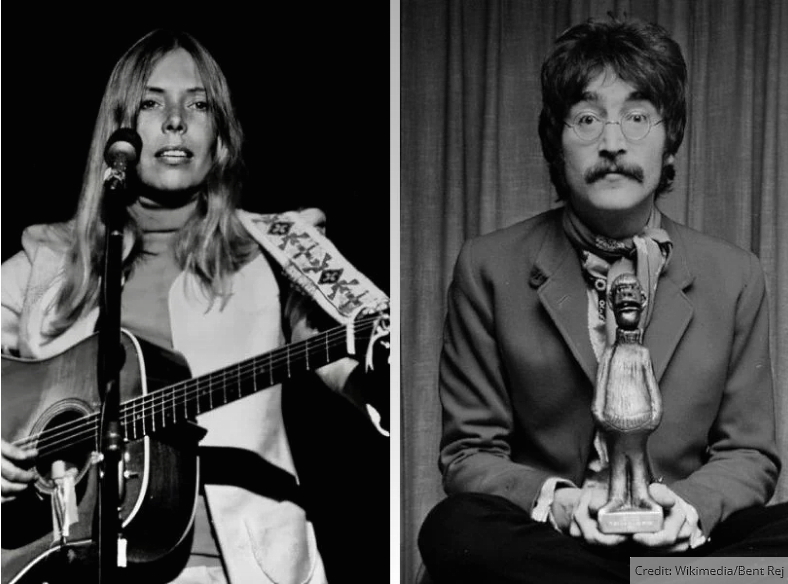
John Lennon and Joni Mitchell are undoubtedly two of the finest songwriters of all-time. Still, their approach to music came from opposite ends of the spectrum; that’s if Mitchell’s debut encounter with the bespectacled Beatle is anything to go by. It was during this first meeting when Lennon decided to give the folk singer some career advice.
The source of contention that led to Lennon handing out words of wisdom to Mitchell came from one of the standout singles from Mitchell’s album Clouds — the track, ‘Both Sides Now‘. It remains, to this day, as one of Mitchell’s most iconic compositions. Mitchell is said to have written ‘Both Sides Now’ in March of 1967, after being inspired by a passage in Saul Bellow’s novel Henderson the Rain King.
However, the song is best known by Judy Collins’ version and charted at eight in the States, a whole year before Mitchell would get round to sharing her own version of the track. Lennon found this staggering. The singer was perplexed by the idea that an artist wouldn’t protect a track like ‘Both Sides Now’ at all costs and, what’s more, allow their friend to have a hit with it.
Once commenting about the track, Mitchell noted: “I was reading Saul Bellow’s Henderson the Rain King on a plane and early in the book ‘Henderson the Rain King’ is also up in a plane. He’s on his way to Africa, and he looks down and sees these clouds. I put down the book, looked out the window and saw clouds too, and I immediately started writing the song. I had no idea that the song would become as popular as it did.”
The most famous example of Lennon giving away a song came when The Beatles allowed The Rolling Stones to have their first hit with ‘I Wanna Be Your Man’. Lennon later commented: “It was a throwaway. The only two versions of the song were Ringo and the Rolling Stones. That shows how much importance we put on it: We weren’t going to give them anything great, right?”
During a television appearance in the ’90s, Joni spoke of ‘Both Sides now and joked about people not realising that the track written by her, not Judy Collins. Mitchell revealed that people come up to her on the street and ask,” ‘How did you get Judy to give you permission to sing her song?”.
This unselfish approach to music epitomises Mitchell, but it’s fair to say that most artists of her size would hoard their best work rather than letting their friends have it. During the same appearance, the singer recounted the words of warning that John Lennon gave her about this the first time they met each other.
“When I met John Lennon, it was during his lost year in LA y’know, and he came up to me to say, ‘Oh it’s all a product of overeducation, you want a hit, don’t you?’,” she says in her best Scouse impression, which if you’re from the UK, sounds just like a typical American attempt at a standard British accent — the kind that sounds like absolutely nobody in reality. But it’s the effort from Mitchell that counts.
“I was cutting Court and Spark; he was cutting across the hall, so I played him something from Court and Spark,” Mitchell remembers before resurrecting her best Lennon impression once more. “He said, ‘You want a hit don’t you? Put some fiddles on it! Why do you always let other people have your hits for you y’know?'”,” she adds before bursting into laughter.
Even if John Lennon would have you believe that all he cared about was expressing his artistry, his comments to Mitchell show that the former Beatle loved searching for a hit record, and few people managed to strike gold as often as Lennon. Whereas Mitchell’s road to success was a route less travelled and hit records were never on the horizon of her desires. Instead, she chose a purer artistic road, something she would have done with or without Lennon’s words ringing in her ears.

March 18, 2021
Paul McCartney to release new picture book 'Grandude’s Green Submarine'
It's the sequel to 2019 best-seller 'Hey Grandude'
by Nick Reilly for New Music Express

Paul McCartney has announced the release of ‘Grandude’s Green Submarine’ – his second picture book.
A direct sequel to 2019’s ‘Hey Grandude’, the book is set for release on September 2 and continues the adventure of the eponymous grandfather and his grandchildren as they set off on a quest to find their music-loving grandmother, Nandude.
McCartney previously explained that the lead character’s name is taken directly from the nickname that his grandchildren are known to call him.
‘I’m really happy with how Hey Grandude! was received as this was a very personal story for me, celebrating Grandudes everywhere and their relationships and adventures with their grandchildren,” McCartney said.
“I love that it has become a book read to grandkids at bedtime all around the world. I always said if people liked the first book and there was an appetite for more I would write some further adventures for Grandude – so he’s back and this time with his special invention, Grandude’s green submarine!”
Illustrator Kathryn Durst said: ‘I am so thrilled to be collaborating with Paul again on Grandude’s Green Submarine. I think this is the adventure book we all need during this time, when everyone is stuck at home and longing to travel to exciting new places.
“I really enjoyed drawing the newest character in the book, Nandude, particularly because we both share a love of playing the accordion!”
Meanwhile, McCartney announced last week that he is to release a reimagined version of last year’s ‘McCartney III’, featuring re-workings of the album from the likes of St Vincent, Beck, Damon Albarn, Phoebe Bridgers, Josh Homme and many more.

March 16, 2021
Ringo Starr, 80, looks incredibly youthful as he makes surprise appearance at Grammys to present Record of the Year
by Rachel McGrath for the Daily Mail
Ringo Starr made a surprise appearance at the Grammy Awards in LA on Sunday night.
The Beatle, 80, took to the stage during the live telecast to present the final trophy of the evening, the award for Record of
the Year.
'After a year when we've all been zooming in and zooming out, it's great to be here. In fact, it's great to be anywhere,' he
quipped.
Ringo, who lives in LA with his wife Barbara Bach, will release a new EP Zoom In on Friday as well as his new book, Ringo Rocks: 30 Years of the All Starrs 1989-2019.
He wore a black t-shirt with a rainbow-hued peace sign on the front and black drawstring pants with red stripes down the sides.
He completed his ensemble with a black leather jacket and sported dark glasses.
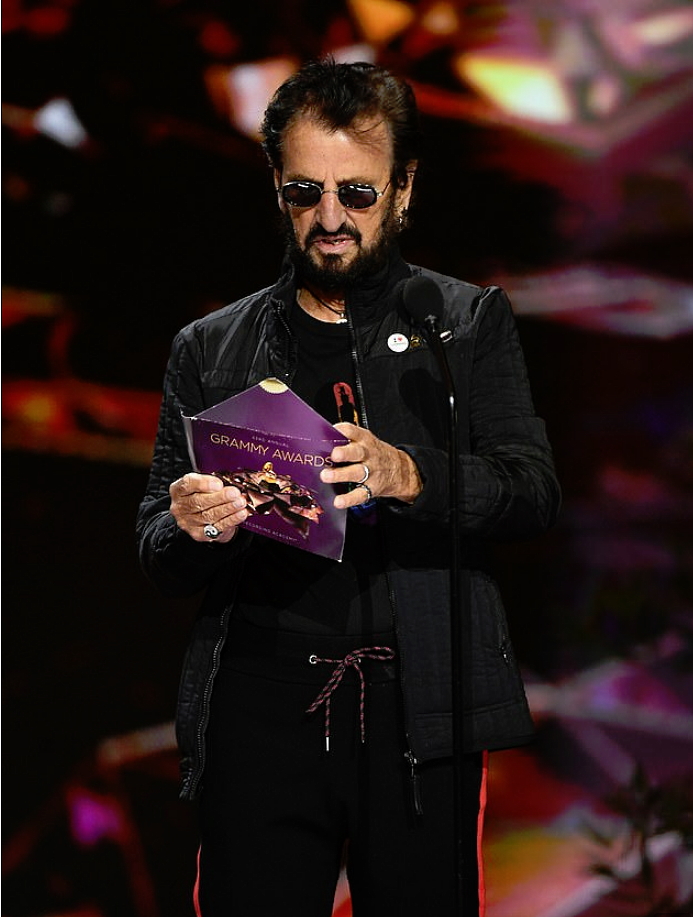
Flashing his signature peace sign, Ringo shared he was 'honored' to be a part of the Grammys, which this year were held in a socially-distanced ceremony at the Los Angeles Convention Center.
'I want to say this with peace and love to all of these gifted nominees: If you're making music in our world today, you've already won. And I thank you,' he said.
He then opened the purple envelope and announced the Record of the Year winner as Billie Eilish for Everything I Wanted.
Billie and brother Finneas appeared shocked when Ringo announced the winner and seemed a little overcome to be on stage with the legendary rock star.
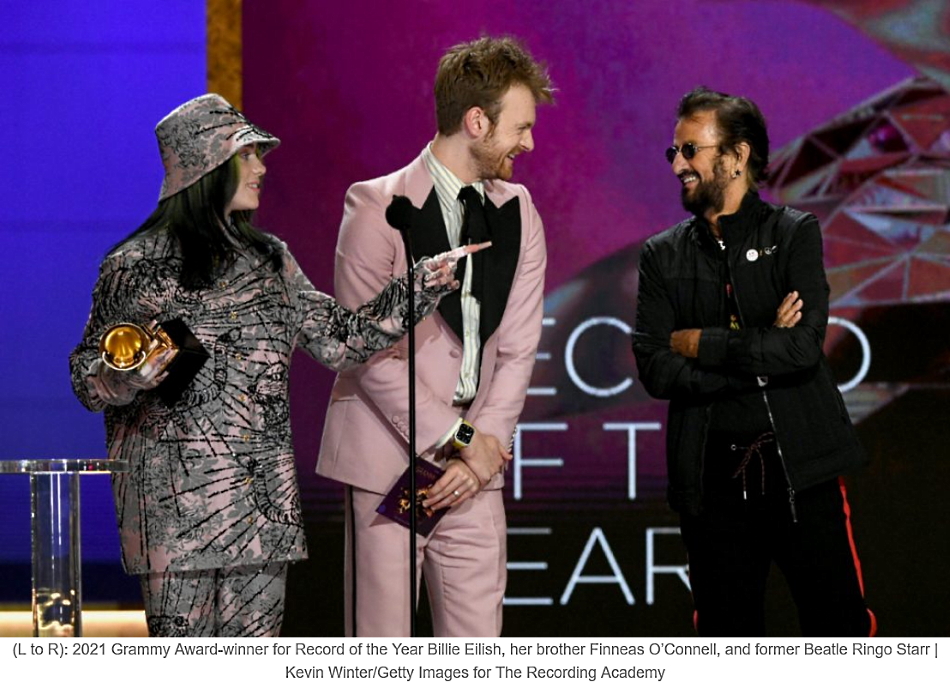
Billie, 19, also made out that she wished fellow nominee Megan Thee Stallion had won in her stead.
She began her acceptance speech with, 'This is really embarrassing for me.'
She went on: 'Megan, girl, I was going to write a speech about how you deserved this, but then there is like there is no way they will choose me, I was like it's hers. You deserve this. You had a year that I think is untoppable. You are a queen.'
The teen added: 'You are so beautiful, you are so talented. You deserve everything in the world. I think about you constantly. I root for you always. You deserve it, honestly.'
Billie then went on to thank the Recording Academy for her win, saying: 'I really do appreciate this.'
The Stephen Colbert Show - Ringo Starr: Peter Jackson's Documentary Captures The Fun Of Being In The Beatles

March 15, 2021
The Beatles "Nowhere Man" goes number #1 on Ottawa's Radio Station CFRA
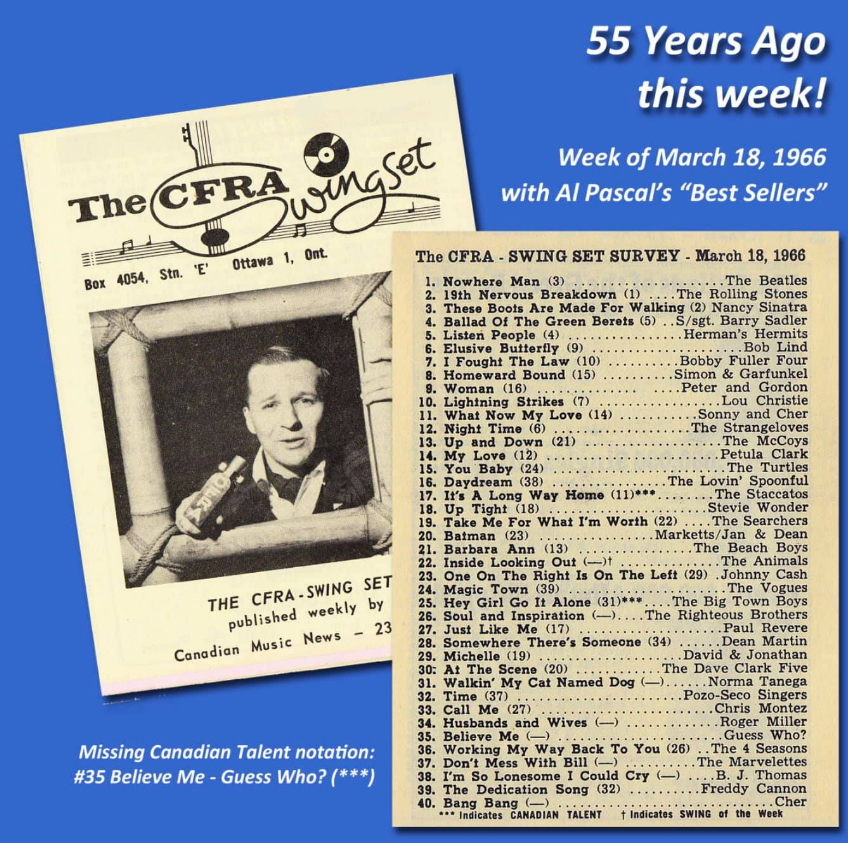
Dave Watts writes:
"AL PASCAL’S ‘BEST SELLERS” ON 580 CFRA, Ottawa
Dave Watts is a former Writer, Announcer, Music and Promotion Director for CFRA.

March 14, 2021
George Martin Early Electronic Recordings to Be Reissued
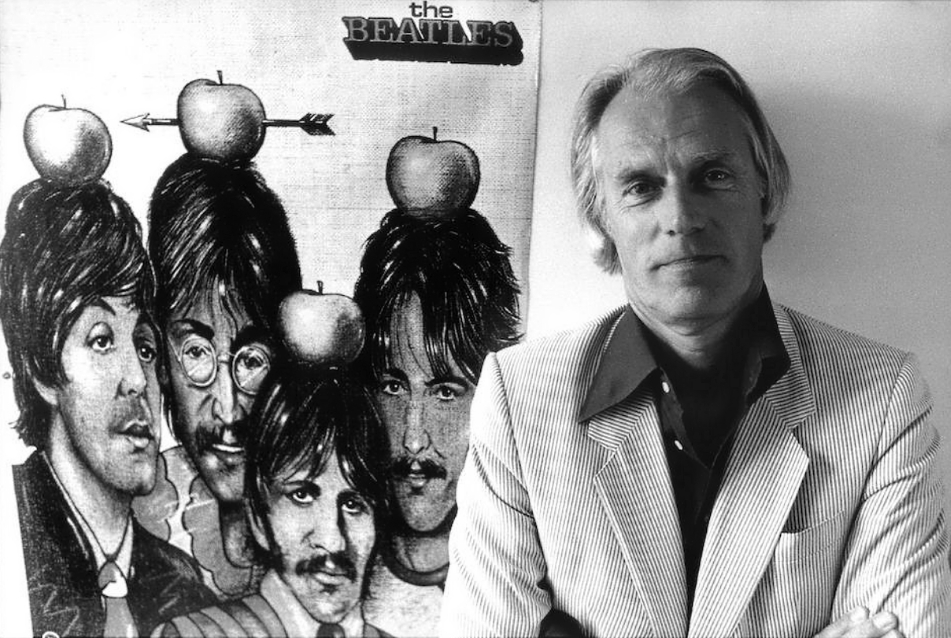
In early 1962, George Martin collaborated with BBC Radiophonic Workshop’s Maddalena Fagandini to create and record two pioneering electronic instrumental tracks, “Time Beat” and “Waltz in Orbit.” Under the artist pseudonym Ray Cathode, the tracks were released that April as a Parlophone single and B-side, just weeks before Martin met and recorded The Beatles for the first time. Bridging six decades of electronica, George Martin Music has partnered with dublab, a non-profit online radio station broadcasting out of Los Angeles, to release a very limited run of 100 numbered 12-inch vinyl EPs pairing the two songs, newly remastered by Craig Leon, with contemporary remix reinterpretations by SPARKLE DIVISION and Drum & Lace. The announcement of the release was made on March 9, 2021, one day after the fifth anniversary of Martin’s passing.
Cut at Finyl Tweek and pressed at The Vinyl Factory, the collectible EP will be released on May 1, 2021, and sold exclusively by dublab, with all proceeds benefiting dublab’s nonprofit community radio programming and mission.
The premium (#1-10) edition is available here.
The remaining batch (#11-100) are here.
During Martin’s storied seven-decade career, the venerated producer, composer, and music executive actively nurtured his lifelong fascination with sound. From his first hit recordings, he would experiment in the studio, using the room and its equipment, playing with different tape speeds, acoustics, reverse echo, backward recording, music concrète, and other forward-looking techniques. Martin’s working base since 1950, EMI’s Abbey Road Studios, was light on electronics at the time, but only a short walk away from the innovative BBC Radiophonic Workshop. There he met fellow audio experimentalists who were making soundscapes for television shows from nascent electronic hardware they’d made or acquired long before the emergence of anything recognizable as similar. At the Workshop, every sound was made laboriously by hand.
The then-36-year-old Martin teamed up with the Workshop’s Fagandini for a commercial experiment. Under the pseudonym Ray Cathode, the two audio pioneers created a brace of tracks: the first with Martin providing the manmade melody alongside Fagandini’s electronically created rhythm, and a second for which they switched roles. Sounding like nothing else of the time, “Time Beat” and “Waltz in Orbit” drew a great deal of interest upon their release.
Listen to “Time Beat”
Also notable as the first commercially released recordings from the BBC Radiophonic Workshop, the Ray Cathode tracks heralded the dawn of electronica.
Listen to “Waltz in Orbit”
The Parlophone Records executive famously met with Beatles manager Brian Epstein in 1962 after all other British record labels had passed on the quartet. Martin signed them soon after. He always maintained that it was his early career experimentation, including Ray Cathode, that helped him in his work as The Beatles’ producer to meet the band’s constant need for new sounds and effects. Fagandini continued creating electronic music and sounds, including jingles and interval signals, at the BBC Radiophonic Workshop until 1966, when she moved into her successful career as a television producer and director.
Martin and Fagandini’s pioneering use of synths on “Time Beat” is carried forward in the song’s Drum & Lace remix, using some of today’s innovative recording technology. For SPARKLE DIVISION’s remix of “Waltz in Orbit,” the 1962 recording is a launching point for their own creation of something different and individual, but firmly rooted in the techniques and spirit of the original.
SPARKLE DIVISION is the dynamic jazzy side project of ambient legend William Basinski and LA producer extraordinaire, Preston Wendel, aka Shaia Taint. Their debut album, To Feel Embraced, was released by Temporary Residence Ltd. in 2020
Drum & Lace, aka Sofia degli Alessandri-Hultquist, is an Italian composer and performer who creates music for film and media. Raised in Florence, Italy she relocated to Los Angeles after receiving her undergraduate degree from Berklee College of Music (Film Scoring & Composition) and a master’s degree (Music Technology & Composition) from New York University. Her composition work includes writing for various mediums, amongst them film, TV, dance, theater, fashion, and advertising. Recent soundtrack works have been the upcoming film Cobwebs and the TV series, Good Girls and Dickinson.
Over the past 18 years dublab.com has been acclaimed as one of the world’s premier Internet radio stations. Dublab is a community supported organization funded through contributions and underwriting from individual donors and groups from around the world, including the Department of Cultural Affairs, and the National Endowment for the Arts, among others.

March 13, 2021
50 Years Ago Today: Paul McCartney's first solo single "Another Day" enters at number #23 on Ottawa's CFRA Hit Parade (and he never looked back after that!! Well done, Paul!)
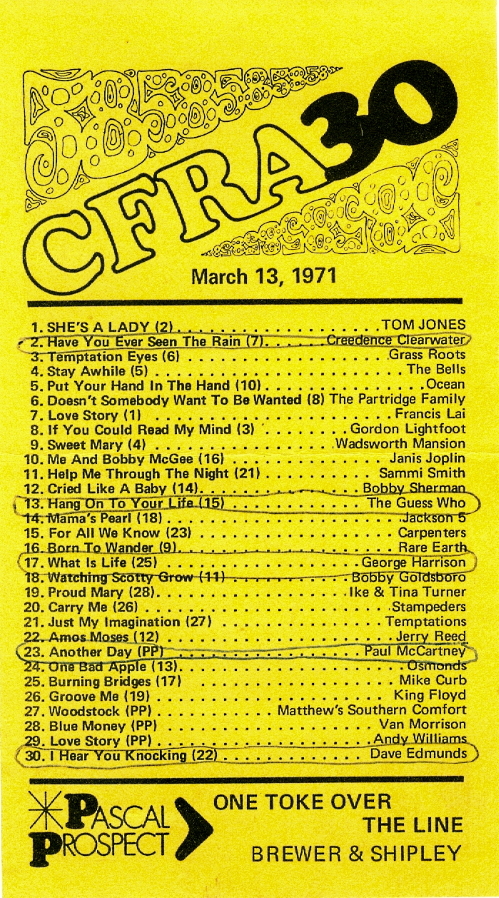 |
|

March 6, 2021
Life in The Beatles rhythm: LI man collects the band's music, memorabilia
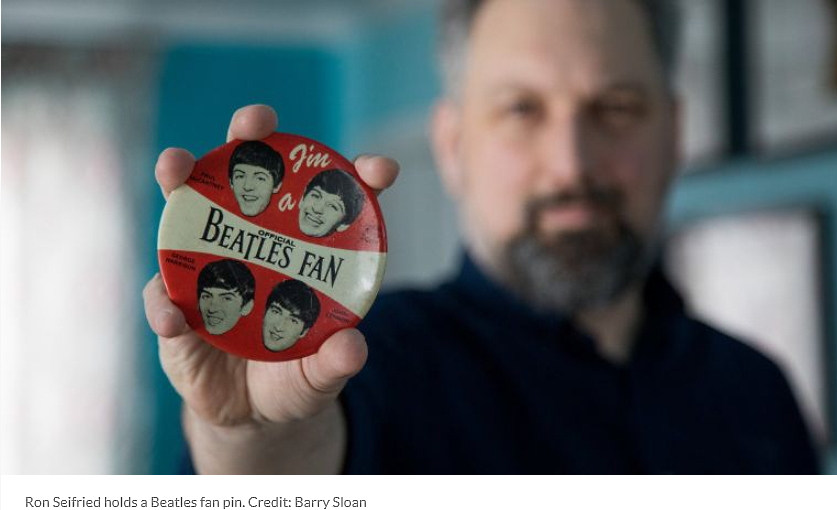
Back in the early 1990s, when he worked as an editor for an ABC television pilot, Ron Seifried struck a kind of gold. While he visited one of the producers, she showed him a framed gold record (John Lennon’s 1975 "Shaved Fish") in her husband’s recording studio in upstate New City. The record had been awarded to Wayne "Tex" Gabriel, the producer’s husband, who played lead guitar with John Lennon in 1972. Gabriel showed Seifried around the studio and five years later made the gift of a lifetime as a thank you for Seifried's production work on various projects.
Gabriel gave Seifried 30 minutes of remastered, never released recordings on CD of John Lennon playing at Butterfly Studios in Manhattan in 1972, including an electric-guitar version of "Working Class Hero," a kind of gold in the world of Beatles collecting.
"John’s voice is clear and confident. He was planning to tour with Wayne and the Elephant’s Memory band," said Seifried, 52, of Huntington. "They rehearsed it for a possible live performance, but for some reason decided not to perform it in their many appearances in 1972."
It is now more than 50 years since Paul McCartney in 1970 announced the Beatles' breakup, but for fans like Seifried, it might as well be like the Beatles’ song, "Yesterday." Siefried has been collecting Beatles discography and memorabilia most of his life, starting young and getting more serious, amassing small and big finds.
"When I met Ron, he was already a Beatles collector. It was one of the things we bonded over," said his wife, Anne Seifried, also 52. "There’s always a Beatles song for any mood. It’s become the background music for our life together."
The Fab Four — John Lennon, Paul McCartney, George Harrison and Ringo Starr — stayed together only eight years, although Lennon and McCartney had been together for 13. Yet interest in the band — and its music and memorabilia — continues as strong as ever.
"Ron is a true collector and an encyclopedia of knowledge about Beatles and post Beatles," said Stefan Adler, 73, who lives in upstate Cornwall and whose Beatles collection includes replicas of guitars used by the band. "I kid Ron that he should go on "Jeopardy!" and hope the category is the Beatles."
Seifried, a Web architect for a photography and electronics retailer for more than 20 years and author of "Long Island Freemasons" (Arcadia Publishing, 2020), studied broadcasting at LIU Post. Beatles’ music and memorabilia became his passion, though he never heard them perform live.
"They transcend generations. You can play ‘Yesterday’ for a 2-year-old or an 85-year-old," he said. "They love the song. Very few musicians have that broad, multigenerational appeal."
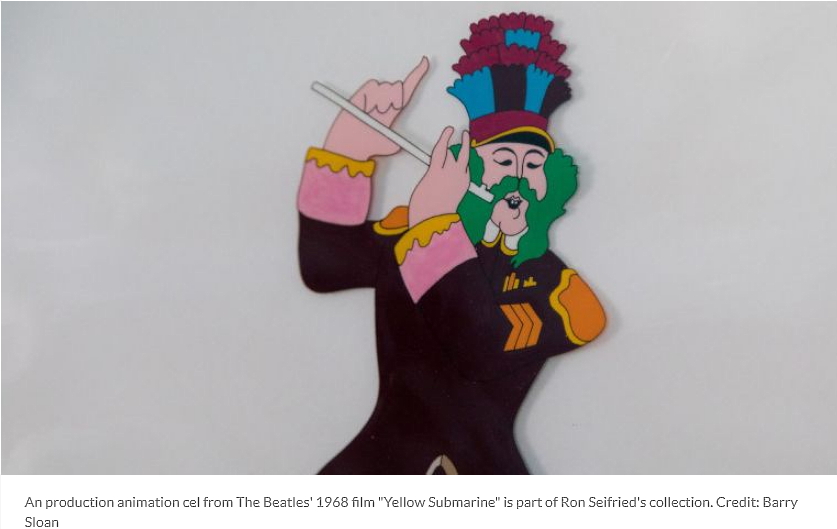
Music and more
Seifried has assembled some 500 CDs, 300 albums and 150 45-rpm Beatles records as well as production animation cells from the 1968 film "Yellow Submarine." He has contact sheets of The Beatles from their 1966 U.S. tour photographed by Danny Fields, the managing editor of the teen-fan magazine Datebook that helped popularize the band.
Seifried also has a so-called third-state copy of the Beatles' 1966 "Yesterday and Today" with the "butcher cover" image of the band in butcher coats with plastic doll parts and fake blood. The cover was recalled and reissued with a less controversial image after public reaction threatened sales. (First-state copies have the original image intact; second-state have the new image pasted atop the butcher cover; and third-state copies are those that had the second cover removed to reveal the original butcher image.) Seifried’s items from the early Beatlemania era also include wigs, brushes and a board game. He’s got lithographs by Mike McCartney (Paul’s brother) from the late ’80s and a photograph of The Beatles with Ed Sullivan taken and signed by Newsweek staff photographer Bernard Gotfryd, among other items.
Seifried wouldn’t describe himself as a musician or particularly musical — he doesn’t play any instrument — though he once was a roadie for New Wave band The Touch and worked on a Bela Fleck music video. But Seifried studied the Beatles as a group and in their post-Beatles days, collecting facts and finds along the way.
"Here’s an easy one. What’s Paul McCartney’s middle name?" he’ll say in what turns out to be a trick question. "You know the answer to that. It’s Paul. His full name is James Paul McCartney."
Among the other tidbits he’s collected: McCartney, he says, played drums on many songs including "Back in the USSR" and "Dear Prudence," while Harrison played violin for "All You Need is Love." Those are easy trivia questions, Seifried said.
"Who is the photobomber standing next to the police van on the cover of Abbey Road?" he asks, before listing tougher questions. "The answer is Paul Cole."
Seifried was born in October 1968, a month before the release of The Beatles’ self-titled double album, also known as the White Album. His childhood home, though, was not suffused by music: His parents were deaf, he said. His mother was born deaf, and his father lost his hearing at age 2 due from illness and was legally hearing impaired.
"My father told me years later the only song he kind of knew was ’The Twist,’ by Chubby Checker," Seifried explained. "He watched people dance to 'The Twist.' He couldn’t feel it. He couldn’t hear it. But he could at least visualize it."
Seifried’s mother used to put her hand on his bedroom door to feel vibrations to see if he listened to loud music. "She would knock on my door to lower the music, not realizing it wasn’t that loud," Seifried said. "My parents were familiar with who the Beatles were, but they couldn’t hear any of the music."
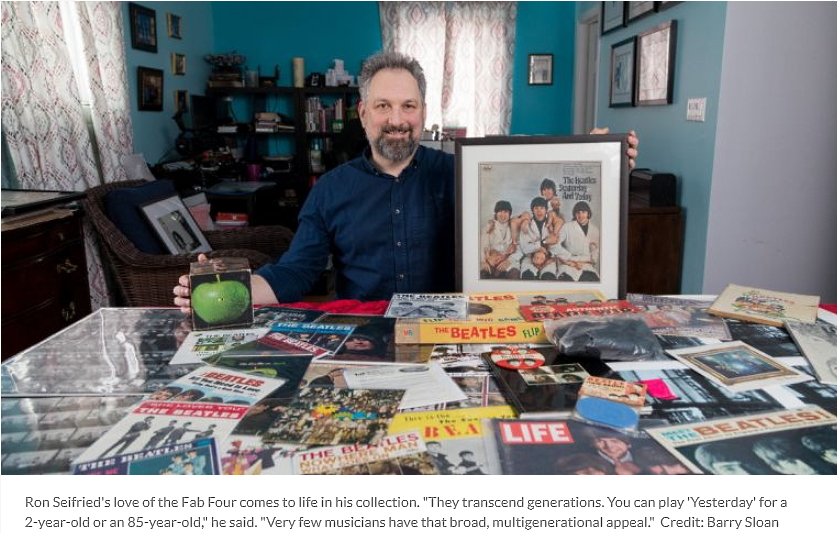
An early introduction
Eleven years older, Ron’s brother Rob, a fan of Led Zeppelin, Black Sabbath and Alice Cooper, had a few Beatles albums. When Rob wasn’t home, Ron, starting when he was 10, would sneak into Rob's room to play his records, including The Beatles’ greatest-hit sets "1962-1966" and "1967-1970," known as the Red and Blue albums, respectively.
Those sessions introduced Seifried to The Beatles alongside reruns of "Help!" and "Yellow Submarine," which he saw on TV during Christmas break in 1978. Tragedy later drove him deeper into the band. Seifried was a 12-year-old seventh-grader at the former Memorial Junior High School in South Huntington the day in 1980 when John Lennon was shot.
"We had an assembly at the end of the day to remember and pay tribute to John Lennon," he said. "There was an outpouring of love and grief."
Seifried began learning more about Lennon and the band. "I noticed a ton of tribute magazines to John Lennon on the magazine racks," he explained. "I started buying them and reading about the Beatles." He bought "The Beatles Forever," the 1977 compendium by Nicholas Schaffner that became his Beatles bible. "I lived and breathed that book," Seifried said. "I constantly read sections over and over again. It was like a holy book."
He bought albums at the South Huntington TSS, the department store that was once a fixture on Long Island, and widened his search for used and bootleg records at Titus Oaks, a record store in South Huntington. "I begged my mom for money," he said. "I diverted my baseball card money for Beatles albums."
Thus began a 35-year hunt for recordings of unreleased tracks, demos, live performances, interviews and guest appearances. If any one of The Beatles performed on someone’s else’s album, Seifried would seek it out. "I was fascinated by how quickly they evolved," he said.
He saw how the Beatles influenced pop culture beyond music, impacting how people dressed and expressed themselves — and making their memorabilia even more appealing. "They influenced fashion, their haircuts, the way they thought and spoke," Seifried said. "And the music was mind-blowing."
As Seifried aged, so did the band’s remaining former members. Before he went to work on a Friday in November 2001, Seifried learned George Harrison had died. "I took a day off from work and listened to only George Harrison music all day," he said.
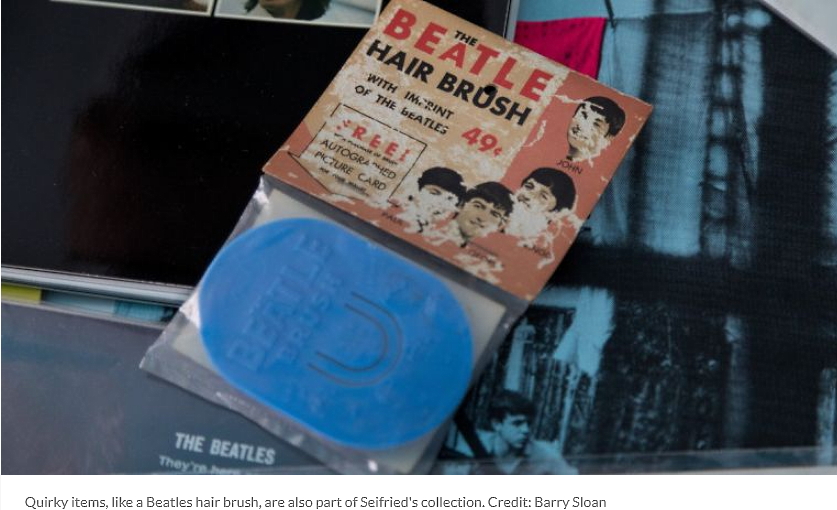
All in the family
He doesn't just love the hits, but obscure B-side or deep album cuts, like "Hey Bulldog." "I never get tired of that song from ’Yellow Submarine,’ " he said.
In addition to the iconic Look and Life magazine Beatles covers, Seifried has a collection of more than 100 books. He bought a1965 Playboy magazine with a Beatles interview for $1 at a garage sale along with a rare album for a quarter.
He has heard Paul McCartney and Ringo Starr each perform half a dozen times and met Pete Best, The Beatles drummer for two years, at a signing at The Book Revue in Huntington. "He was a nice guy," Seifried said. "He was more of an outsider, only showing up for the gig and almost never spending down time with John, Paul or George."
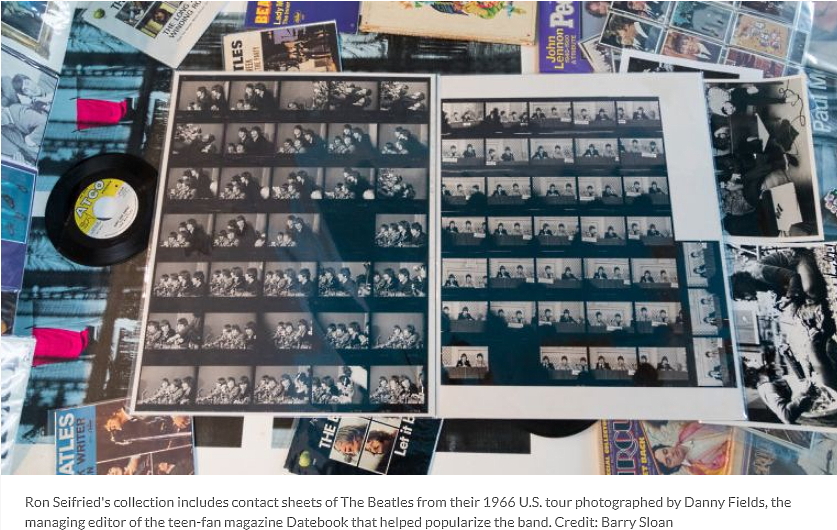
And there appears to be no end to Beatles-related merchandise, including upcoming multi-disc sets of Lennon’s and Harrison’s first albums and Peter Jackson’s documentary "The Beatles: Get Back," slated for release later this year.
Seifried continues to acquire memorabilia, including the most recent of his five animation production cells from "Yellow Submarine." "I got one for Father’s Day," he said of the gift from his family last June.
And his love of the Fab Four has left its mark on his family in other ways. He and his wife named their oldest daughter, Julia, after the eponymous Beatles song on The White Album, and both of their daughters — Julia, 15, and Sophia, 11 — like the band. Ron’s parents never got to hear the Beatles, but the Beatles remain part of his and his family’s life.
"I grew up with the Beatles as well," said his wife, Anne. "My dad had lots of albums in the house. That was part of the soundtrack I grew up with. On a Sunday afternoon, you put on a record. Listening to the Beatles isn’t a bad thing to do. It’s comforting, relaxing."

March 5, 2021
John Lennon/Plastic Ono Band new stereo mixes planned for release
Click on the above image for track details.

March 2, 2021
Editing Paul McCartney's autobiography a similar process to The Beatles' song-writing sessions, says NI poet Paul Muldoon
by Maureen Coleman for the Belfast Telegraph

Photography credit: Steve Humphreys
Pulitzer prize-winning Northern Irish poet Paul Muldoon, who has edited Sir Paul McCartney's lyrical memoirs, has likened the book's creative process to The Beatles' legendary afternoon song-writing sessions.
The Co Armagh man and contemporary of the late Seamus Heaney, was enlisted by McCartney to work on his 900-page volume The Lyrics, a 'self-portrait in 154 songs', charting the 78-year-old's career from boyhood to The Beatles.
The book will cover the 'circumstances in which the songs were written, the people and places that inspired them and what (McCartney) thinks of them now'.
Muldoon, a former professor of poetry at Oxford and fan of Sixties pop, met up with the former Beatle many times to discuss the book's content and the writing process.
“Sir Paul and I met regularly over a period of five years for two or three hour sessions in which we talked in a very intensive way about the background to a half dozen songs,” said Muldoon.
“In a strange way, our process mimicked the afternoon sessions he had with John Lennon when they wrote for the Beatles. We were determined never to leave the room without something interesting."
Muldoon described McCartney as 'a major literary figure' and a poet.
“He’s one of the most buoyant, upbeat people I know, but his general demeanour shouldn’t suggest that he’s anything but a deep thinker,” said Muldoon.
“He looks long and hard into every aspect of life and I believe readers, old and new, will be struck by a book that will show that side of him. He’s going to come out of this book as a major literary figure.
“His insights into his artistic process confirm a notion at which we had but guessed: that Paul McCartney is a major literary figure who draws upon, and extends, the long tradition of poetry in English.”
Muldoon also revealed that McCartney pranked him with a phone call, pretending to be then-US president Donald Trump.
During an interview on BBC Radio 4's Today show, the poet said that he had received a call from Trump in 2016, inviting him to be his 'poetry tzar' but that it turned out to be the Beatles legend impersonating the president.
“Paul McCartney is a very serious person but he’s very far from being a solemn person. He’s a great believer in fun," said Muldoon.
“This is absolutely clear from his catalogue, if we may describe it as such. He’s more inclined to see the upside of things and to be joyous, rather than anything else.”

March 1, 2021
Grammy Museum Announces Ringo Starr Virtual Exhibit
by Angie Martoccio for Rolling Stone magazine
Museum will also release new and archival interviews with the former Beatle
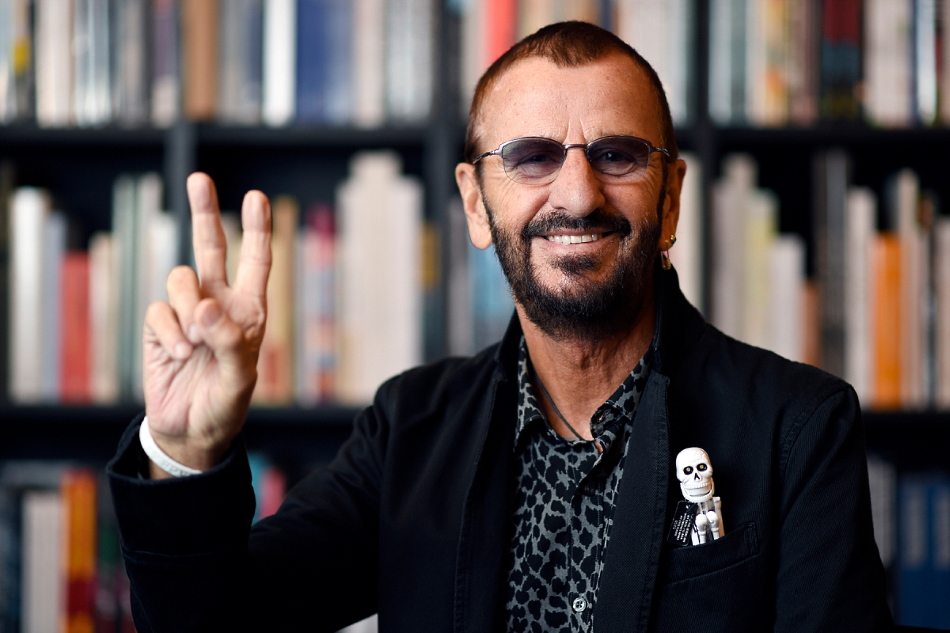
The Grammy Museum has announced a virtual Ringo Starr program in March featuring a virtual exhibit and interviews with the former Beatle.
On March 4th, the museum will release a 2010 interview with Starr from their Live From the Vault series, followed by a new interview with the museum’s founding executive director Bob Santelli on March 18th. Starr will discuss his upcoming EP Zoom In and his new book Ringo Rocks: 30 Years of the All Starrs 1989-2019.
The museum will also feature the 2013 exhibit Peace & Love virtually; it covers his early life in Liverpool, his launch to superstardom with the Beatles, and his years with the All Starr Band. The museum’s streaming service Collection: Live can be accessed here.
Zoom In includes the new track “Here’s to the Nights,” featuring Paul McCartney, Dave Grohl, Joe Walsh, and several other musicians. “Diane Warren wrote it: ‘Here’s to the nights we won’t remember, with the friends we won’t forget,'” Starr told Rolling Stone last December. “So it has a beautiful sentiment. It’s about us all coming together, so it seems appropriate for today. Everybody I know, we’ve all had quite a few nights we don’t remember. And we’ve all had them with friends we won’t forget.”
The long-awaited documentary The Beatles: Get Back arrives on August 27th, 2021.

February 25, 2021
Paul McCartney to publish 900-page lyrical 'autobiography'
by Alison Flood for the Guardian
The Lyrics, a ‘self-portrait in 154 songs’, will look at the people, places and circumstances behind songs written in boyhood, with the Beatles and beyond
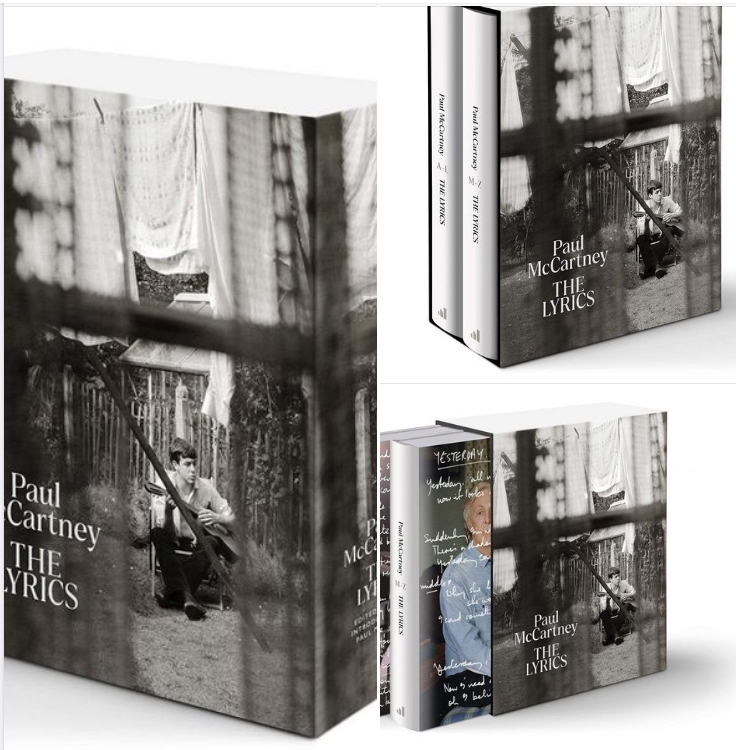
It will be “as close to an autobiography” as Paul McCartney “may ever come”: the former Beatle is set to publish The Lyrics, a deep dive into his life, based on conversations he had with the prize-winning poet Paul Muldoon.
The Lyrics, a two-volume, 900-plus page “self-portrait in 154 songs”, will be released on 2 November. It will be “a kaleidoscopic rather than chronological account” of McCartney’s life, said publisher Allen Lane, and will cover the musician’s earliest boyhood compositions – he wrote his first song at 14 – through the Beatles catalogue to Wings, solo albums and his present life. The book will cover “the circumstances in which they were written, the people and places that inspired them, and what [McCartney] thinks of them now”.
McCartney said: “More often than I can count I’ve been asked if I would write an autobiography, but the time has never been right. The one thing I’ve always managed to do, whether at home or on the road, is to write new songs.
“Some people, when they get to a certain age, like to go to a diary to recall day-to-day events from the past, but I have no such notebooks. What I do have are my songs, hundreds of them, which I’ve learned serve much the same purpose. And these songs span my entire life.”
Muldoon, the Pulitzer prize-winning Irish poet, edited the book, which is based on conversations he has had with McCartney. “Sir Paul and I met regularly over a period of five years for two or three hour sessions in which we talked in a very intensive way about the background to a half dozen songs,” said Muldoon. “In a strange way, our process mimicked the afternoon sessions he had with John Lennon when they wrote for the Beatles. We were determined never to leave the room without something interesting.”
Muldoon said that he was “struck again and again by what you might term Paul McCartney’s ‘scholarly’ disposition” during the process.
“He’s one of the most buoyant, upbeat people I know, but his general demeanor shouldn’t suggest that he’s anything but a deep thinker. He looks long and hard into every aspect of life and I believe readers, old and new, will be struck by a book that will show that side of him. He’s going to come out of this book as a major literary figure,” said Muldoon.
“His insights into his artistic process confirm a notion at which we had but guessed: that Paul McCartney is a major literary figure who draws upon, and extends, the long tradition of poetry in English.”
The volumes will also include material from McCartney’s personal archive, including never publicly seen drafts, letters and photographs. “We learn intimately about the man, the creative process, the working out of melodies, the moments of inspiration,” said the publisher.
McCartney said he hoped what he had written would “show people something about my songs and my life which they haven’t seen before”. “I’ve tried to say something about how the music happens and what it means to me and I hope what it may mean to others too,” he said.
McCartney’s previous books include Blackbird Singing, a collection of lyrics and poems spanning 1965-99; High in the Clouds, a children’s book written with Philip Ardagh; and the picture book Hey Grandude!, based on his relationship with his eight grandchildren and illustrated by Kathryn Durst.

February 24, 2021
University of Liverpool Launches World’s First Master Programme in “The Beatles, Music Industry and Heritage”
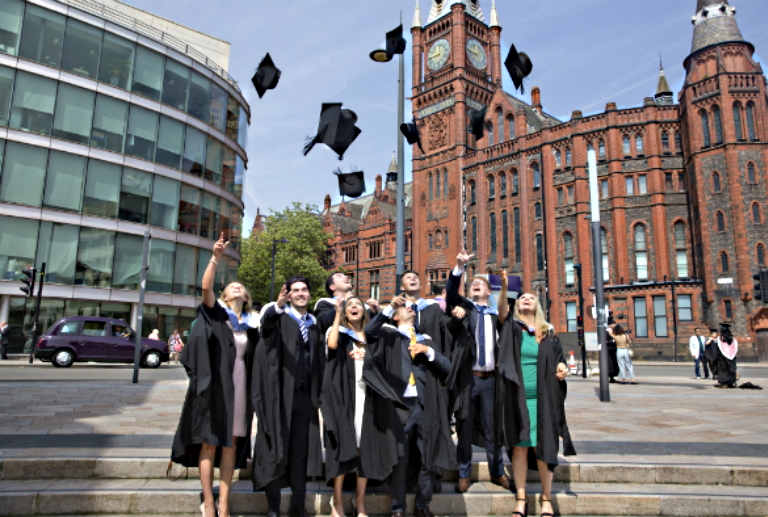
The University of Liverpool is offering to students from across the world a unique master programme in the Beatles’ impact on Music Industry and Heritage.
The university has already begun accepting applications for the programme, while students from across the world will have the chance to study the major starting from September 2021, Erudera College News reports.
The postgraduate unique qualification Master in the Beatles: Music Industry and Heritage is listed alongside MA Music Industry Studies and MA Classical Music Industry.
The programme will apply to individuals who are currently working or aiming to build a career in the music and creative industries.
Following the launch of this type of MA degree, the Head of Music at the University of Liverpool Catherine Tackley said that the new programme is being introduced at the same time as the opening of the Tung Auditorium in the Yoko Ono Lennon Centre, which will extend the contribution of the university to the rich musical and cultural life of the city.
“We are excited to welcome the first students to study the MA in The Beatles in 2021,” she said.
The Beatles expert, Holly Tessler, expressed delight over the possibility to formally study the Beatles at the University of Liverpool’s Department of Music and Institute of Popular Music – the world’s first specialist centre for the study of popular music.
“What makes this MA unique is its focus on The Beatles in a future-facing way, considering the legacy’s influence on the music and creative industries, in popular culture, and within the heritage, culture and tourism in the 21st Century,” Tessler said.
Whereas, a member of the Beatles Legacy Group, Mike Jones, said that Liverpool should not be acknowledged only as the birthplace of the Beatles but also as “their cradle”, claiming that what Beatles took to the world was in part Liverpool’s unique culture.
“The introduction of The Beatles MA, at last, gives the University of Liverpool a framework to explore this deep, significant and lasting relationship,” Jones said.
The Master programme in the Beatles starts with contextualising the study of The Beatles within a music and creative industries framework, examining then the band’s role in other scopes such as tourism and heritage before and more.
In addition, persons who are employed in museums and galleries, arts, tourism and leisure sectors could also see this programme as a good choice.

February 23, 2021
The Abbey Road Sign Made Famous By The Beatles Is Hitting The Auction Block
by Kaitlyn McInnis for the Tatler
The iconic piece of The Beatles history has already outperformed its estimated price—and still has a week left under the hammer

Music collectors and Beatles aficionados will finally have the chance to own one of the most coveted pieces of Beatles history: the iconic Abbey Road street sign—home of the Abbey Road Studios—is officially hitting the auction block.
The authentic Abbey Road street sign is currently listed with Catherine Southon Auctioneers, and, according to a recent Hypebeast report, the famous sign is just one of many authentic road signages that is currently being sold by the Westminster City Council, with funds collected expected to go toward civil services in the area.
“This collection offers a unique opportunity to own part of our city's history,” deputy leader Melvyn Caplan said in a statement. “These are original signs which have been on the streets of London in recent years—through historic moments and cultural milestones.”
Described by the auction house as an enamelled iron street sign for Abbey Road NW8, City of Westminster, with iconic black and red sans serif lettering first created by Sir Misha Black in 1967, the font is is unique to the Westminster signs and under copyright law, is actually forbidden to be copied anywhere else in the world. Collectors will also be happy to know that the sign will be sold together with a signed certificate of authenticity.
Bidders should also take note that the road sign has been hung outside and has been exposed to the elements, resulting in expected wear and tear—but overall remains in quite good condition given its time spent as, well, an actual road sign.
Interested in finding out more about the road sign auction or registering to bid for yourself? More details can be found at the official Catherine Southon Auctioneers website—but you’ll want to act fast. The unique piece of Beatles history will close next week, March 3, 2021 and has already exceeded the £2,000 GBP estimated lot price by over £7,000.

February 19, 2021
Carnival 2021 - All Things Must Pass
"Check out this ‘All Things Must Pass’ inspired “house float” as part of the 2021 Mardi Gras. With no parades this year, residents in New Orleans are decorating the fronts of their houses to resemble floats, including this one, which pays homage to George’s timeless #1 album." ─ culled from The Beatles Official Facebook pages.
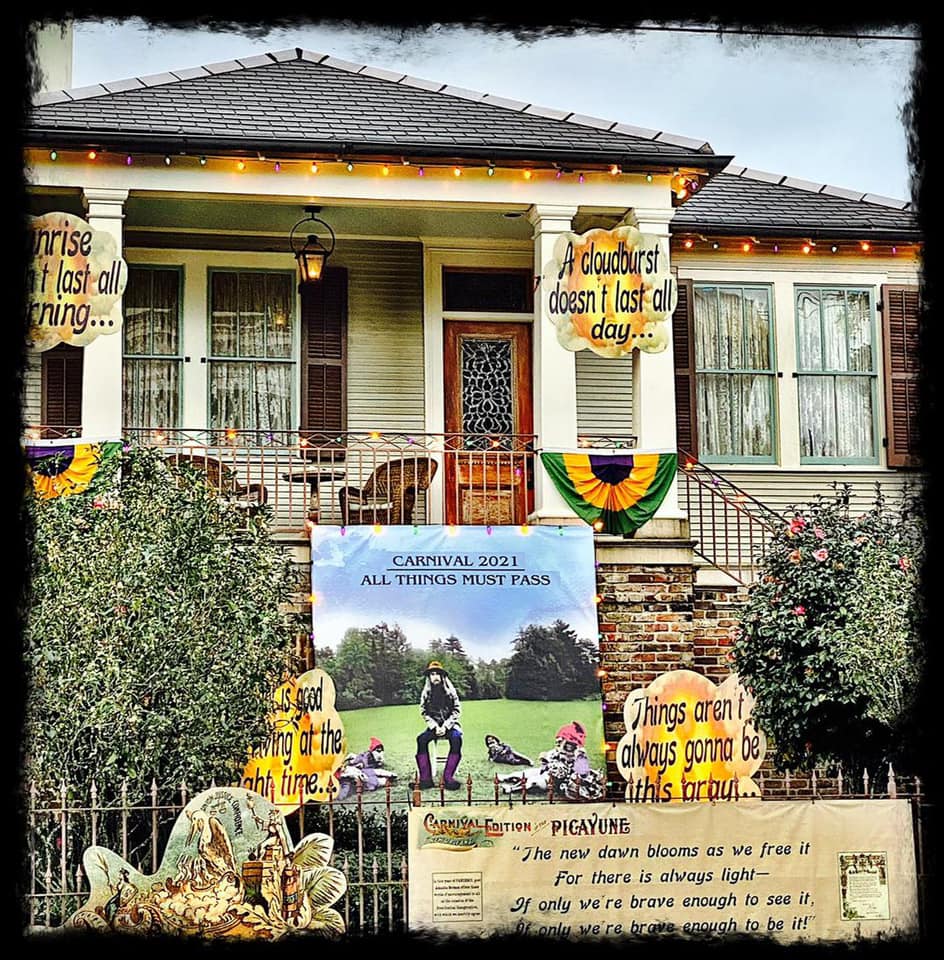

February 18, 2021
Guest book from the Grand Hotel with Beatles signatures sells for £6,700. ($8,100.99 United States)
The BBC reports that Birmingham's Grand Hotel 1965 guest book "signed by The Beatles, Rolling Stones and a then-future prime minister" Ted Heath has been sold by Fieldings Auctioneers.
Click here to read the full report.
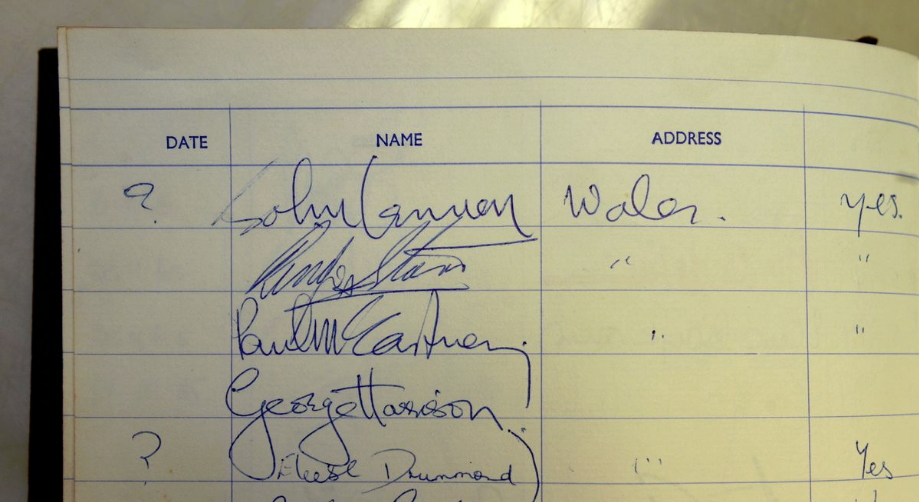

February 15, 2021
New John Lennon ‘Love’ Video Released Ahead of ‘John Lennon/Plastic Ono Band’ Reissue
A new John Lennon ‘Love’ video has been released on Valentine’s Day ahead of the expanded reissue of the ‘John Lennon/Plastic Ono Band’ box set.
Details of the box set will be revealed on March 4, 2021. We know the expanded set will included 159 new mixes. The hardcover book focused on the album was released in 2020.
‘John Lennon/Plastic Ono Band’ was released on 11 December 1970. It was John’s first contemporary solo album and came at the end of a productive year for The Beatles four members.
In a Beatles timeline we had:
17 March 1970 – Ringo Starr – ‘Sentimental Journey’
17 April 1970 – Paul McCartney – ‘McCartney’
8 May 1970 – The Beatles ‘Let It Be’
25 September 1970 – Ringo Starr – ‘Beaucoups of Blues’
27 November 1970 – George Harrison ‘All Things Must Pass’
11 December 1970 – John Lennon ‘John Lennon/Plastic Ono
Band’
Lennon’s next album ‘Imagine’ was released in September, 1971.
‘John Lennon/Plastic Ono Band’ came after John’s three experimental albums ‘Unfinished Music No 1: Two Virgins’ (29 November 1968), ‘Unfinished Music No 2: Life With The Lions’ (9 May, 1969) and ‘Wedding Album’ (7 November, 1969).
‘John Lennon/Plastic Ono Band’ was produced by Phil Spector who also produced ‘Imagine’ for Lennon, John’s singles ‘Power To The People’ and ‘Happy Xmas’, The Beatles ‘Let It Be’ and ‘George Harrison’s ‘All Things Must Pass’ and ‘Concert for Bangla Desh’. The later returned to work with Lennon on 1975’s ‘Rock ‘n’ Roll’.
‘John Lennon/Plastic Ono Band’ will be released on 16 April 2021.
Related links: Click here to watch the new "Love" video and join the John Lennon/Plastic Ono Band mailing list.

February 14, 2021
Paul McCartney wishes his wife Nancy a Happy Valentine's Day
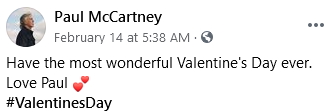


February 11, 2021
"One Flower" poem by Michael X is posted on the official John Lennon Facebook pages

ONE FLOWER.
While men watched the cities disintegrating
Princesses saw me building our community of new people
Who once were write-offs in the old world.
We toiled with a vigour that made them ask
'For what?' and 'Where are you going?' even 'Why?'
It was late in the year, and their peace feelers were out
But we could not hear; our hands were full.
The only sounds were the hammers and saws
Of the carpenters. Music we call it. Bombs fall around us.
Those, they could gather, were thrown into their jails.
We went on. They could not tear down our town.
Their bombs kept raining but our building stood;
It shone like a light among the ruins.
They could not understand; our foundation was solid.
It is made of the new material: IDEA.
‘One Flower’ written by Michael Abdul Malik, aka Michael X
John & Yoko kissing in front of a white wall inscribed with Michael X’s poem
‘One Flower’ at The Black House,
95–101 Holloway Road, London, 11 February 1970.
Photo: Richard DiLello.

February 8, 2021
Watch David Lynch and Paul McCartney discuss the world of ‘Transcendental Meditation’
by Lee Thomas-Mason for Far Out magazine

Photo credit: John Whelan, the Ottawa Beatles Site. Photo was taken in Chelsea, Quebec.
David Lynch, the iconic filmmaker for mindbending creations such as Eraserhead, Blue Velvet, Mulholland Drive and more, has been an avid practitioner of Transcendental Meditation for decades.
Lynch’s commitment to meditation has only grown stronger over the years and, in 2005, he created the charitable organisation of ‘The David Lynch Foundation for Consciousness-Based Education and World Peace’, a foundation that looks to teach aspects of Transcendental Meditation in schools and other at-risk populations such as the homeless, veterans and refugees.
Like many creatives, Transcendental Meditation has grown into a way of life. Paul McCartney, a founding member of The Beatles and meditation advocate, has been an avid meditator for the better part of 50 years. “In moments of madness, meditation has helped me find moments of serenity — and I would like to think that it would help provide young people a quiet haven in a not-so-quiet world,” McCartney says.
During the Beatles’ famed spell in India, McCartney revealed that he had been first introduced to meditation by Indian sage Maharishi Mahesh Yogi back in 1968. “It was actually George Harrison’s wife, Patti, who had heard Maharishi was coming to town,” Paul McCartney said. “And she said we should all go… [I was] just overdoing it in the ‘60s. I was just not very centred and I was looking for something. I think we all were.”
In a meeting of exceptional minds on both a creative and spiritual level, Lynch sat down to interview McCartney on all things meditation: “It was very interesting,” he recalled about his first introduction to skill. “It was very calming and it seemed like something that was worth trying. [Maharishi] put it very well.
McCartney added: “He made it seem simple; he made it seem very attractive. It was a great gift that Maharishi has given us. It came during a period at the end of the ’60s when we were looking for something that could bring us more stability, and it was a lifelong gift. It’s something you can call on at any time.”
When discussing Lynch’s foundation, the former Beatle added: “The kids love it, kids in Brazil love it, kids in the West Bank love it… I think this is what people need, they don’t need high minded talk, as much as results.”
See the full interview, below.

February 7, 2021
How the Beatles recorded bass in 1967
The Pan Am Boeing Boeing 707 That Brought “Beatlemania” To The US
by Sumit Singh for Simple Flying
Beatlemania was running wild during the 1960s. Fans across the globe were obsessed with The Beatles during the British band’s record-breaking rise in the music industry. 57 years ago today, the group disembarked a Boeing 707 operating Pan American World Airways Flight 101 to John F. Kennedy International Airport from London. This trip was the band’s first-ever visit to the United States.
A grand tour
Between February 7th and February 22nd, 1964, The Beatles had an incredibly busy run of appearances. They performed at the Washington Coliseum and New York City’s Carnegie Hall. Additionally, they appeared twice on The Ed Sullivan Show, garnering over 70 million viewers.
According to AeroTime Hub, John Lennon, Paul McCartney, George Harrison, and Ringo Starr arrived at New York JFK at 13:20 and were welcomed by 4,000 fans and 200 members of the press. The aircraft that made this landmark event possible was a Boeing 707-331 with registration number N704PA. In true Pan Am fashion, the plane was nicknamed Jet Clipper Defiance.
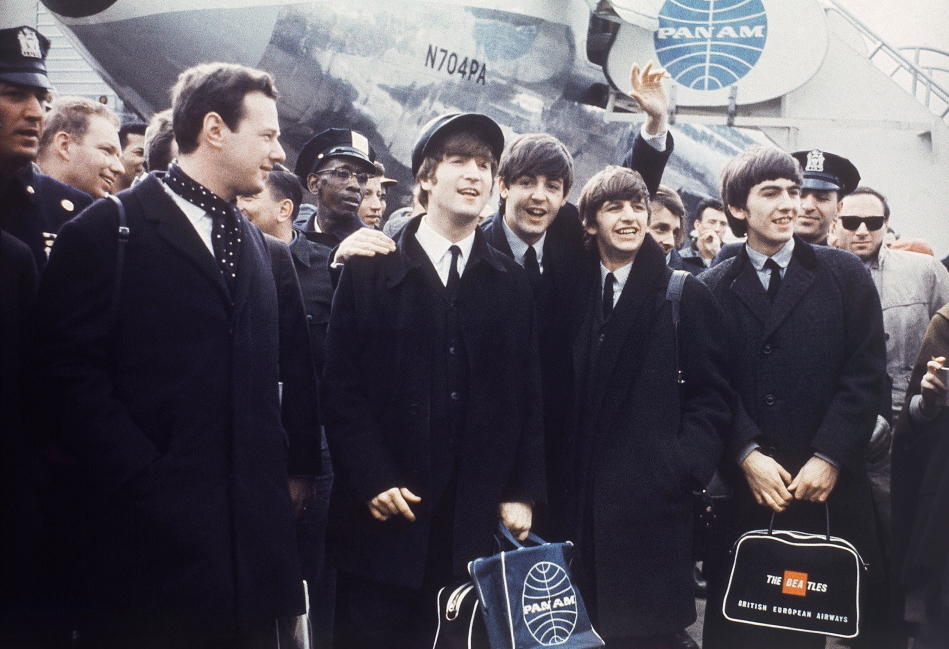
The Beatles with their manager Brian Epstein
The right transport
The four-engine jet aircraft had a flight crew of four members, including the pilot, co-pilot, navigator, and flight engineer. The 707-331’s wing is notably different from the initial 707-120 series. It was longer and had different flaps and spoilers. The engines are mounted further outboard. Meanwhile, the vertical fin is taller while the horizontal tailplane has a greater span. It also has a ventral fin to improve “longitudinal stability.”
The -331’s Pratt & Whitney JT3D-3 turbofan engines helped it hit ranges of up to 4,298 mi (6,920 km) at speeds of up to 552 mph (889 km/h).
Altogether, the 707 would help transform the way people around the world traveled. Boeing initially intended for the plane to be focused on medium-haul routes. However, the type was soon heading on transcontinental and transatlantic missions. Overall, Boeing delivered 856 707s in all variants between 1957 and 1994.
Registration N704PA held serial number 17683 and performed its first flight on March 3rd, 1959. PlaneLogger reports that first arrived at Pan Am’s holdings a year later. World Airways then operated the unit from March 1972 before returning it to Pan Am in December of that year. However, the legacy carrier would pass it to Vietnam Air in March 1973 before taking it back again in August 1975. The aircraft subsequently left the fleet and was scrapped after arriving at Aerotron AC’s facilities at the end of that year.
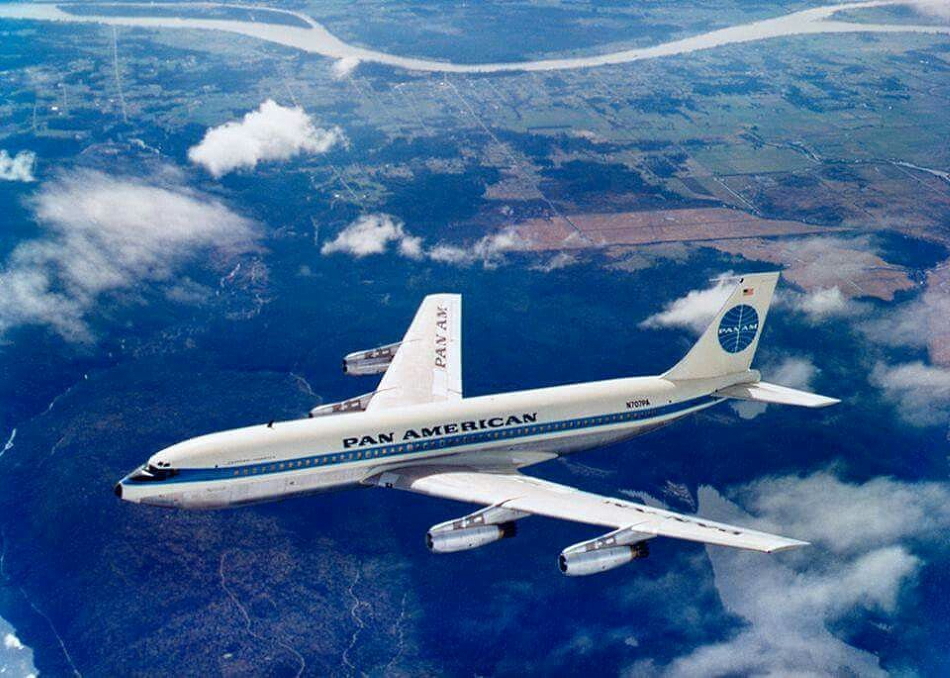
Time to head back
Following the end of The Beatles’ tour, Jane Luna Euler was a Pan Am flight attendant that was invited to work on The Beatles’ return trip to London on February 22nd. At the airport, she witnessed thousands of fans screaming from behind barricades.
“The noise was incredible. Medical staff had been assigned to stand in the aisle created by the barricades to accept those fans who fainted in the crush of people and who were over-excited at the opportunity of seeing the Beatles. Those who fainted, both girls and boys, were forwarded to the medical staff hand-over-hand to the barricade aisle,” Euler said, as shared by The Pan Am Historical Foundation.
“On entering the aircraft another memorable sight awaited us. The entire First Class lounge was filled with hundreds/thousands of gifts of all sorts – large flowers arrangements, bouquets, drawings and paintings of a favorite Beatle, cakes, written tributes and poems, photos, and other tributes from their fans. There was an amazing assortment of these items.”
Euler adds that the band members were very courteous and pleasant during the flight, and despite enjoying some downtime with a cocktail of Scotch and milk, they were willing to sign autographs for those that asked.
An unmatched legacy
Altogether, this trip across the pond would long leave a mark on the music industry. Moreover, pop culture as a whole was revolutionized.
“The Beatles’ first American tour left a major imprint in the nation’s cultural memory. With American youth poised to break away from the culturally rigid landscape of the 1950s, the Beatles, with their exuberant music and good-natured rebellion, were the perfect catalyst for the shift,” HISTORY shares.
“Their singles and albums sold millions of records, and at one point in April 1964 all five best-selling U.S. singles were Beatles songs. By the time the Beatles first feature-film, A Hard Day’s Night, was released in August, Beatlemania was epidemic the world over. Later that month, the four boys from Liverpool returned to the United States for their second tour and played to sold-out arenas across the country.”
A unique time
Meet the Beatles! was the group’s second album released in the US. It debuted at #92 on the album chart for the week ending February 1st, 1964. Two weeks later, it peaked at #1 and remained there for eleven consecutive weeks.
The Beatles may have already been popular before their physical arrival to the US. However, after flying in on Pan Am’s Boeing 707 for their first visit to the country, their presence was undoubtedly cemented. This event was just one of the thousands of memories made thanks to the help of Pan Am in the middle of the 20th century.

February 3, 2021
Watch Prince deliver a mind-blowing guitar solo in tribute to George Harrison
by Lee Thomas-Mason for Far Out Magazine
“Music is music, ultimately. If it makes you feel good, cool.”—Prince.
If there’s one thing that can be said about the music of Prince and how he performed his art, it is that he made people feel good—and it was, of course, very cool indeed. One perfect performance of The Beatles classic ‘While My Guitar Gently Weeps’ in tribute to George Harrison proves that.
On March 15, 2004, taking to the stage alongside the great Tom Petty, Steve Winwood, Jeff Lynne, Dhani Harrison among many others, Prince was preparing something typically unique. The occasion was a celebration of former Beatles member George Harrison who was posthumously inducted into the Rock and Roll Hall of Fame—so it needed to be special.
The all-star band, performing ‘While My Guitar Gently Weeps’ which is quite possibly remembered as Harrison’s most-beloved Beatles song, included members of the Heartbreakers and had pre-planned a moment for Prince to take the lead, a moment of majesty, a moment of sheer rock and roll brilliance. A moment only Prince could pull off.
Remembering the moment on reflection, the late Tom Petty once explained: “Olivia Harrison [George’s widow] asked me if I would come along and induct George. I was told, ‘Well, Prince is going to play too,’ and I was like, ‘Wow, that’s fantastic’.” If there was a chance of Petty feeling upstaged (and if you’ve watched the footage you’ll know that’s quite likely) he wasn’t going to spoil the evening and show it.
Then the news broke that Prince, a massive Beatles fan, was also in discussions to make an appearance, Petty explained: “Look, we got Prince here willing to play lead guitar. Why should we give him an eight-bar solo? Over a solo that — the Beatles solo, everyone knows it by heart and would be disappointed if you didn’t play that particular solo there.”
Explaining how the makeshift band knew that The Purple One was destined to nail the solo, Petty continued: “Prince was a great fan of George’s and the Beatles in general, but I think he particularly admired George.” He added, somewhat modestly: “I think George would have liked it a lot.”
Prince was determined to make the most of a moment to pay tribute to Harrison and he began to wield his axe with powerful uncompromising confidence, with a style that ultimately defines his nickname as ‘His Royal Badness’ and unleashed a relentless three-minute guitar solo that had his new bandmates smiling from ear-to-ear, gasping at its splendour and making sure George had a fitting tribute.
As if the moment wasn’t magical enough, Prince had one more trick up his sleeve—albeit accidentally. Tossing his guitar up to the heavens, the instrument appears to vanish in thin air, never to be seen again, just the ringing of reverb in the venue left behind.
See the clip, below.
RetroGroove flashback: A fun interview with George Harrison in October, 1987
Ultimate Classic Rock is reporting that George Harrison played slide guitar on Dave Mason's "If You've Got Love" in 1973 under the pseudonym as "Son of Harry." Listen to George's brilliant slide guitar work below.

February 1, 2021
Blackbird - The Beatles
by Natalia Marín for Agencia Central de Noticias ACN
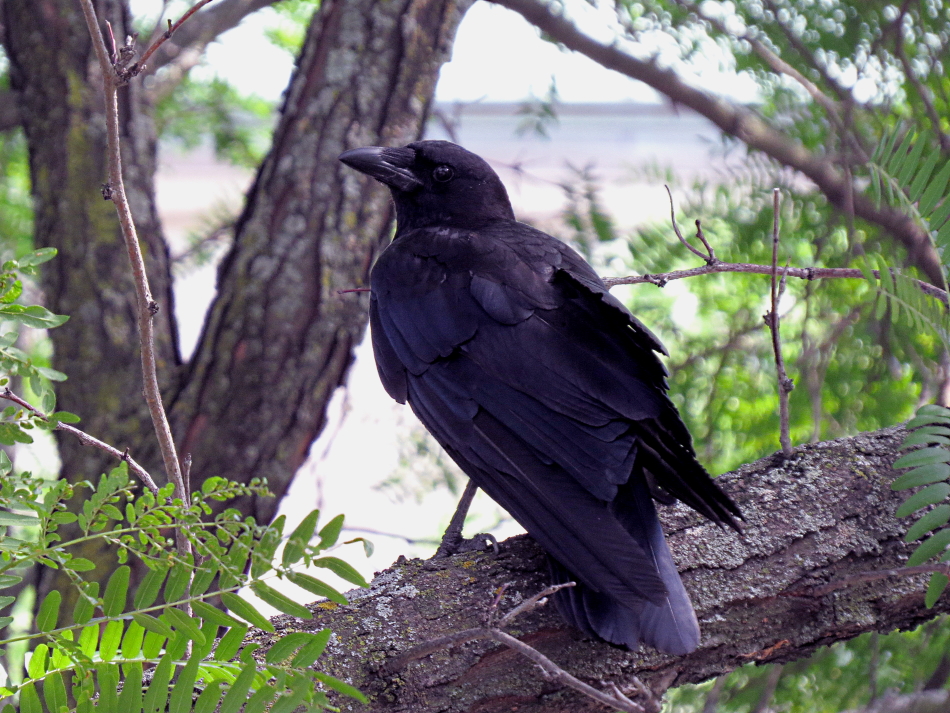
Photo credit: John Whelan, Ottawa Beatles Site
Blackbird is an emotional and
controversial song from The White Album, by the English
band The Beatles, which was recorded on June 11, 1968 in
London, written and performed by Paul McCartney,
produced by George Martin with Apple Records.
It is an acoustic piece, which in
its composition has in the background the recording of
the song of a blackbird, known as the poet of the
darkness of the night in the world of birds, and the
harmony of a guitar inspired by the musical notes of a
Bach classic, entitled Bourrée in E minor. In addition,
the beat of this melody is set by a rhythmic tapping
against the floor of McCartney's foot, a special touch
by the author.
"Blackbird singing in the dead of
night, take these broken wings and learn to fly, all your
life, you were only waiting for this moment to arise".
This fragment of the song refers
to a metaphor about a woman of black complexion who longs
for her freedom, in the midst of a society full of
prejudice and inequality, and who regardless of the
damage caused can continue to dream. It also alludes to
the struggle of the black community against racism and
the search for access to civil rights and equality before
the law.

In this regard, it is worth
mentioning that the reason why McCartney decided to
write this song comes from the Little Rock crisis in
Arkansas (United States), an event considered the most
significant in the civil rights movement, because the
south of this country managed a segregation in the
educational field, in which blacks and whites were
separated.
This became evident on September
4, 1957, when a group of nine African-American students
attempted to enter Little Rock Central High School and
the Arkansas National Guard prevented their entry with
the excuse of protecting its citizens. A few days later
the federal district judge, Ronald Davis, ordered the
troops to be withdrawn and the students were allowed to
enter, which was the trigger for McCartney to give a
voice of freedom.
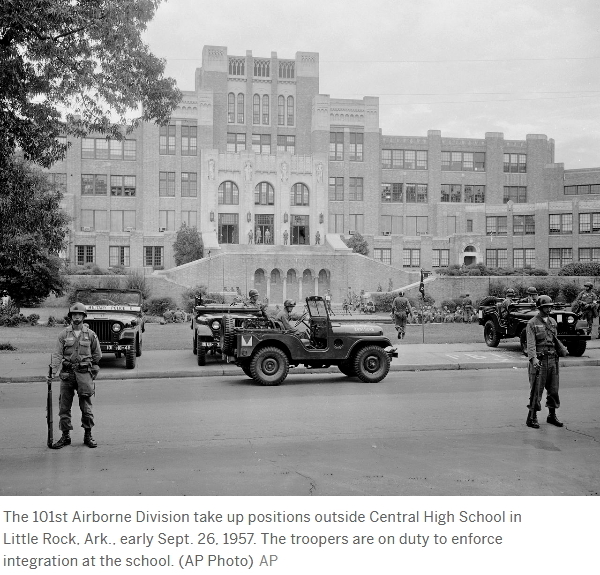
Well, it would seem from the above
that the composer wanted to send a message of empathy
and solidarity with all those people who were going
through a time of difficulty and discrimination because
of their skin color.
From this, I consider that the
singer had the intention of transmitting faith, hope and
support to the constant struggle for civil rights, which
was being lived at that time, also it can be noted that
he wanted to be the spokesman for part of the black
population that could not be heard.
In addition to this, I think he
makes a connotation to the union, which is expressed in
the sound of his guitar, using as a reference the
classic Bourrée in E minor, as I said before. This is a
musical example of counterpoint, which is a relationship
between two or more voices that seek harmonic balance,
this used as a symbol of peace and equality between
blacks and whites, which McCartney wanted to imply.
Finally, it is important to say
that it is a song that, from the simplicity of its
composition in terms of lyrics and melody, manages to
have a transcendental meaning to this day, because after
the ideal and example of life of Nelson Mandela, by
fighting until the end to put the entire black race at
the level of whites and to assert their rights,
generated an impact and social awareness, about his
dream of freedom, which can be seen embodied in
Blackbird, saying that although your wings are broken or
have suffered, you can still fly, dream and think of a
better future.
End of article.
Ottawa Beatles Side editorial: Listen to the late great Billy Preston do his fantastic cover version of "Blackbird."
Ottawa Beatles Site RetroGroove with George Harrison's "Isn't It A Pity"
Make no mistake, if you haven't heard the "All Things Must Pass" album in its entirety, you are missing out on the monumental folk-rock album of the entire 1970's decade. Having listened to this album for many decades now, I can compare this bodied work as good as Paul Simon's material. With hits like the Beatles's "Something" and "Here Comes The Sun" from Abbey Road, both written by George along with the songs from "All Things Must Pass" placed George on the same level of greatness like Lennon and McCartney.
If ever there was a double A-sided single, then it was George Harrison's "My Sweet Lord" and "Isn't It A Pity." And to drive that point home, here in Canada the single had both "formatted A side Apple labels printed" on either side, meaning the sliced Apple for the B-side was not included.
Said George Harrison on the meaning behind the song: "‘Isn’t It A Pity’ is about whenever a relationship hits a down pint – instead of whatever other people do (like breaking each other’s jaws) I wrote a song. It was a chance to realise that if I felt somebody had let me down, then there’s a good chance I was letting someone else down. We all tend to break each other’s hearts, and not giving back – isn’t it a pity." ─ from George Harrison's official book "I Me Mine."
George Harrison's "Isn't It A Pity" became a template for my creative juices back in 1975 when creating a lyrical response similar in style to George's composition. The lyrical poem that I wrote is called "Of Heavenly Blue" which is presented below this report.
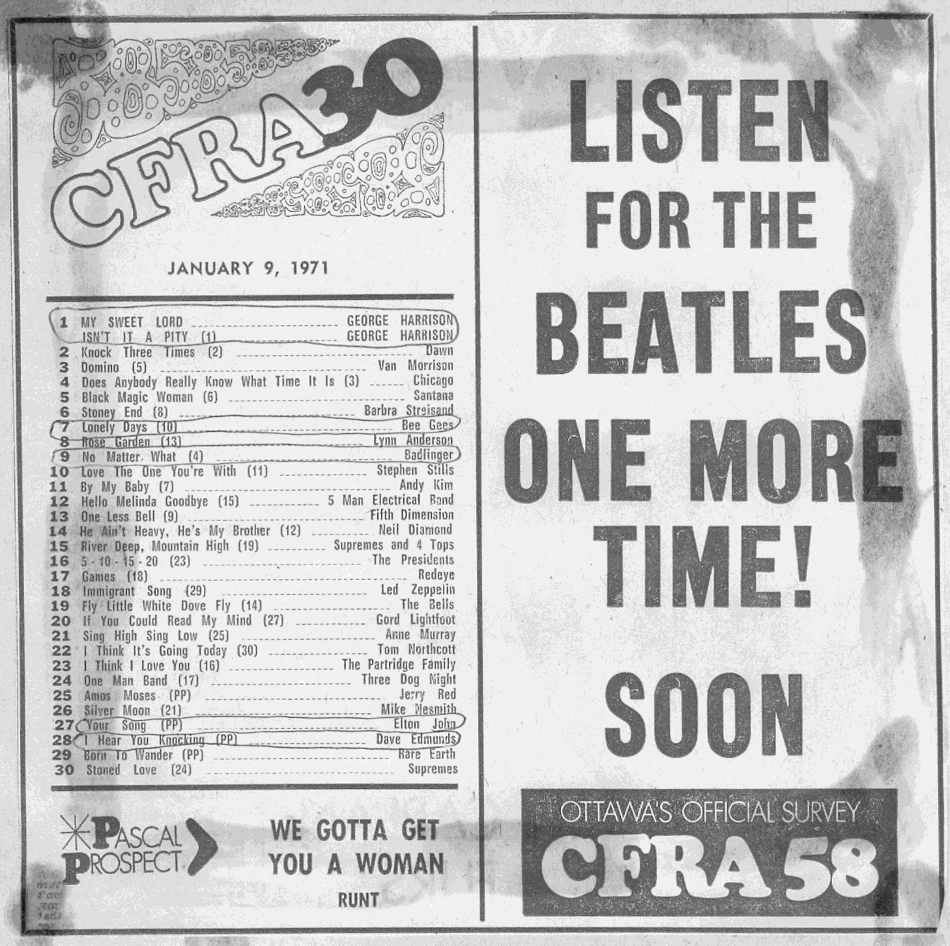
From my personal scrap book (with glue bleed-through after all these years), the Ottawa Citizen publishes the CFRA Hit Parade for January 9, 1971. George Harrison's double hit single "My Sweet Lord" and "Isn't It A Pity" is still in the coveted #1 slot. "I Hear You Knocking" by Dave Edmunds makes its debut which John Lennon referred to as a great rocker in "Lennon Remembers" by Jann Wenner
"Of Heavenly Blue"
by John Whelan (to the tune of "Isn't It A Pity")
How do I explain my undying love for you?
It is more trying love for me than for you.
Unfolded as I remain love,
I feel indifferently the same love.
All the love that you hold,
Is worth waiting for the new day.
All the love that you hold,
Is worth waiting for when given away.
Would you believe that I'm growing in love with you?
That I'm knowing all the love within you?
As I bathe my eyes in tears love,
Cleansed is the pain of lonely years love.
All the tears that I hold,
I hold in my hand for you.
All the tears that I hold,
Is a cloudburst of heavenly blue.
Of heavenly blue.
Of heavenly blue.
Of heavenly blue.
Lyrics are copyrighted by John Whelan, "Mirrors of a Rogue" poetry collection, 1975.

Archived news:
July 2000 - June 2003
July 2003 - December 2003
January 2004 - October 2004
October 2004 - May 2005
May 2005 - June 2005
July 2005 - November 2005
December 2005 - March 2006
April 2006 - June 2006
June 2006 - July 2006
August 2006 - September 2006
October 2006
November 2006 - December 2006
January 2007 - June 2007
June 2007 - March 2008
March 2008 - July 2008
August 2008 - September 2008
October 2008 - July 2009
August 2009 - November 2009
December 2009 - August 2010
September 2010 - December 2010
Jannuary 2011 -
December 2013
January 2014 - June 2019
June 5, 2019 - November 2019
December 2019 - October 2020

